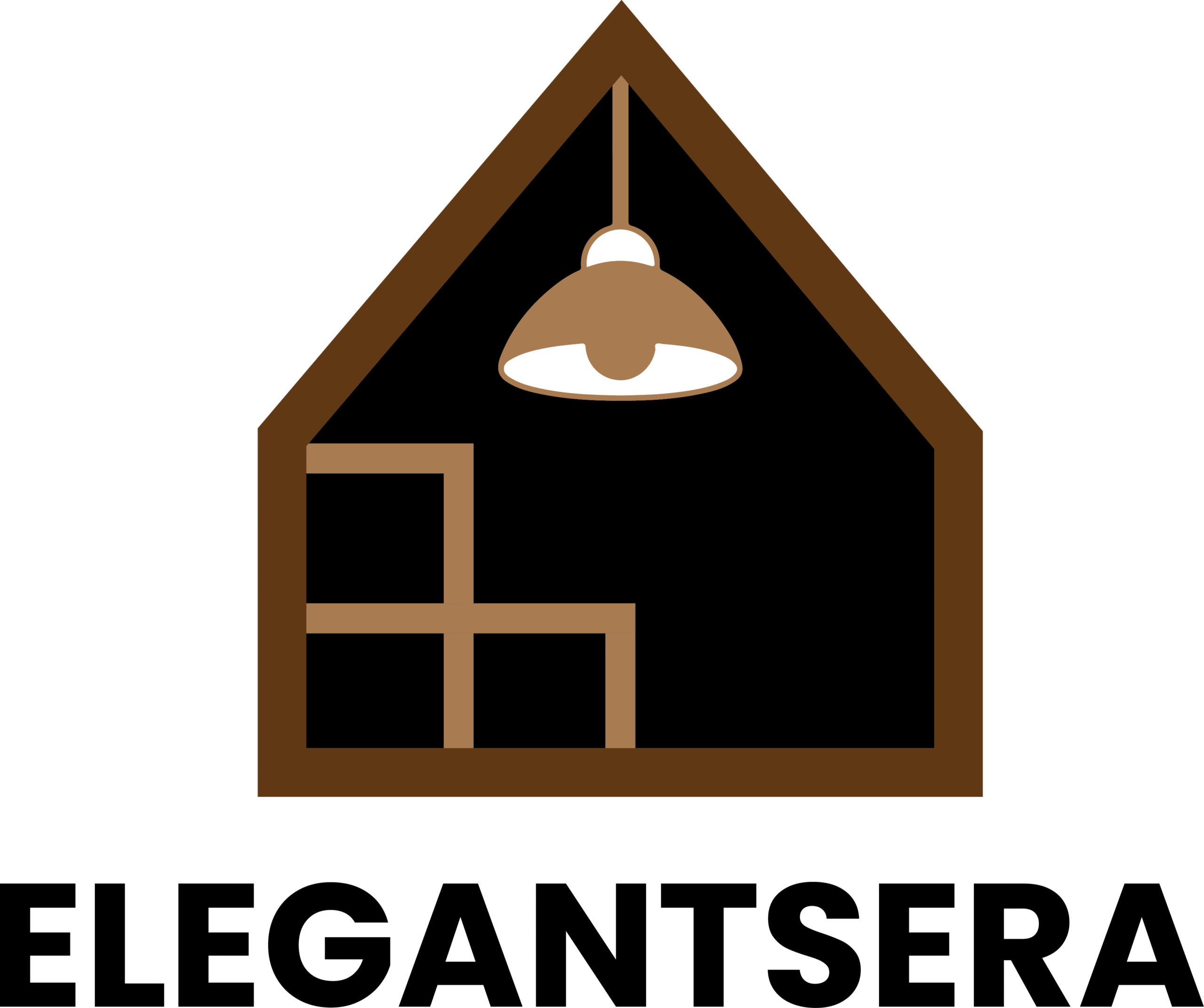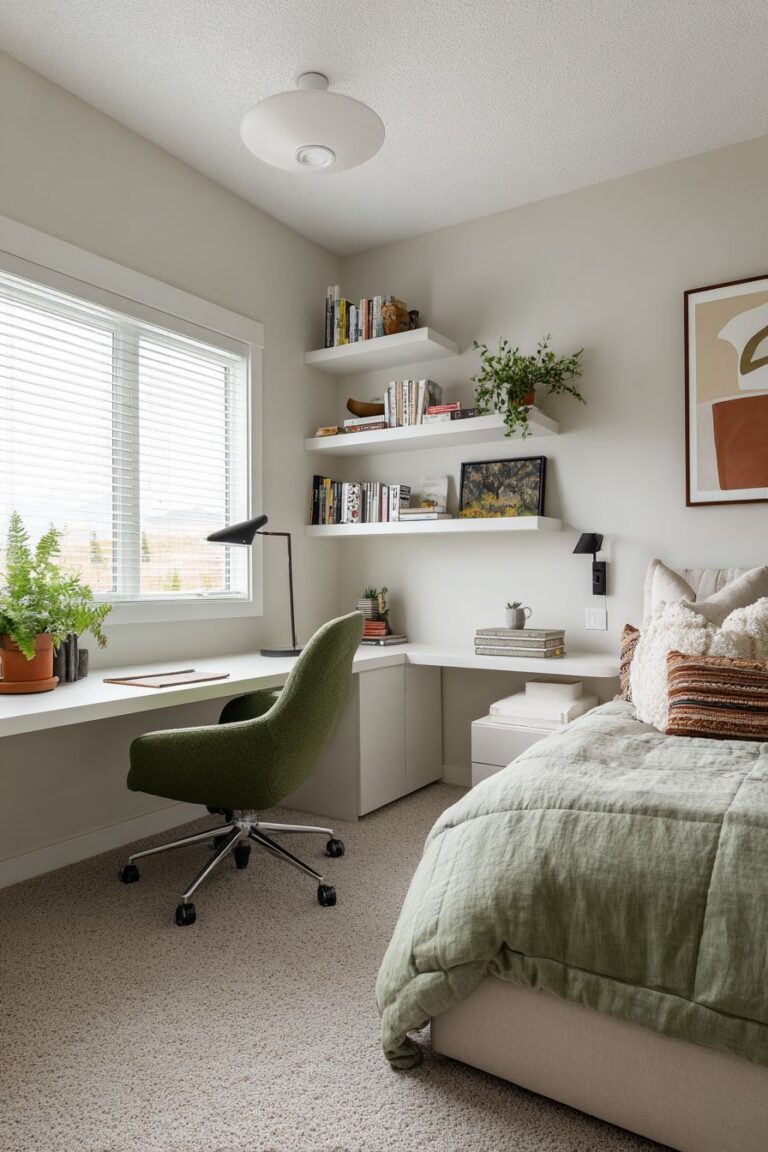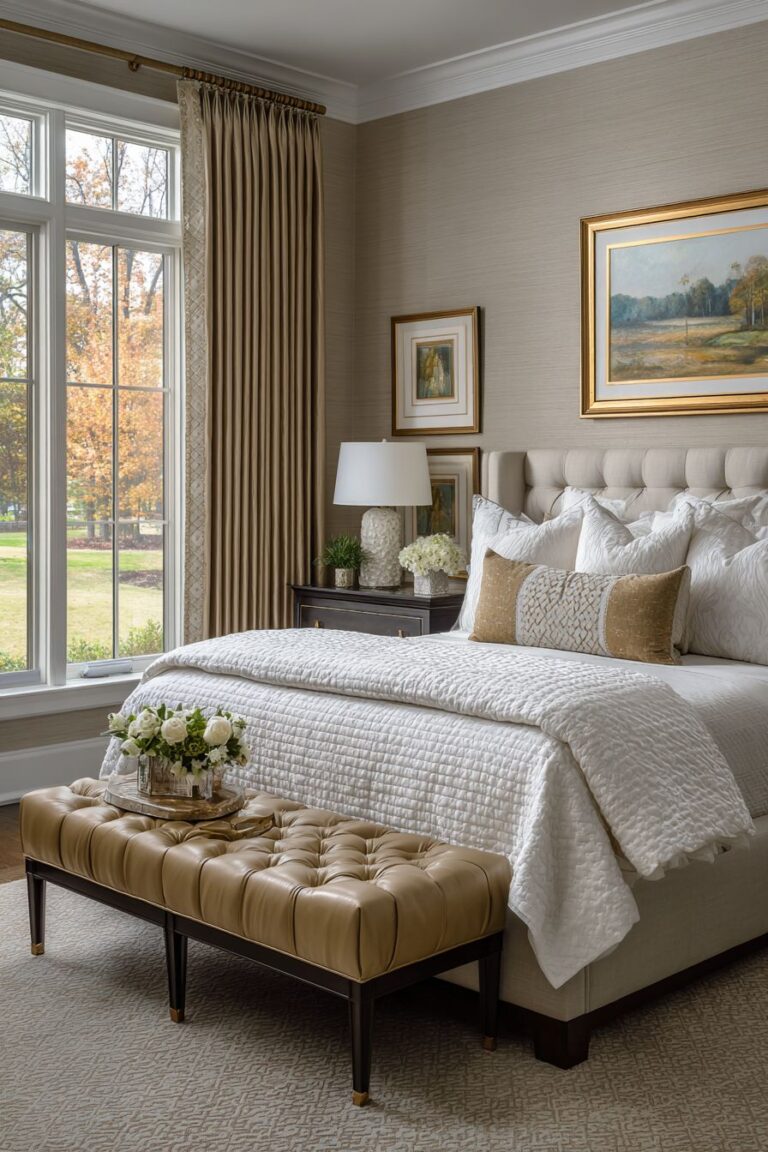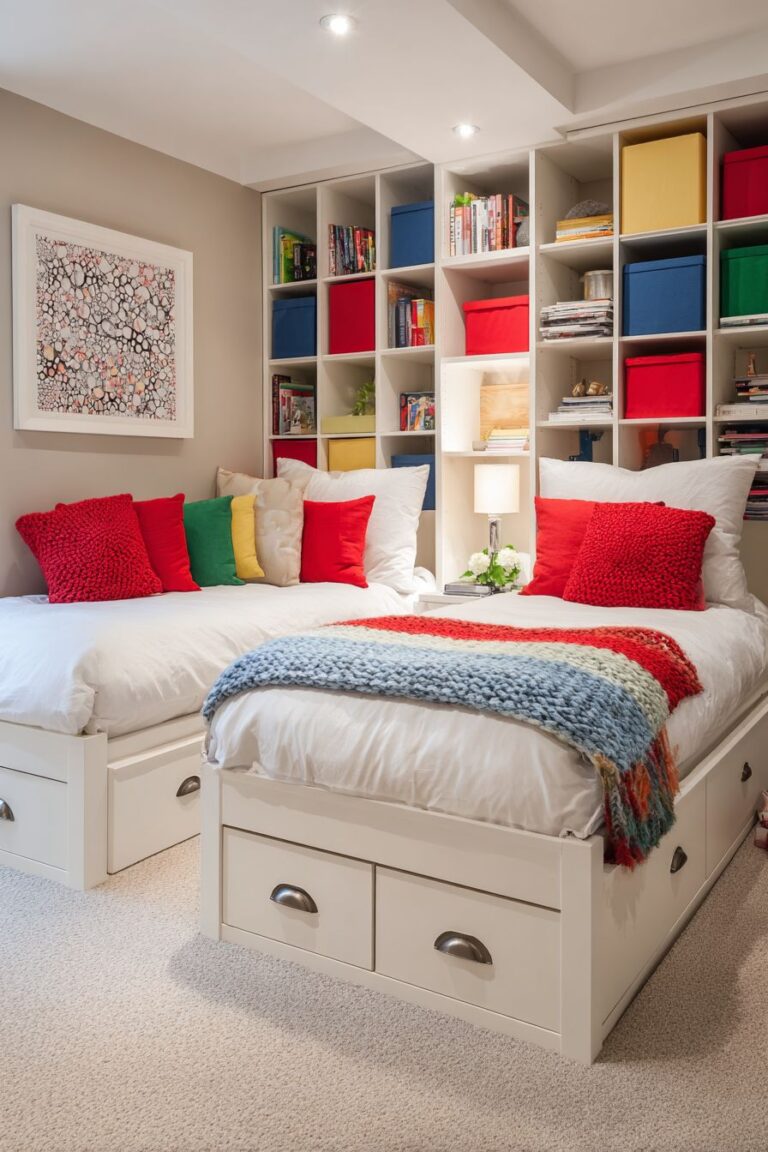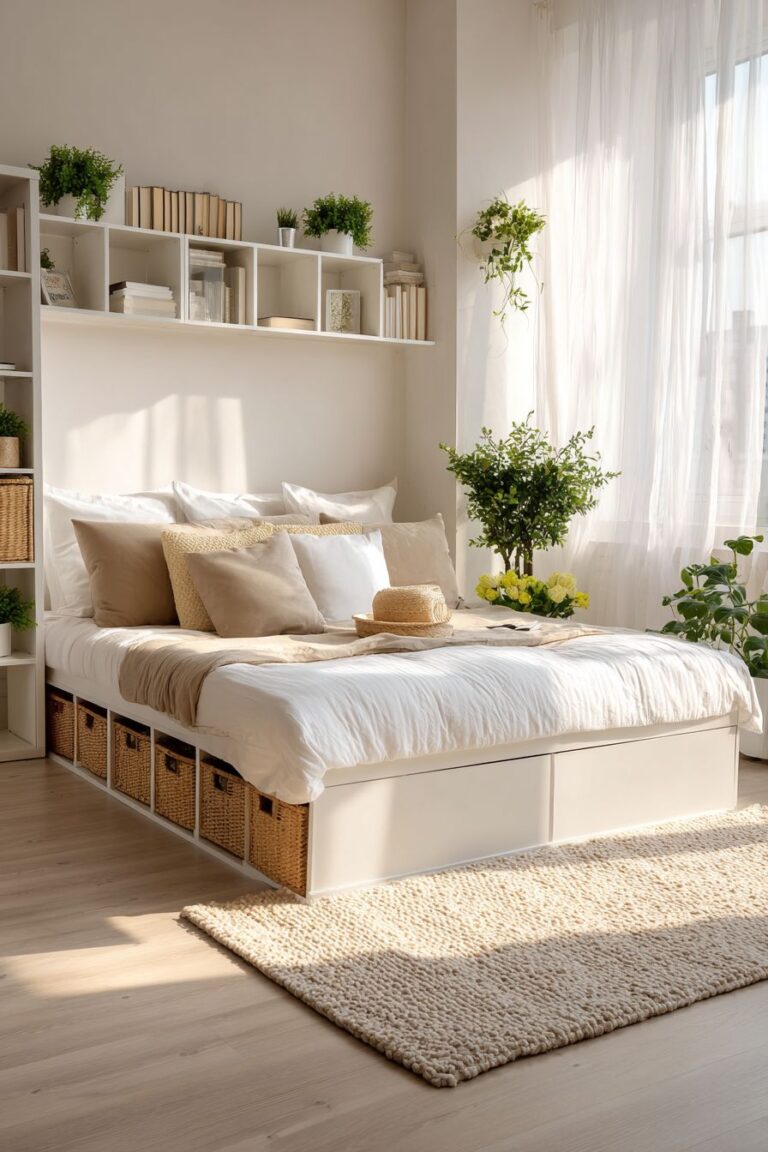20 Stunning Dark Rustic Bedroom Ideas: Designs to Transform Your Space
The bedroom stands as a personal sanctuary, a refuge from the demands of daily life where design transcends mere aesthetics to create an atmosphere of genuine tranquility. In the realm of interior design, few styles evoke the powerful combination of warmth, authenticity, and sophisticated moodiness quite like the dark rustic bedroom. This design approach marries the raw, organic beauty of natural materials with deeper, more dramatic color palettes, resulting in spaces that feel both grounding and luxurious. The careful balance between weathered textures, rich wood tones, and atmospheric lighting creates an environment that invites rest while making a bold design statement.
The dark rustic aesthetic represents a departure from the bright, minimalist trends that have dominated recent years, instead embracing the beauty of imperfection, age, and natural patina. This style celebrates authentic materials in their most honest forms—reclaimed barn wood with visible grain patterns, hand-forged iron with its subtle irregularities, and stone displaying millions of years of natural formation. By incorporating these elements within a darker color scheme, designers create bedrooms that feel cocooning and intimate, spaces where the outside world fades away and genuine relaxation becomes possible.
Throughout this comprehensive guide, we’ll explore twenty distinct interpretations of the dark rustic bedroom, each offering unique approaches to materials, textures, lighting, and spatial composition. From dramatic four-poster beds crafted from rough-hewn timber to intimate reading nooks bathed in atmospheric shadow, these designs demonstrate the remarkable versatility of rustic aesthetics when paired with deeper tones. Whether you’re drawn to industrial-rustic hybrids, traditional cabin-inspired spaces, or sophisticated interpretations that blend vintage and contemporary elements, you’ll discover actionable insights and inspiration to transform your own sleeping quarters into a dark rustic retreat.
1. Weathered Barn Wood Sanctuary
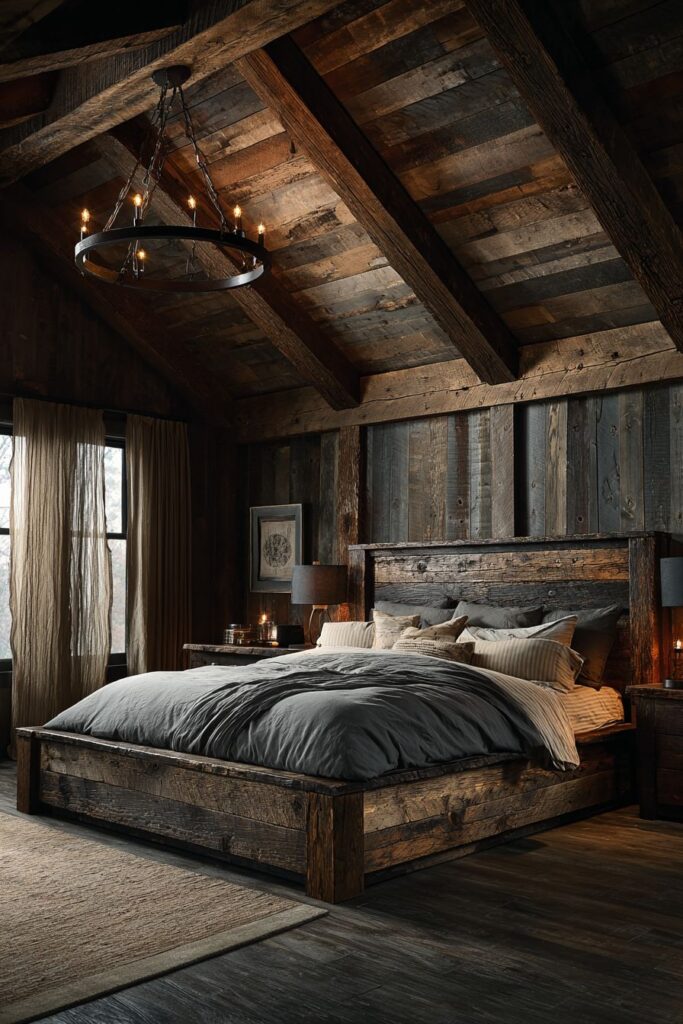
Imagine entering a bedroom where a reclaimed barn wood bed frame commands attention with its natural weathered patina in deep charcoal tones. The headboard becomes a work of art in itself, showcasing the visible wood grain and authentic knots that tell stories of decades past. Each imperfection in the wood—every crack, every variation in color—adds character and depth to the space. Paired with wrinkled linen bedding in charcoal grey and cream, the bed creates a focal point that balances rustic authenticity with modern comfort. The tactile quality of the linen complements the rough-hewn texture of the wood, creating a sensory experience that invites you to sink into relaxation.
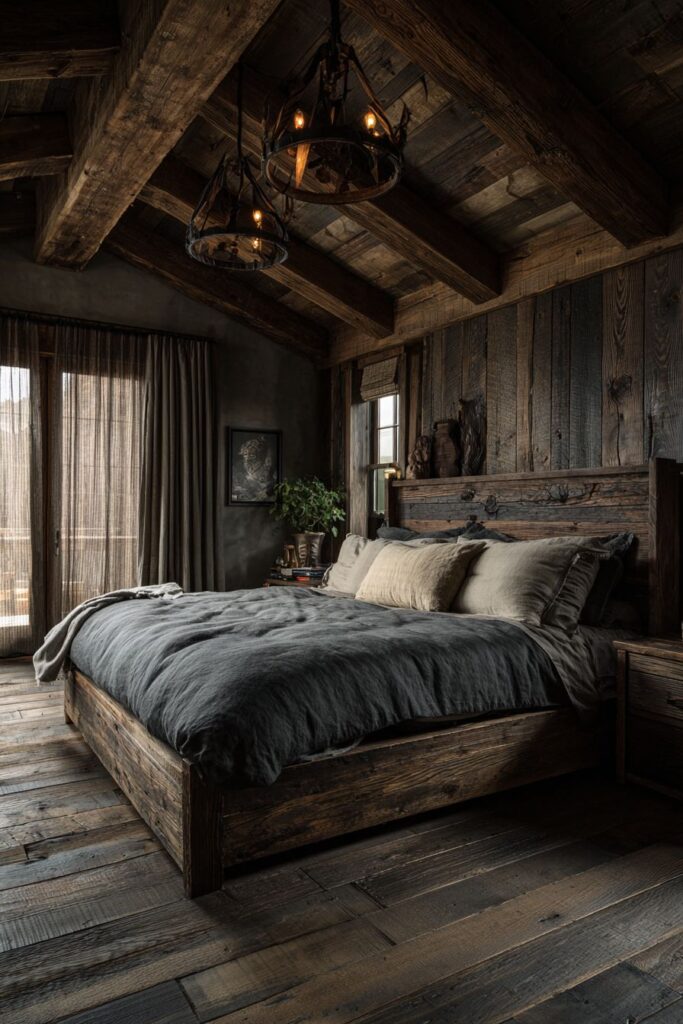
Exposed wooden ceiling beams create architectural depth overhead, drawing the eye upward and adding vertical dimension to the room. These structural elements, often left in their natural state or finished with a dark stain, contribute to the cabin-like atmosphere while providing visual interest against the ceiling plane. A vintage wrought iron chandelier suspended from these beams provides ambient lighting that casts dancing shadows across the walls, enhancing the moody atmosphere. The interplay of light and shadow becomes particularly dramatic in the evening hours, when the chandelier’s warm glow creates pools of illumination amidst the darker corners of the room.
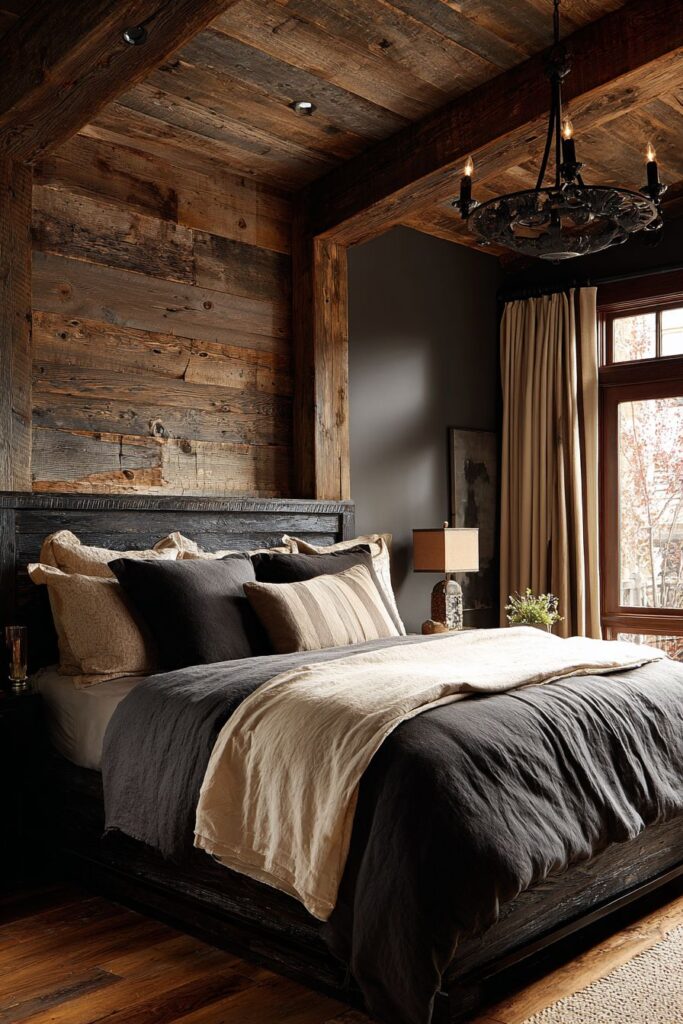
Natural light filtering through gauze curtains adds another layer of atmospheric beauty to this space. The soft, diffused light highlights the raw texture of aged wood, accentuating every groove and grain pattern while creating subtle shadows that enhance the rustic authenticity. During different times of day, the quality of light transforms the room’s character—morning sun brings out the warmer undertones in the charcoal wood, while evening light deepens the shadows and intensifies the cozy ambiance. This dynamic relationship between natural light and material texture ensures the room never feels static or dull.
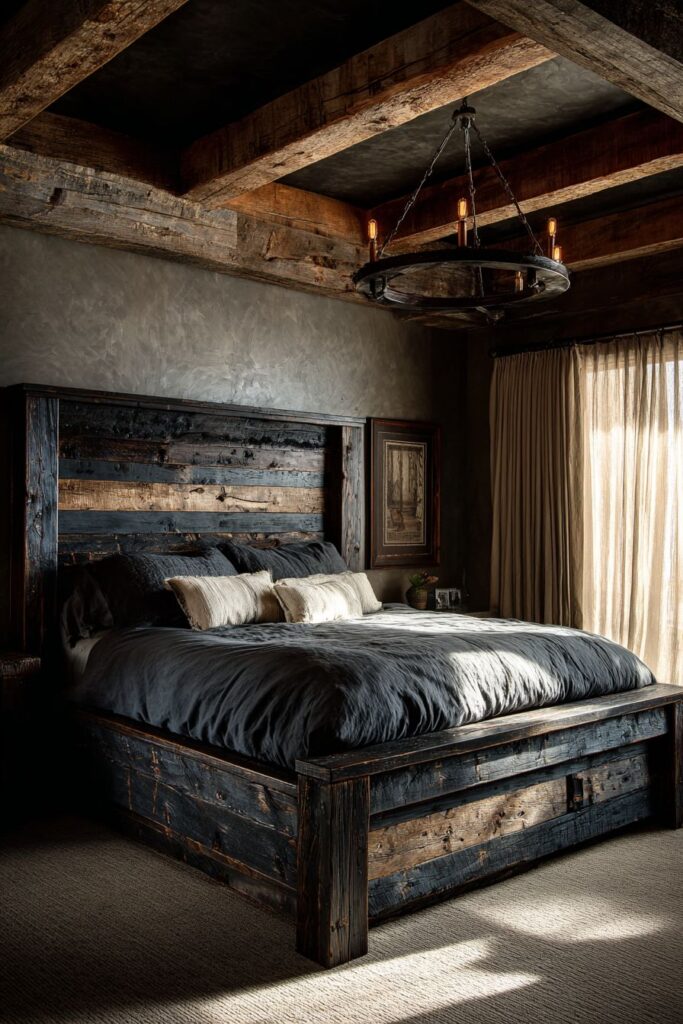
Key Design Tips:
- Select reclaimed barn wood with authentic weathering for genuine character and environmental sustainability
- Layer bedding textures by combining rough linen with soft throws to create visual and tactile interest
- Position the bed to maximize natural light exposure while maintaining privacy through sheer window treatments
- Choose wrought iron fixtures with hand-forged details to complement the organic nature of weathered wood
- Embrace imperfections in materials as design features rather than flaws to be hidden
2. Rough-Hewn Timber Four-Poster Haven
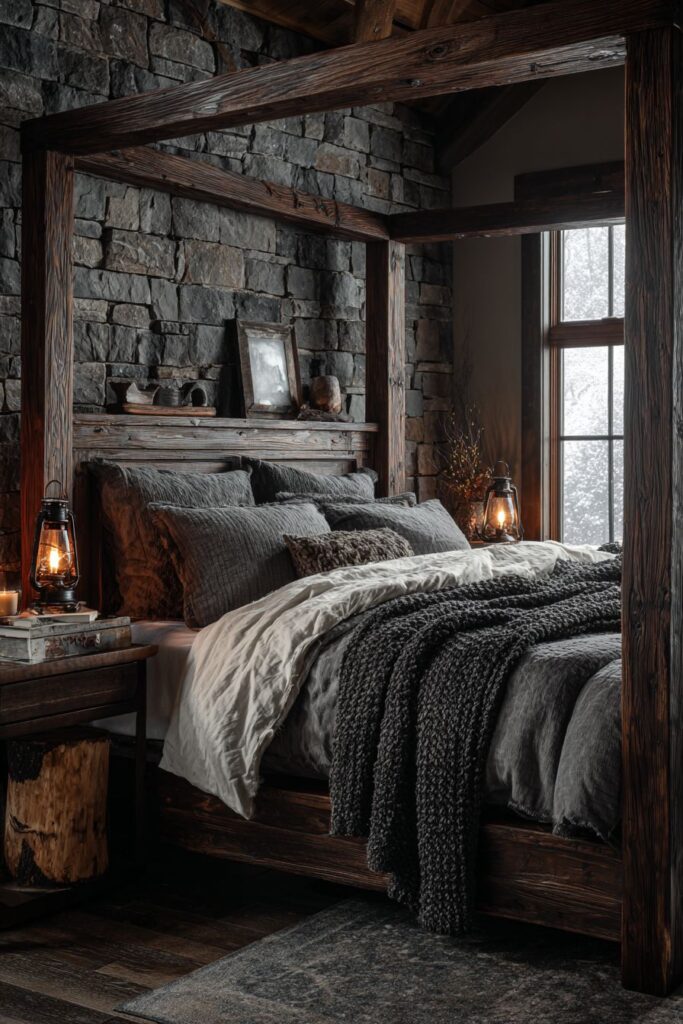
A substantial four-poster bed crafted from rough-hewn timber with a deep espresso finish establishes immediate presence in this dark rustic bedroom. The posts rise majestically from floor to ceiling, their raw surfaces showing the marks of hand-hewing tools that shaped them. Unlike polished, refined furniture pieces, this bed celebrates the authentic process of woodworking, where human craftsmanship meets natural material. The deep espresso finish enhances the wood’s natural grain while providing a rich, luxurious appearance that anchors the entire room’s color palette. Each post stands as a testament to traditional craftsmanship, creating a sense of permanence and solidity that modern furniture often lacks.
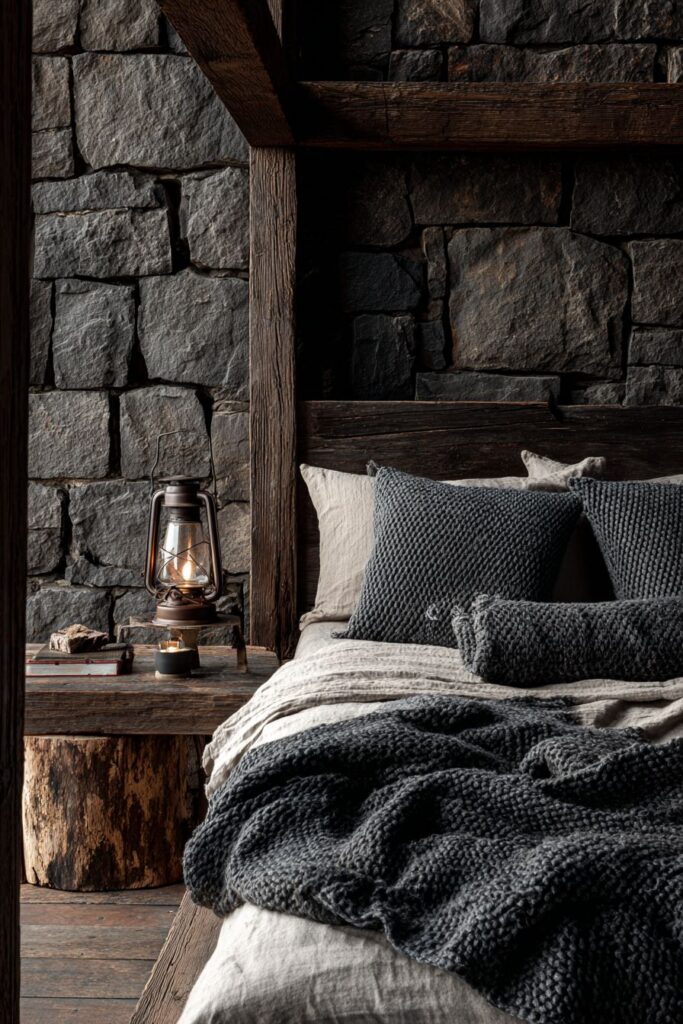
The layering of bedding creates a study in texture and comfort, beginning with wrinkled white cotton sheets that provide crisp contrast against the dark wood frame. Over these pristine linens, a chunky knit throw in slate grey adds warmth and visual weight, its thick weave creating dimensional interest and inviting touch. This thoughtful layering approach ensures the bed looks as inviting as it feels, with each textile contributing to both aesthetic appeal and physical comfort. The combination of smooth cotton, nubby knit, and the rough timber creates a rich tapestry of tactile experiences that engage multiple senses.
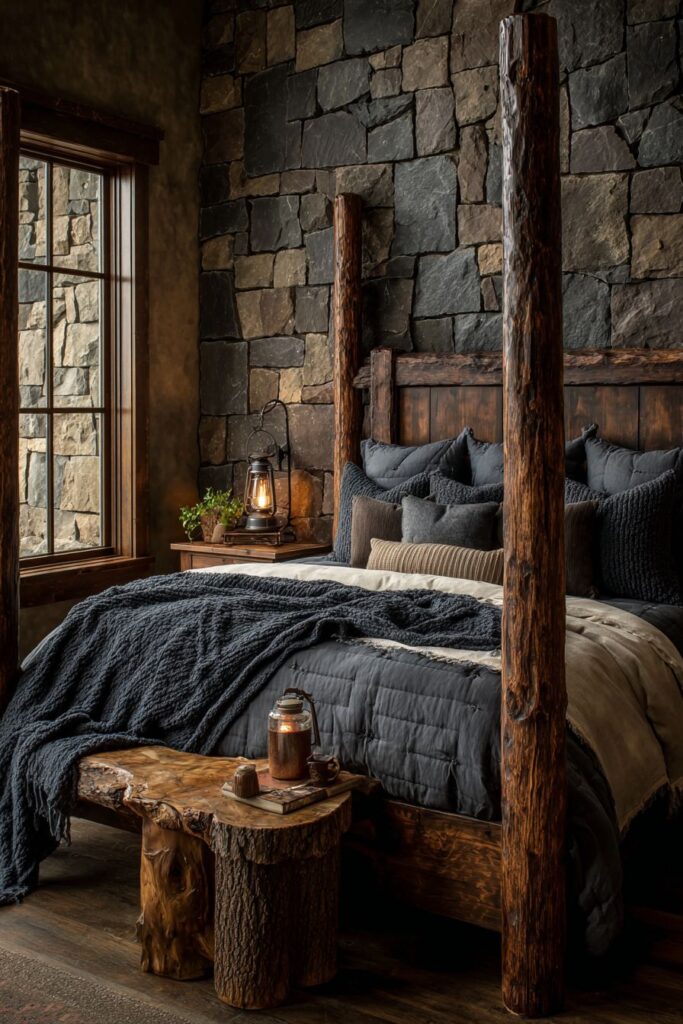
Behind the bed, a stone accent wall displays natural variation in dark grey tones with visible mortar lines that add authentic character. The irregular surface of the stone creates a textured backdrop that contrasts beautifully with the linear quality of the bed posts. Each stone tells its own geological story, with color variations ranging from slate grey to charcoal with occasional hints of brown or blue-grey. The mortar, rather than being hidden, becomes part of the design narrative, its lighter tone creating a subtle grid pattern across the wall. A bedside table made from a live-edge wood slab with visible bark remnants holds an antique oil lamp, extending the natural materials theme while providing functional surface space.
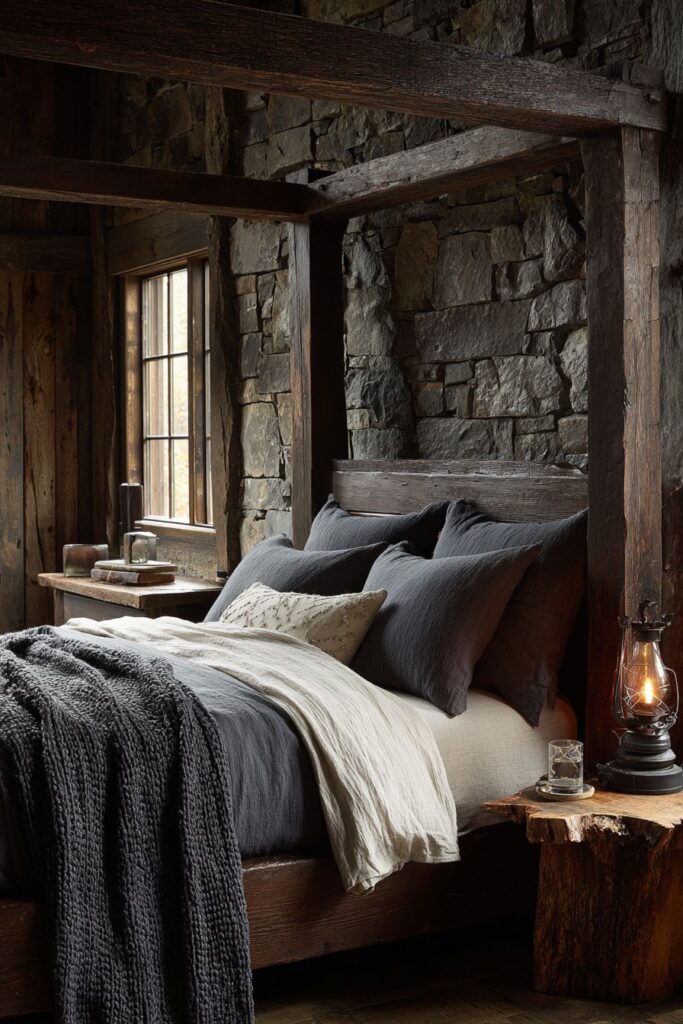
Key Design Tips:
- Invest in solid wood four-poster construction for longevity and authentic rustic appeal
- Create bedding layers that transition from light to dark tones for visual depth
- Install stone accent walls behind beds to provide texture without overwhelming the space
- Incorporate live-edge furniture pieces to maintain connection with natural wood forms
- Use vintage lighting like oil lamps as decorative accents that reinforce period authenticity
3. Built-In Wardrobe Storage Elegance
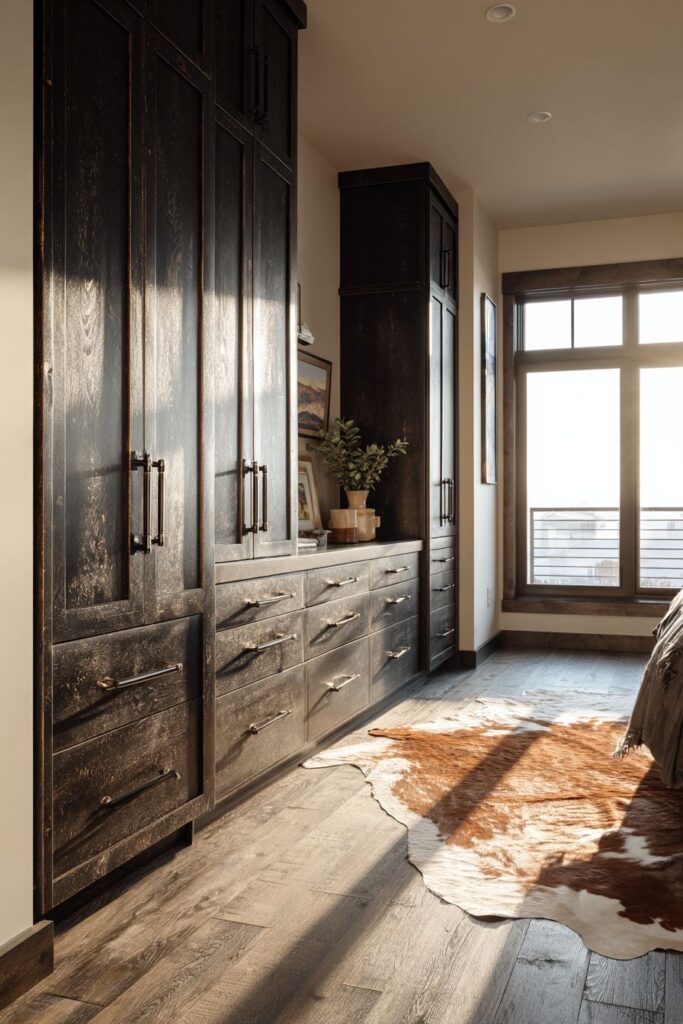
Floor-to-ceiling built-in wardrobes constructed from distressed dark walnut transform storage from necessity to design feature in this sophisticated dark rustic bedroom. The cabinet doors showcase authentic wear patterns and slight color variations across the wood grain, creating a lived-in quality that new furniture simply cannot replicate. Hand-forged iron hardware provides functional beauty, with each handle and hinge displaying the subtle irregularities that come from traditional metalworking techniques. The substantial presence of these built-ins creates a sense of permanence, as though the wardrobes have been part of the room’s architecture for generations rather than recent additions.
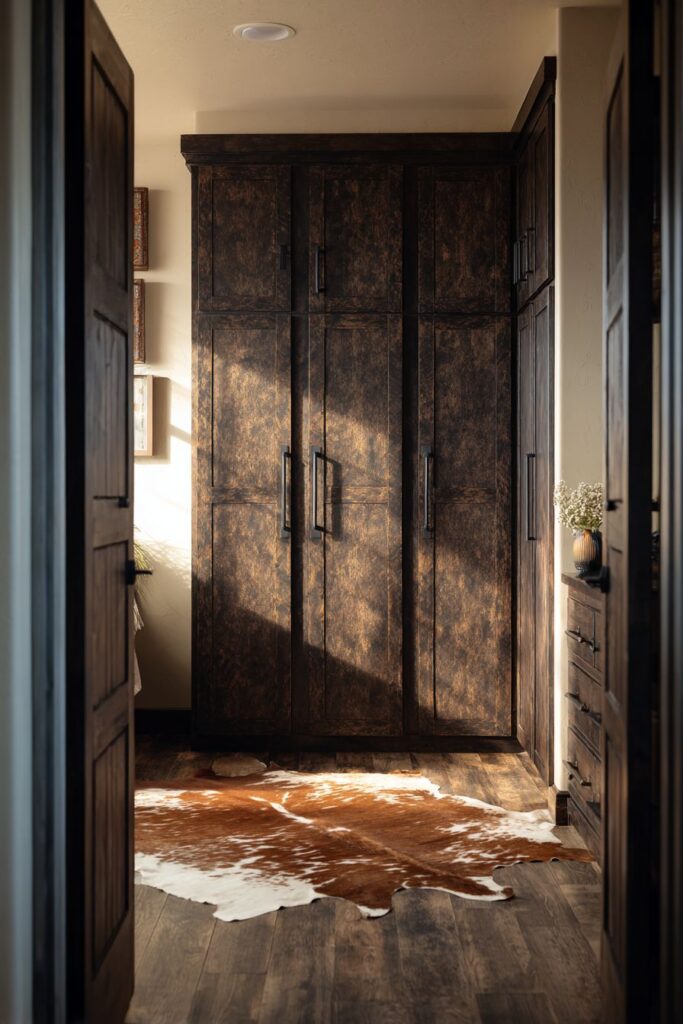
The distressing technique applied to the walnut reveals layers of finish and wood beneath, suggesting years of use and care. Unlike artificial distressing that can appear contrived, authentic wear patterns follow natural stress points—corners that would naturally experience more handling, edges that might bump against objects, surfaces where hands would repeatedly touch. This attention to realistic aging details elevates the wardrobes from mere storage solutions to focal design elements. The dark walnut tone contributes to the room’s overall moody atmosphere while providing practical concealment for clothing and personal items, maintaining the clean lines essential to a well-designed space.
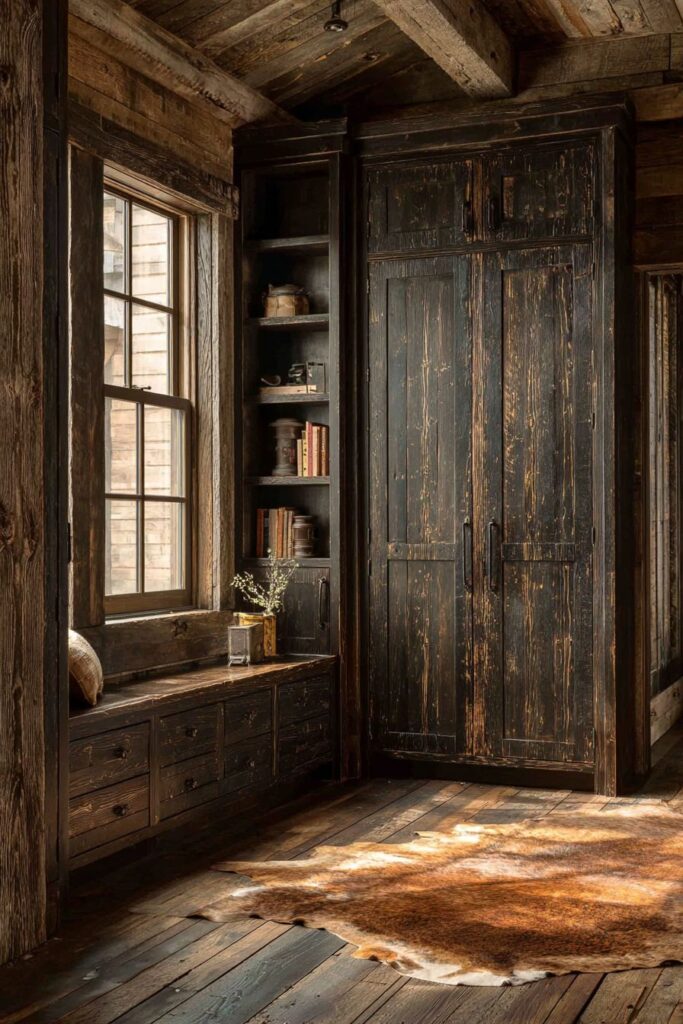
A cowhide rug in natural brown and cream tones anchors the space on wide-plank flooring with visible age marks, creating a textural foundation that grounds the room’s design. The organic pattern of the hide adds visual interest without the rigid geometry of traditional rugs, while its natural colors bridge the darker wardrobes and lighter bedding elements. The wide-plank flooring beneath shows authentic signs of age—slight variations in board width, subtle cupping, nail holes that have been filled over time—all contributing to the room’s narrative of authenticity. Morning light streaming through windows creates natural highlights on the textured wood surfaces and cast iron details, bringing warmth to the darker palette.
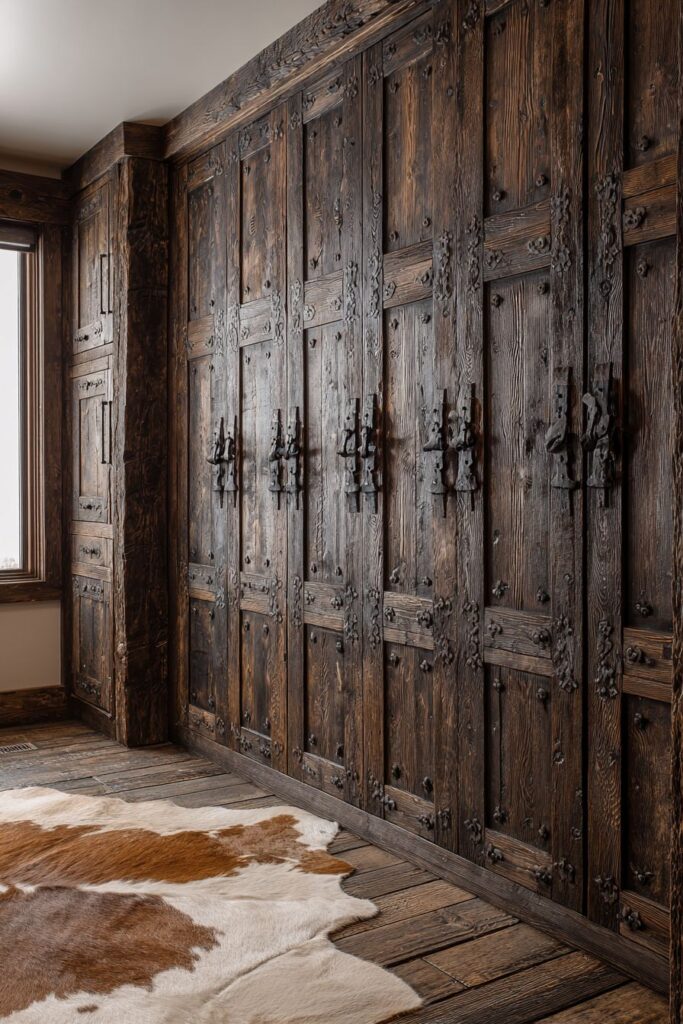
Key Design Tips:
- Design built-in storage to ceiling height for maximum functionality and architectural impact
- Choose authentic distressing over artificial aging for more convincing vintage appeal
- Install hand-forged iron hardware as jewelry for cabinetry that elevates the entire design
- Layer natural hide rugs over aged hardwood for textural contrast and warmth underfoot
- Position storage to maximize natural light reflection off hardware and wood grain
4. Intimate Reading Nook Retreat
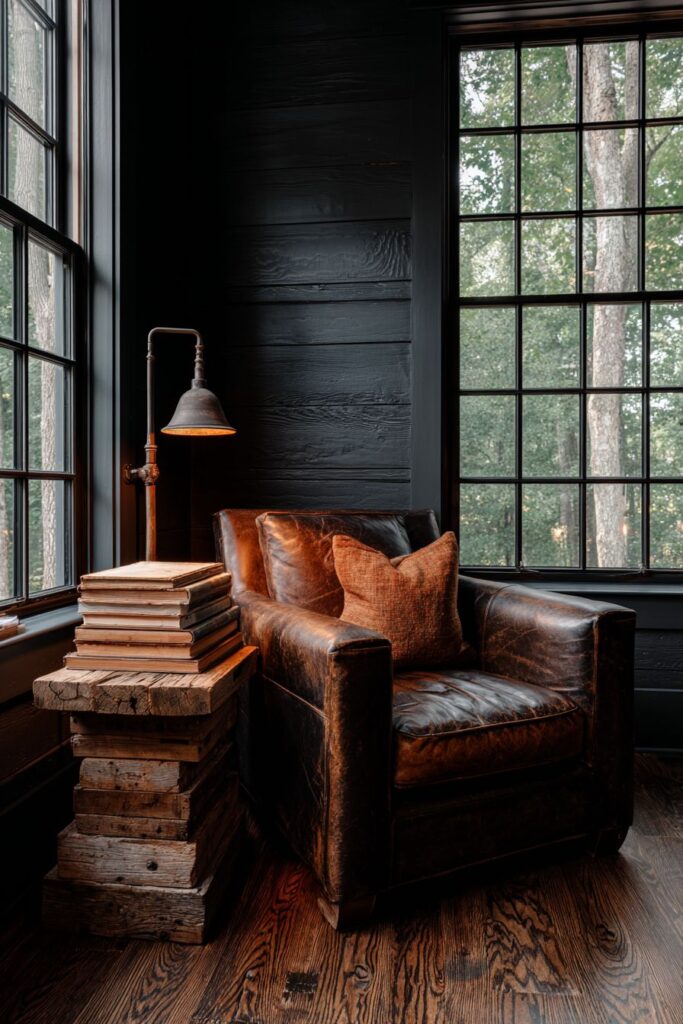
Positioned near a multi-pane window, a weathered leather armchair in deep tobacco brown creates an intimate reading nook within the larger bedroom space. The leather shows authentic patina—creases that have formed from years of use, slight color variations where sunlight has touched the surface, and the soft suppleness that only develops through time and handling. This chair becomes more than seating; it’s an invitation to pause, to settle in with a good book, to watch the world outside while remaining cocooned in comfort. The deep tobacco brown of the leather adds warmth to the space while maintaining harmony with the room’s darker rustic palette.
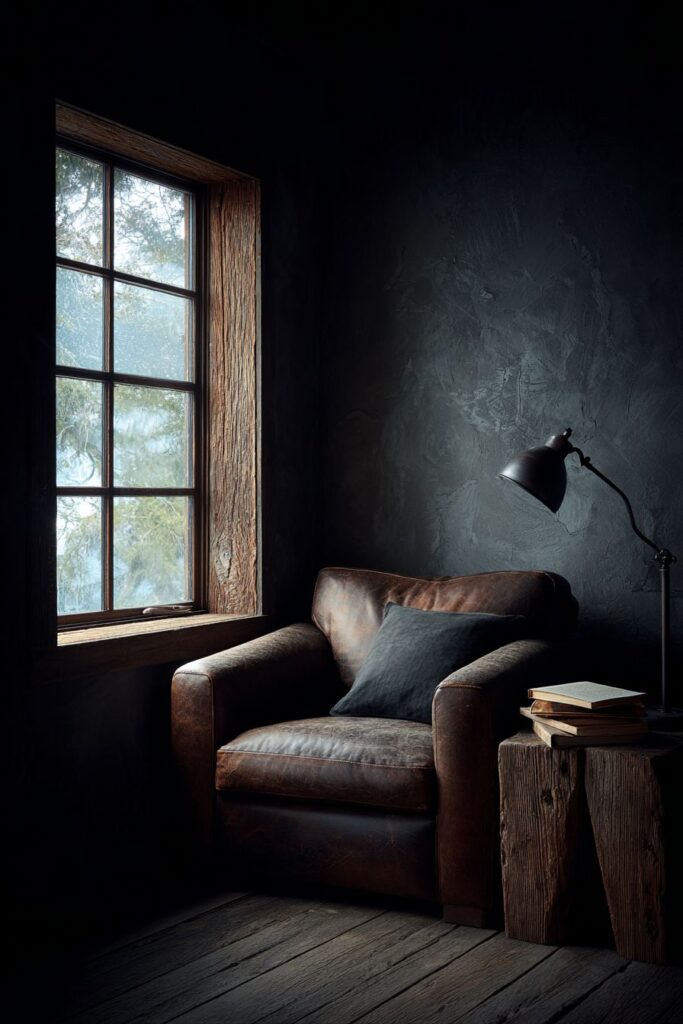
A chunky wooden side table made from reclaimed railroad ties provides a substantial surface beside the chair, its industrial origin adding historical depth to the rustic narrative. Railroad ties carry stories of journeys and connections, their weathered surfaces marked by years of supporting weight and withstanding elements. Repurposed as furniture, they bring this rich history into the intimate space of the bedroom. The table holds a carefully curated stack of vintage books, their worn spines and aged pages contributing to the room’s aesthetic, alongside a wrought iron reading lamp that provides focused illumination without overwhelming the atmospheric lighting scheme.
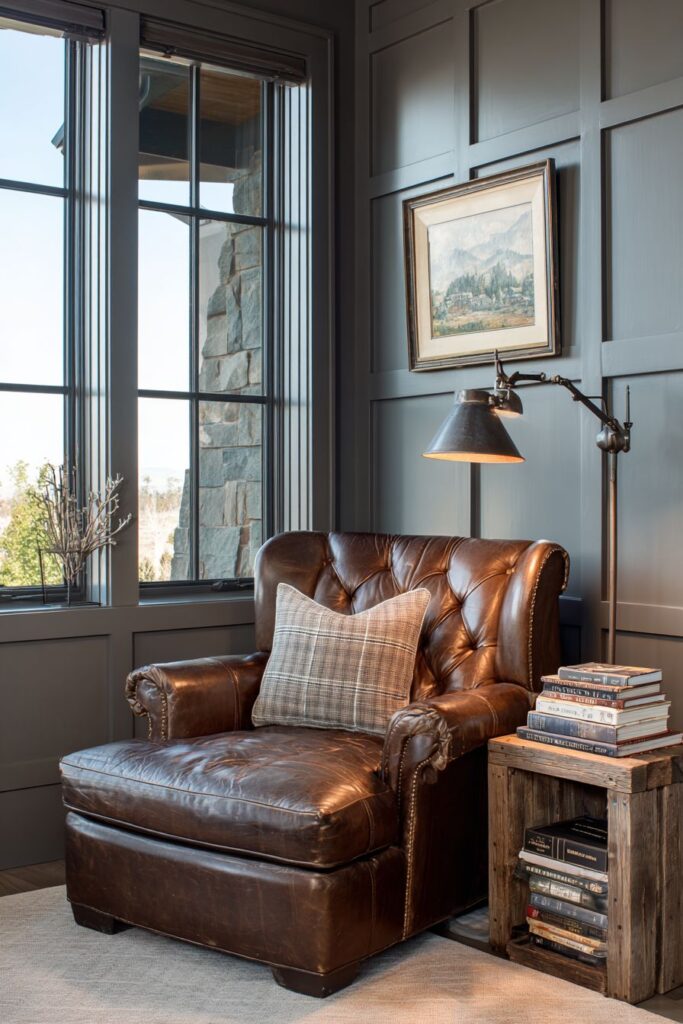
The surrounding walls feature shiplap painted in a rich charcoal grey with subtle brush strokes visible, adding another layer of texture to the space. Unlike perfectly smooth painted walls, these surfaces show the hand of the craftsman, with slight variations in paint thickness and deliberate brush marks that create depth and interest. Natural daylight streams through the multi-pane window, creating pools of light that shift throughout the day while the rest of the room remains in atmospheric shadow. This interplay between illuminated and shadowed areas creates drama and intimacy, making the reading nook feel like a secret hideaway within the bedroom.
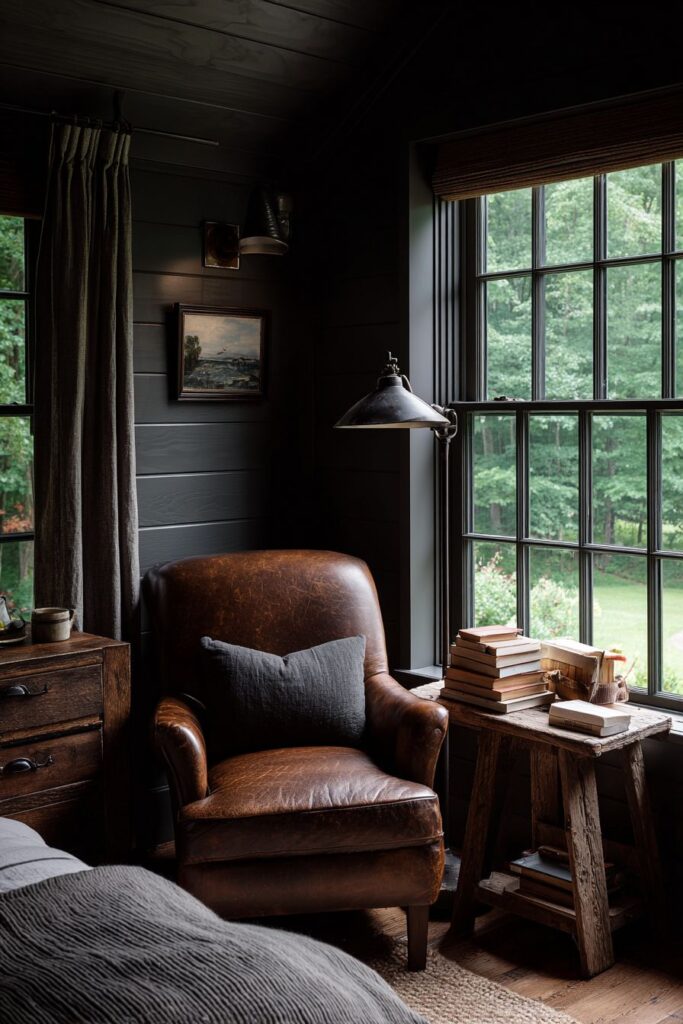
Key Design Tips:
- Position reading chairs near natural light sources while maintaining comfortable shadow zones
- Select leather furniture with authentic aging rather than artificial distressing for genuine character
- Repurpose industrial materials like railroad ties for unique furniture with historical significance
- Apply paint with visible brush strokes to add handcrafted texture to wall surfaces
- Layer lighting with both natural and focused task illumination for versatile ambiance
5. Industrial-Rustic Brick Accent
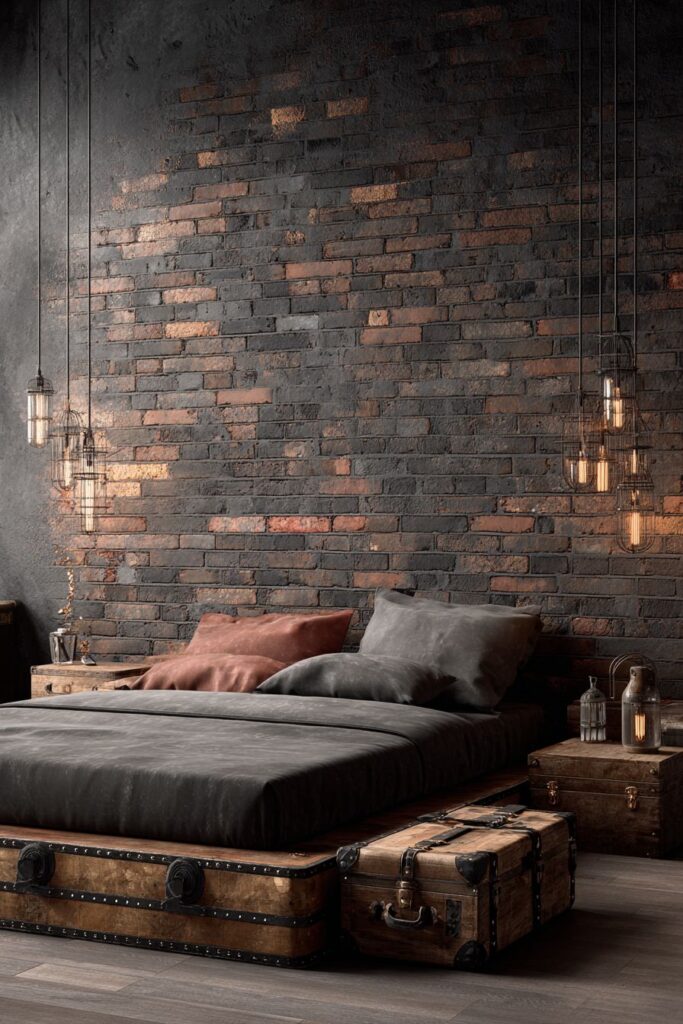
An exposed brick accent wall in varied shades of charcoal, deep red, and brown with authentic mortar texture creates a powerful focal point that bridges industrial and rustic design sensibilities. Each brick tells its own story through color variation, surface texture, and occasional imperfections—chips at corners, slight size variations, the weathered appearance that comes from age. The mortar between bricks adds to the authentic character, its lighter tone creating a grid pattern that emphasizes each individual brick while unifying them into a cohesive wall surface. This raw, honest material brings urban loft aesthetics into the rustic bedroom, creating a hybrid style that feels both grounded and edgy.
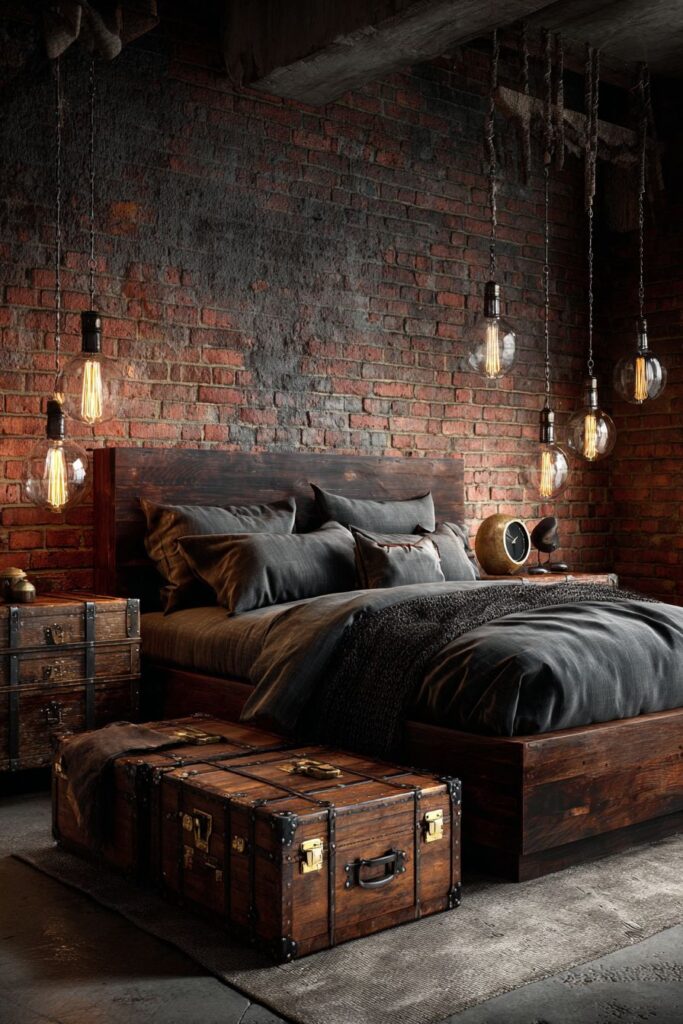
The industrial-meets-rustic aesthetic continues with a low-profile platform bed featuring a thick wooden frame in dark stain. This horizontal emphasis contrasts with the vertical nature of the brick wall, creating dynamic tension that energizes the space. The platform design offers a more contemporary interpretation of rustic furniture, with clean lines that prevent the room from feeling overly traditional or themed. The thick wooden frame provides visual weight and durability, its substantial proportions balanced by the low profile that maintains a sense of spaciousness in the room.
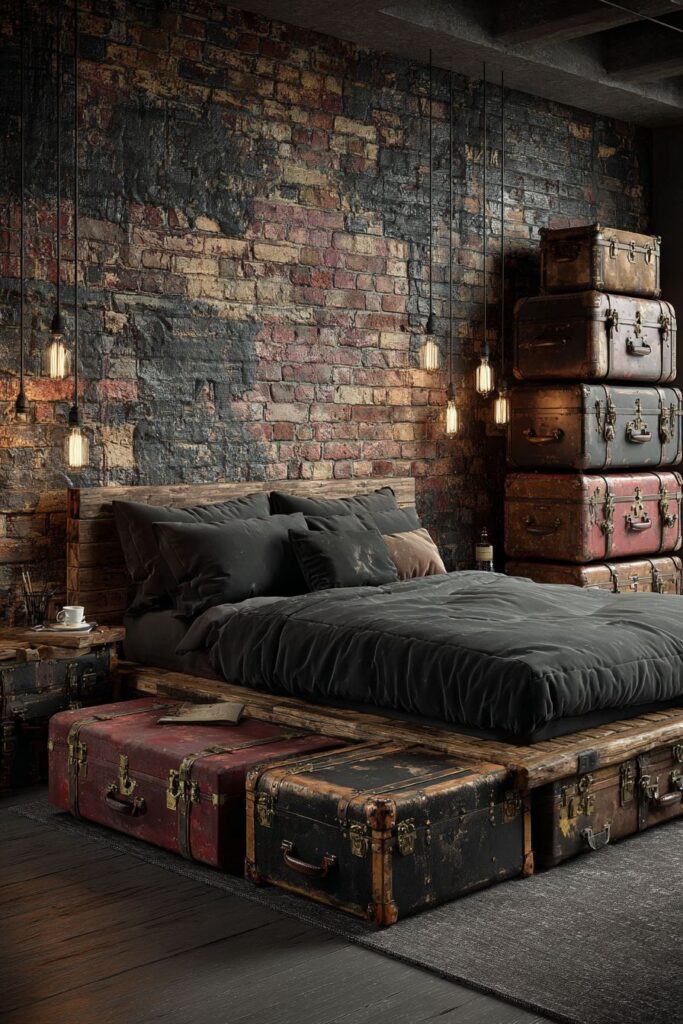
Vintage steamer trunks stacked as nightstands add functional storage while reinforcing the room’s narrative of travel, adventure, and collected treasures. The visible metal rivets, worn leather straps, and aged patina of these trunks introduce new textures and materials into the space, creating visual interest through their three-dimensional forms and surface details. Soft pendant lights with Edison bulbs cast warm pools of light that highlight the brick’s texture and create intimate zones within the larger room. The warm glow of Edison bulbs provides the perfect counterpoint to the cool tones of the brick, ensuring the space feels inviting despite its industrial elements.
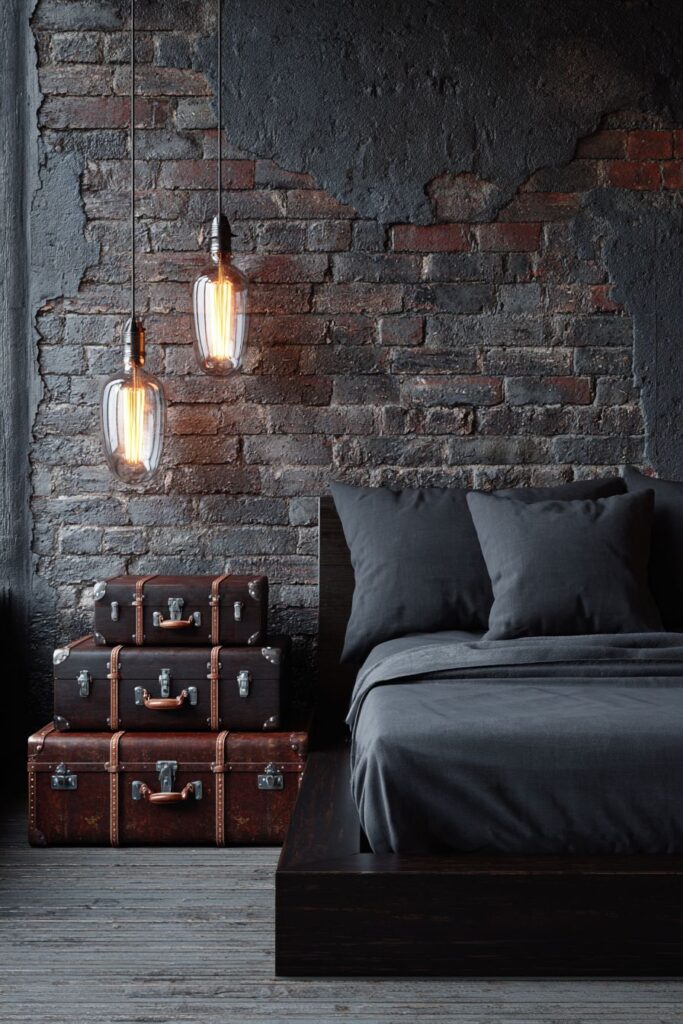
Key Design Tips:
- Expose existing brick walls rather than adding faux brick for authentic texture and character
- Balance industrial elements with warm rustic wood to prevent spaces from feeling cold
- Repurpose vintage luggage as nightstands for functional storage with narrative appeal
- Install Edison bulb lighting to add warmth and visual interest through visible filaments
- Keep bed profiles low when featuring tall accent walls to maintain spatial balance
6. Dramatic Ceiling Beam Architecture
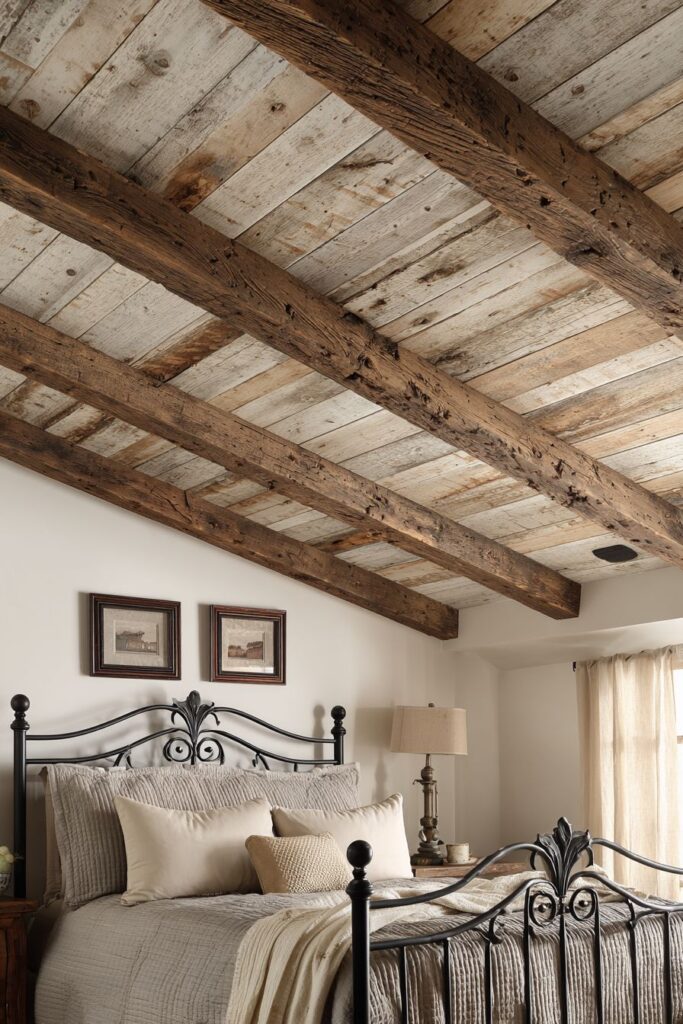
Rough-cut exposed beams in dark walnut stain with visible saw marks and natural imperfections create dramatic overhead architecture that transforms a simple ceiling into a design focal point. These beams showcase the honest beauty of working with wood—the saw marks that trace the cutting process, the slight variations in beam width, the natural checking and cracking that occurs as timber ages and settles. Rather than hiding these characteristics, the design celebrates them as evidence of authentic craftsmanship and natural material behavior. The dark walnut stain enriches the wood’s natural tones while allowing the grain pattern and texture to remain fully visible and appreciated.
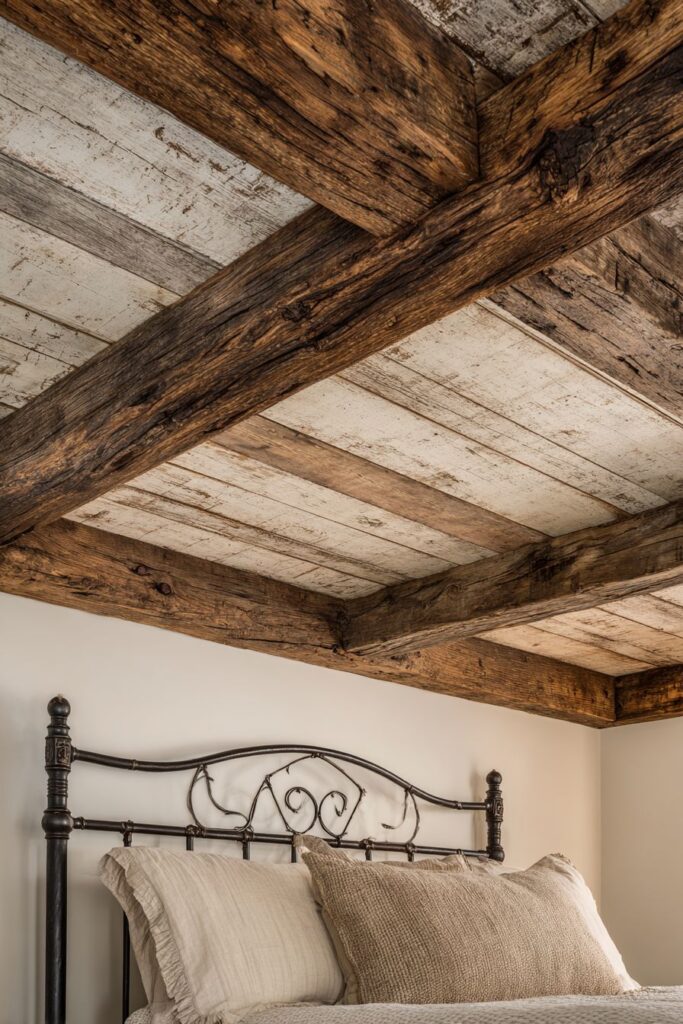
The beams contrast strikingly against white-washed planked ceiling boards with subtle wood grain texture, creating a play of light and dark that adds depth and dimension to the overhead plane. The white-wash technique allows the underlying wood grain to show through the lighter finish, maintaining textural interest while brightening the ceiling and helping to reflect light throughout the room. This contrast prevents the dark rustic aesthetic from becoming too heavy or oppressive, as the lighter ceiling creates a sense of lift and openness. The planked boards run perpendicular to the beams, their linear pattern adding directional movement to the architectural composition.
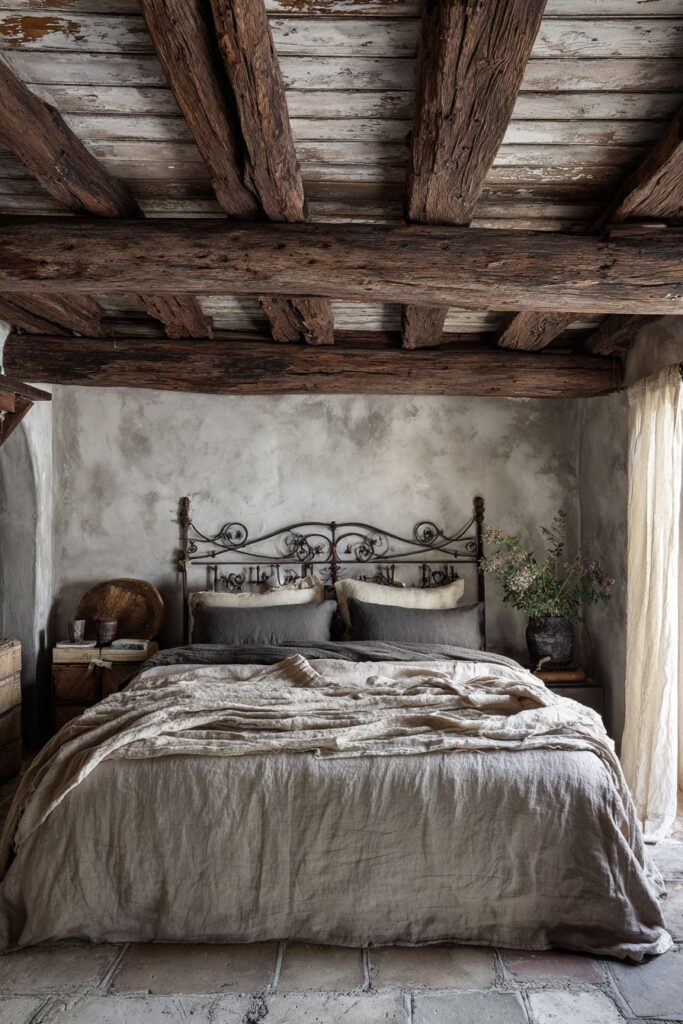
Below this dramatic ceiling treatment, a wrought iron bed frame with scrollwork details supports layers of organic linen in slate and cream. The ornate ironwork adds a romantic quality to the rustic space, its curves and scrolls providing counterpoint to the straight lines of beams and planks above. The bedding in natural linen fabrics maintains the room’s organic material palette while offering soft, breathable comfort. Natural light playing across the dimensional ceiling elements creates interesting shadow patterns that shift throughout the day, ensuring the overhead architecture remains dynamic rather than static, with changing light conditions revealing different aspects of the beams’ texture and the white-washed planks’ subtle grain.
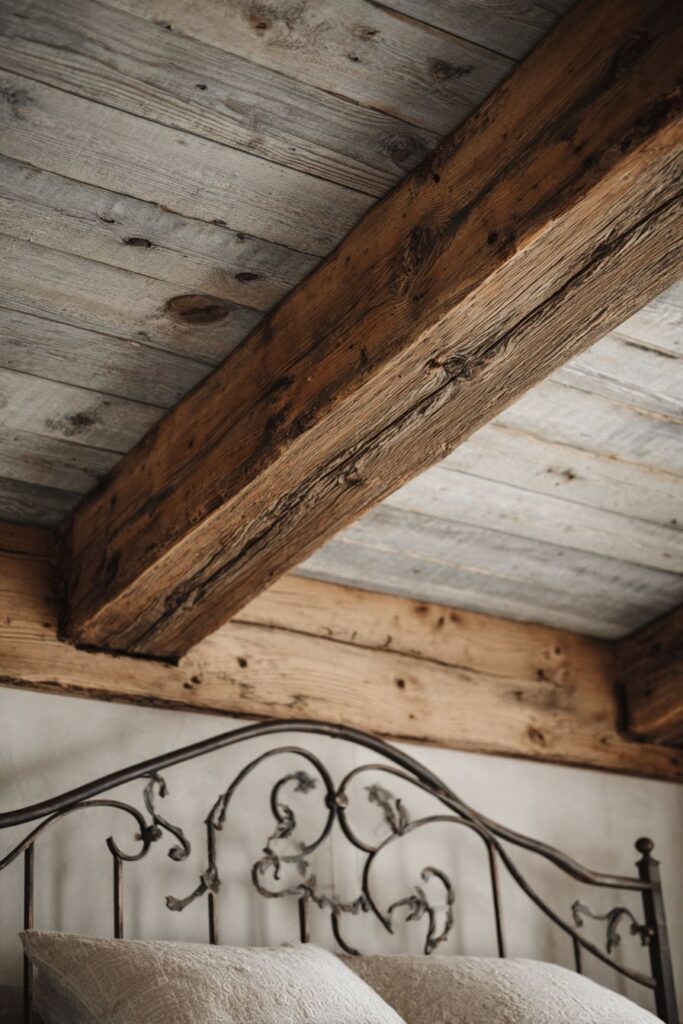
Key Design Tips:
- Select beams with authentic saw marks and imperfections rather than overly finished timber
- Create contrast between dark beams and lighter ceiling boards for dimensional interest
- Install beams following actual structural logic for authentic architectural appearance
- Choose wrought iron bed frames with handcrafted details to complement rustic wood elements
- Position beds to showcase ceiling architecture while maintaining comfortable sight lines
7. Vanity Area with Vintage Character
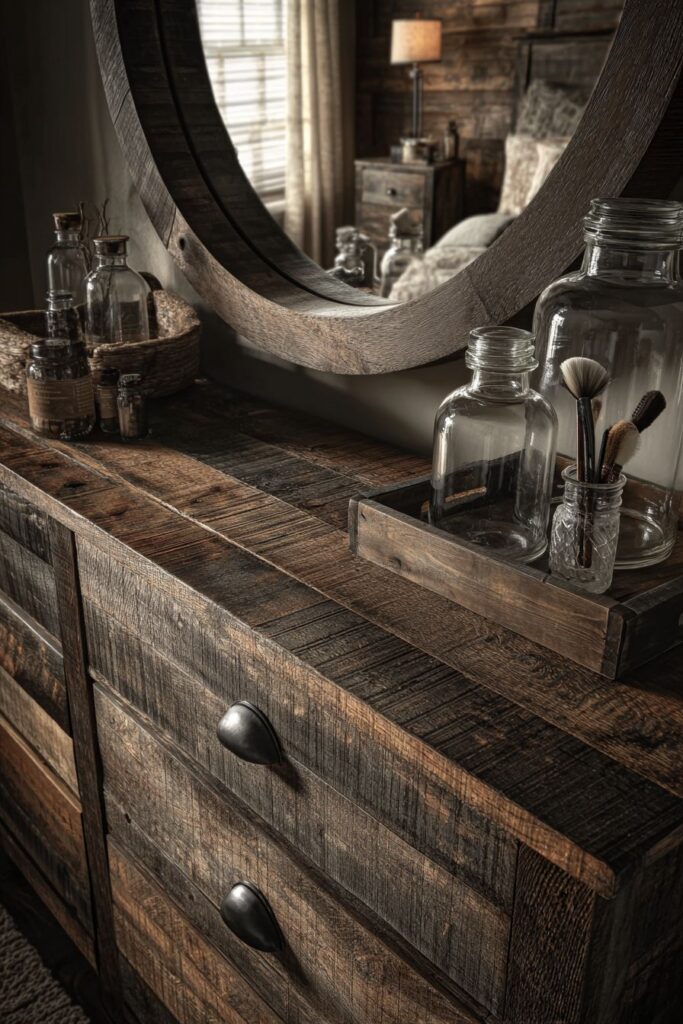
A substantial dresser made from reclaimed wood with a heavily distressed dark finish revealing lighter wood tones beneath creates a vanity area rich with history and character. The distressing technique exposes layers of the wood’s past—perhaps traces of previous finishes, the natural wood grain in its varied tones, areas where wear would naturally occur from decades of use. This multi-layered appearance adds depth and visual interest, making the dresser appear as though it has been cherished and used by multiple generations. The substantial construction speaks to furniture built to last, with solid joinery and thick planks that can withstand the test of time.
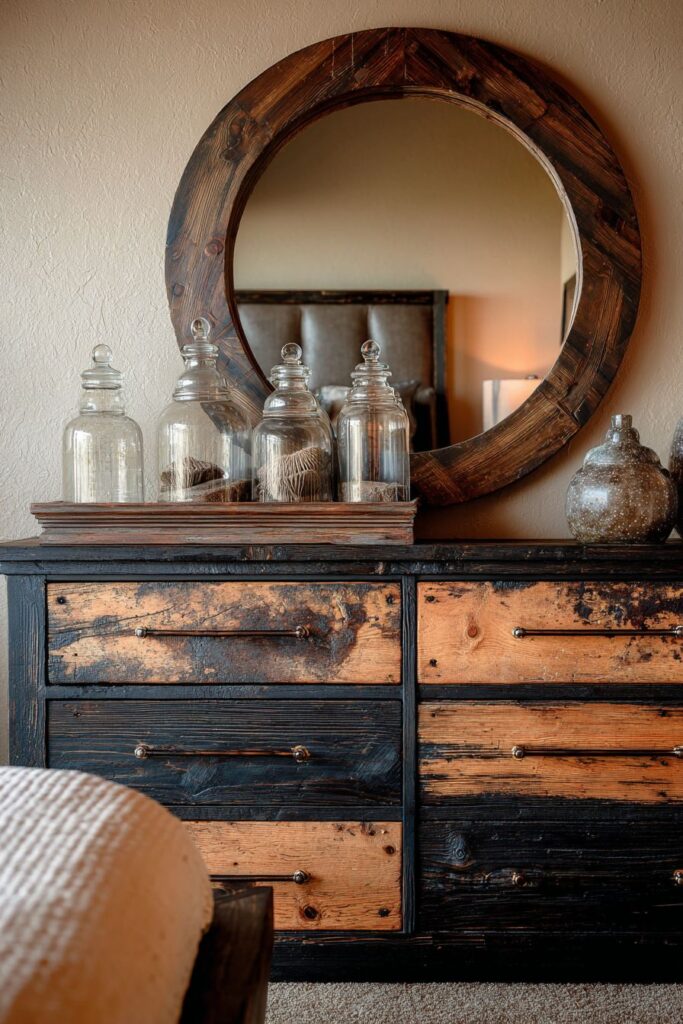
An oversized round mirror with a thick wooden frame hangs above the dresser, its generous proportions creating visual impact while serving the practical purpose of reflection. The mirror’s surface shows authentic age with slight imperfections—perhaps a barely perceptible ripple in the old glass, tiny dark spots where the silvering has degraded, or subtle clouding that speaks to years of humidity and use. These imperfections don’t detract from functionality; instead, they add character and authenticity that new, perfect mirrors cannot provide. The thick wooden frame echoes the dresser’s distressed finish, creating visual harmony between the pieces.
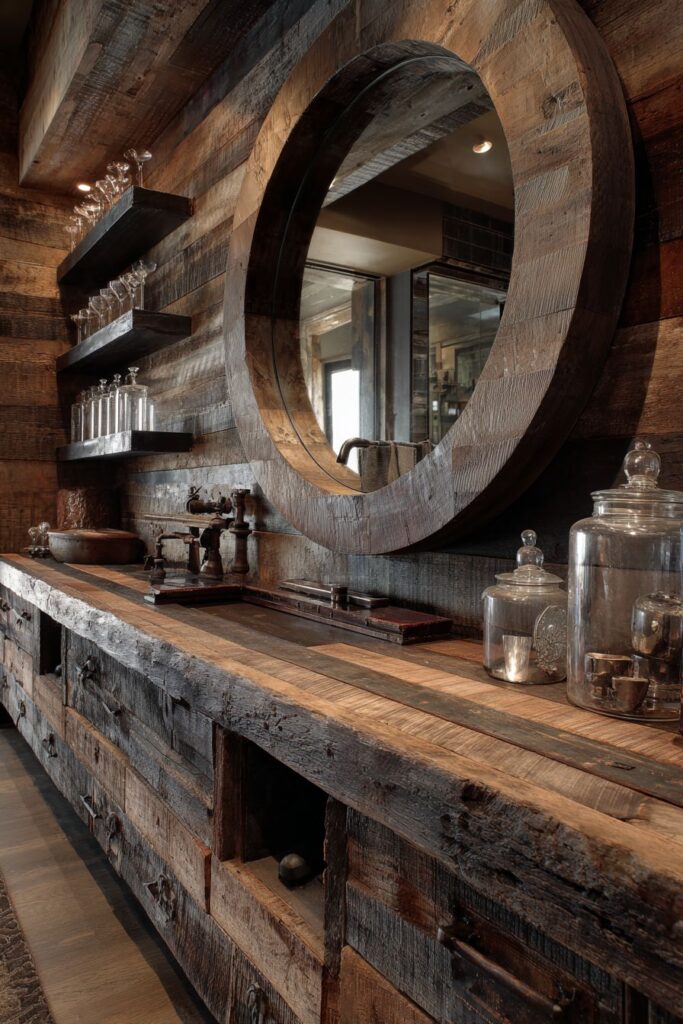
Vintage glass apothecary jars and an antique silver brush set provide functional decor that extends the room’s narrative of collected treasures and timeless beauty. The apothecary jars, with their aged glass and perhaps faded labels, offer practical storage for cotton balls, jewelry, or other vanity essentials while contributing to the aesthetic story. The silver brush set, with its patinated finish and elegant handles, represents the kind of quality craftsmanship that was once standard in personal grooming items. Soft diffused lighting emphasizes the layered textures and genuine patina of these well-loved vintage pieces, creating an intimate space that feels both practical and beautiful.
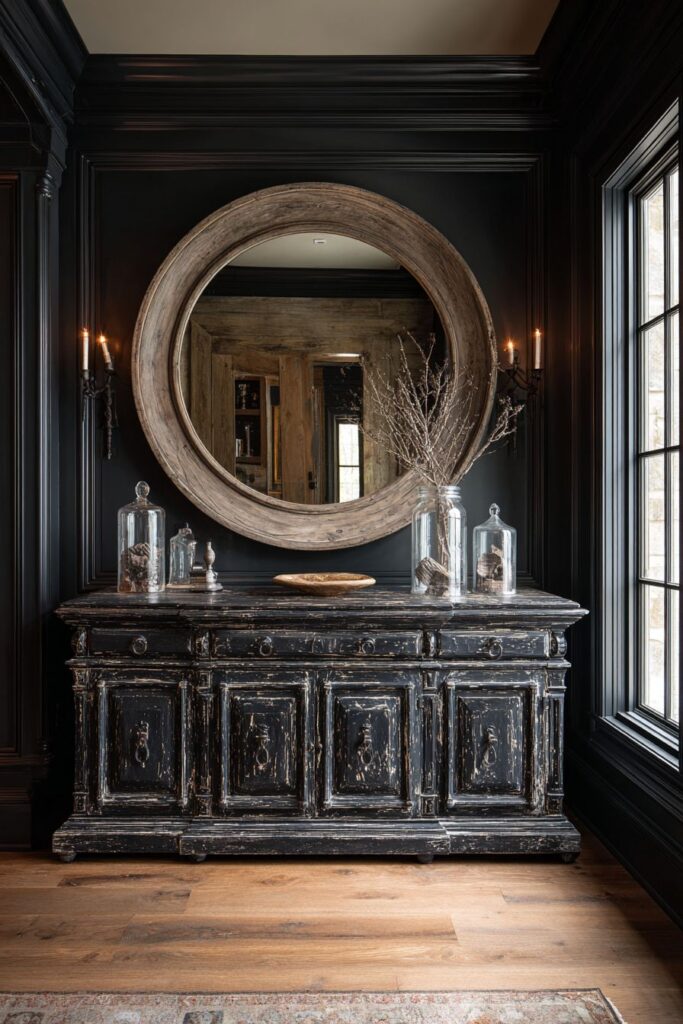
Key Design Tips:
- Choose reclaimed wood furniture with authentic multi-layered distressing for genuine age appearance
- Select oversized mirrors to create visual impact and maximize light reflection in dark spaces
- Display vintage grooming accessories as functional decor that reinforces period authenticity
- Layer various wood tones through distressing to add depth and prevent flat appearance
- Install soft, diffused lighting at vanity areas to create flattering illumination for daily use
8. Window Treatment Textile Drama
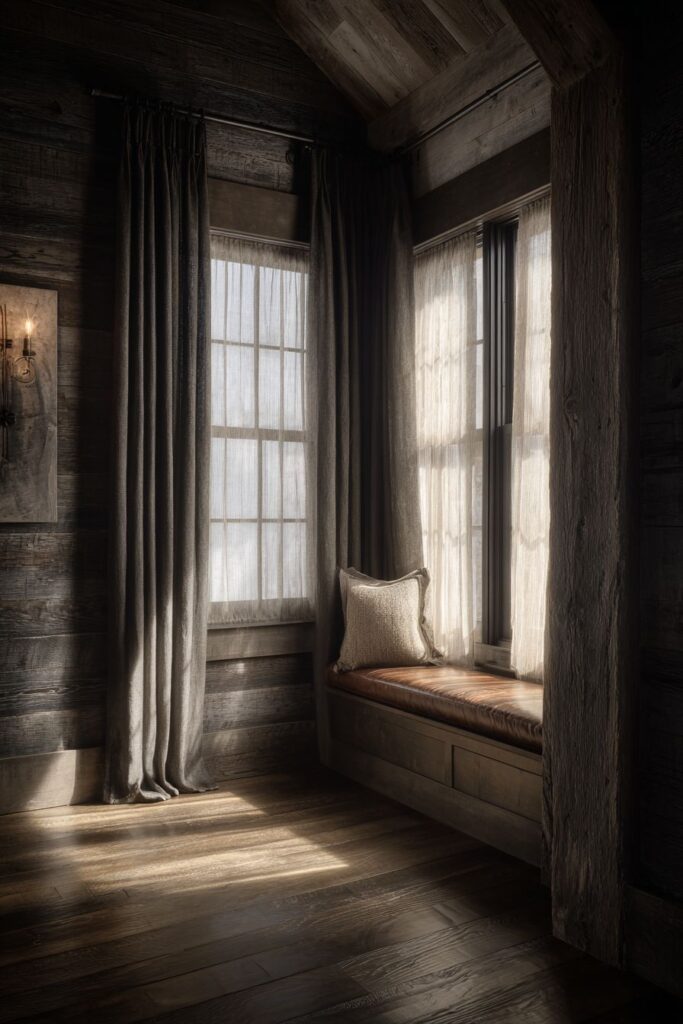
Heavy linen curtains in charcoal grey mounted on a weathered iron rod with hand-forged brackets create dramatic window dressing that serves both functional and aesthetic purposes. The weight of the linen allows the fabric to fall in natural, relaxed folds that puddle slightly on the floor, a deliberate design choice that adds luxury and softness to the space. The charcoal grey tone maintains the room’s dark rustic palette while providing privacy and light control options throughout the day. The hand-forged brackets add artisanal detail, their irregular surfaces and unique forms showcasing the blacksmith’s craft and providing visual interest at the intersection of textile and architecture.
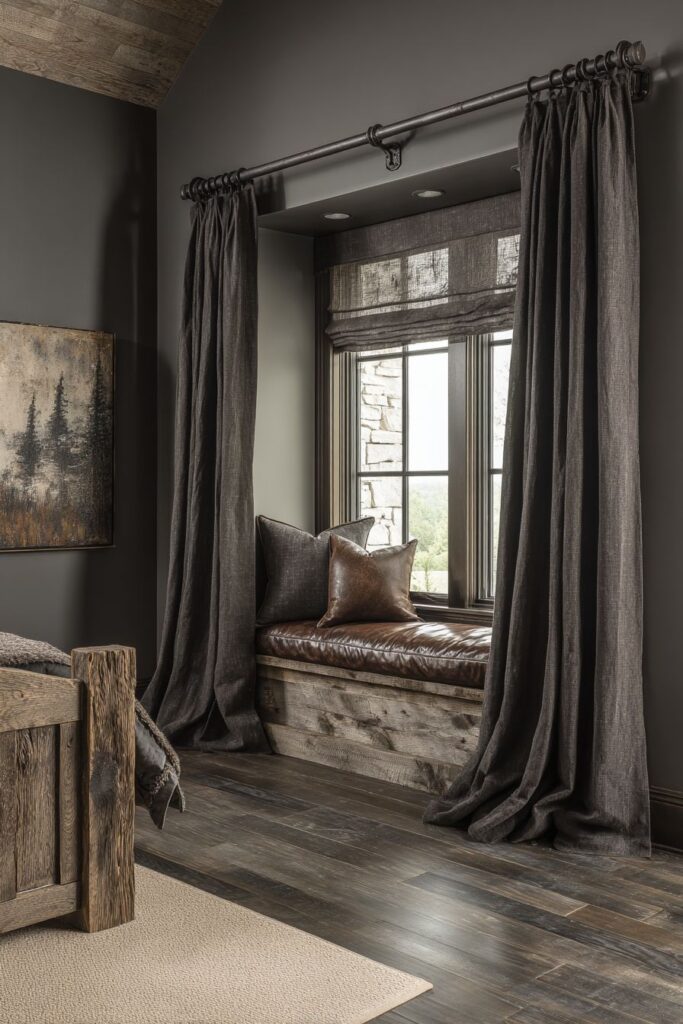
The curtains puddle gracefully on wide-plank flooring stained in deep espresso with natural wood grain visible through the finish. This puddling effect, where fabric extends beyond the floor line, creates a sense of abundance and intentional design rather than mere functionality. The deep espresso flooring provides a rich foundation for the room, its dark tone grounding the space while the visible grain pattern maintains connection to natural materials. The wide planks suggest historic construction methods, when timber was cut in broader dimensions, and their generous width creates a sense of solidity and permanence beneath the flowing textiles.
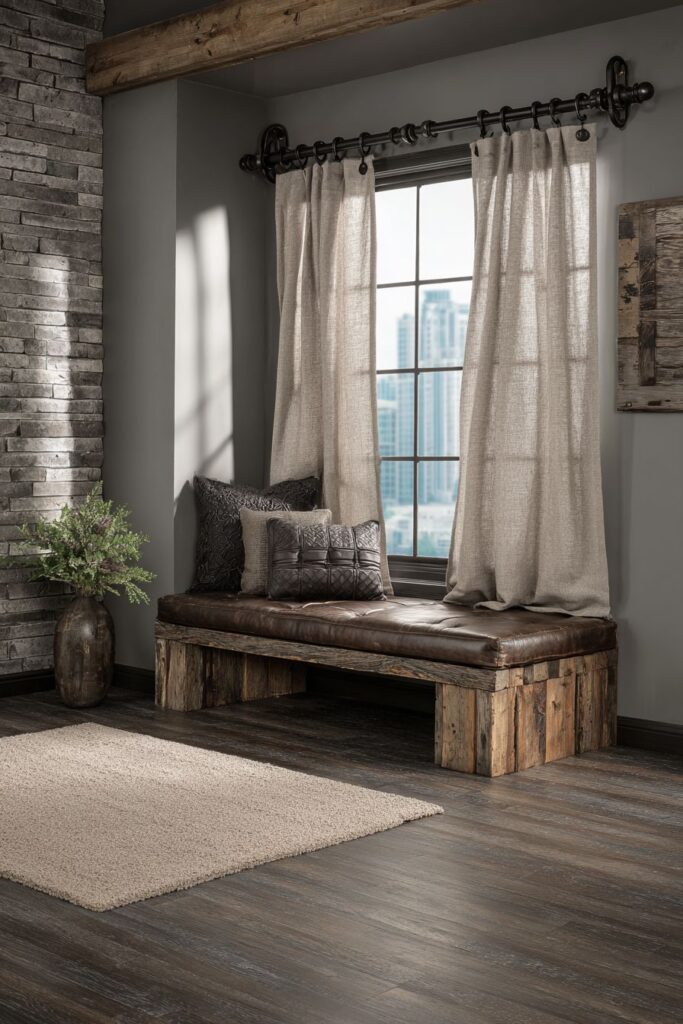
A window seat built from reclaimed barn wood provides comfortable seating with a cushion covered in distressed leather, creating an intimate spot to enjoy natural light while remaining within the bedroom’s cocoon. The barn wood brings authentic weathering and grain pattern to this built-in feature, while the distressed leather cushion adds softness and warmth. Natural morning light filters through the semi-sheer quality of the linen, creating soft shadows on the textured walls painted in deep slate grey. This filtered light provides privacy while allowing the room to benefit from natural illumination that changes in quality and intensity throughout the day.
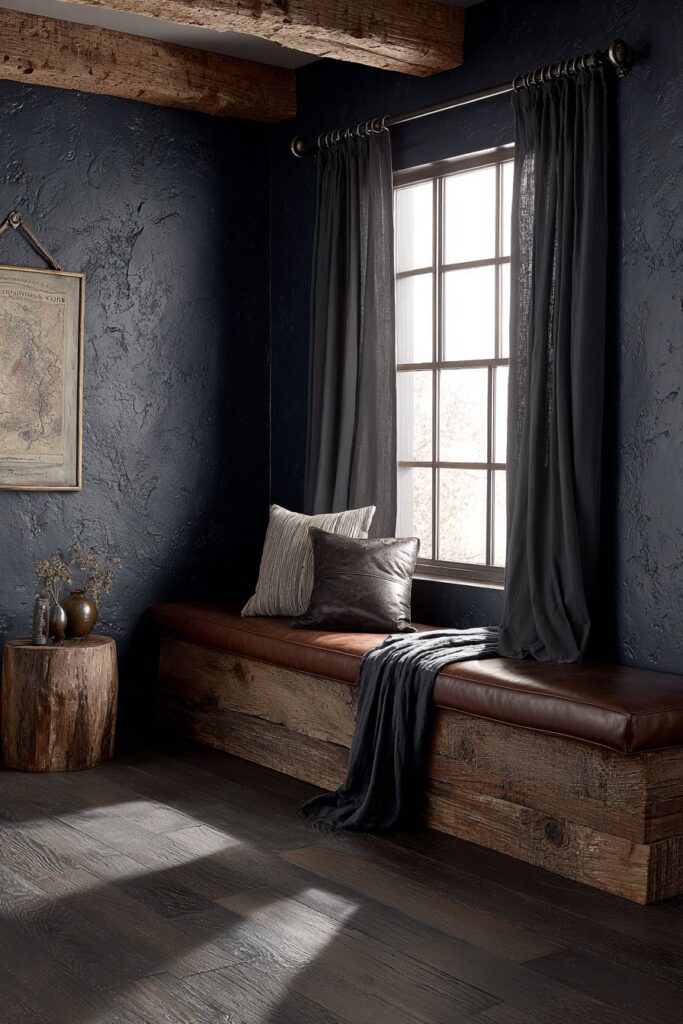
Key Design Tips:
- Select heavyweight linen curtains that puddle slightly for luxurious, intentional appearance
- Mount curtain rods using hand-forged brackets to add artisanal detail and visual interest
- Build window seats from reclaimed materials to create functional spaces with authentic character
- Choose semi-sheer fabrics that filter light while maintaining privacy throughout the day
- Coordinate curtain hardware finish with other metal elements for cohesive design
9. Stone Fireplace Focal Point
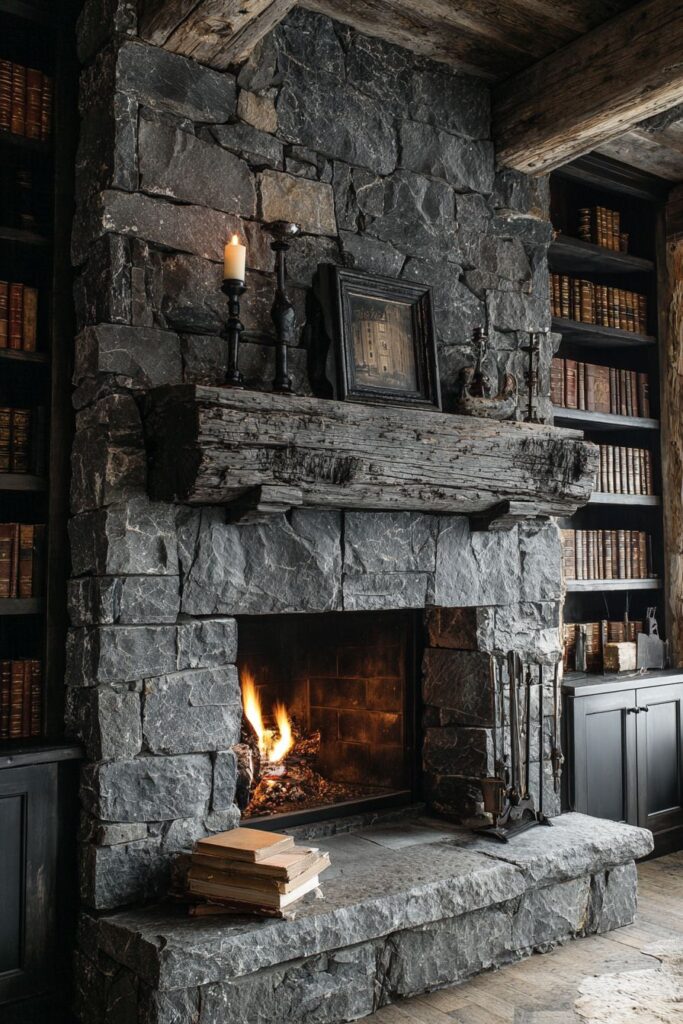
A stone fireplace constructed from irregular natural stones in charcoal and deep grey tones held by visible mortar becomes the room’s commanding focal point, providing both practical warmth and visual drama. Each stone displays unique geological characteristics—color variations, surface texture, natural fracture patterns—that combine to create a one-of-a-kind installation. The mortar, far from being merely functional, becomes part of the design story, its lighter tone creating contrast that emphasizes each stone’s individual form while unifying them into a cohesive whole. The irregular placement of stones creates an organic, almost sculptural quality that contrasts beautifully with the geometric lines of the surrounding architecture.
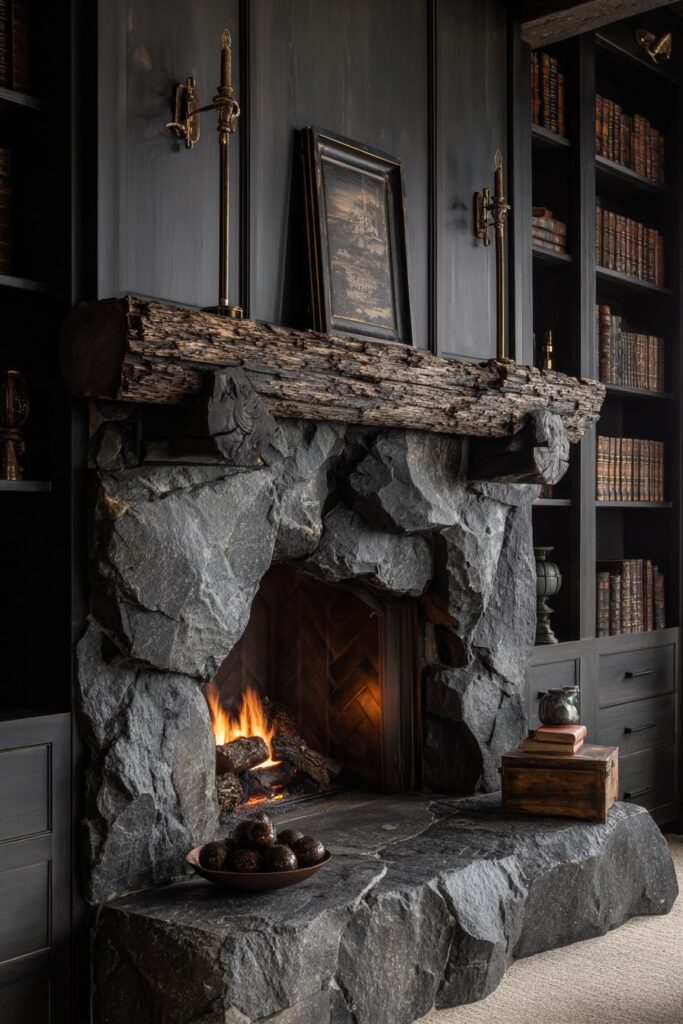
The rustic mantel crafted from a single thick beam of reclaimed timber with bark edges partially intact adds warmth and organic texture above the stone surround. This substantial piece of wood, perhaps salvaged from an old barn or mill building, carries its own history in the grain patterns, age cracks, and weathering visible on its surface. The partial retention of bark edges maintains connection to the tree’s original form, reminding viewers of the beam’s natural origins. This raw-edged timber provides the perfect shelf for displaying carefully curated objects while adding horizontal emphasis that balances the vertical thrust of the stone fireplace.
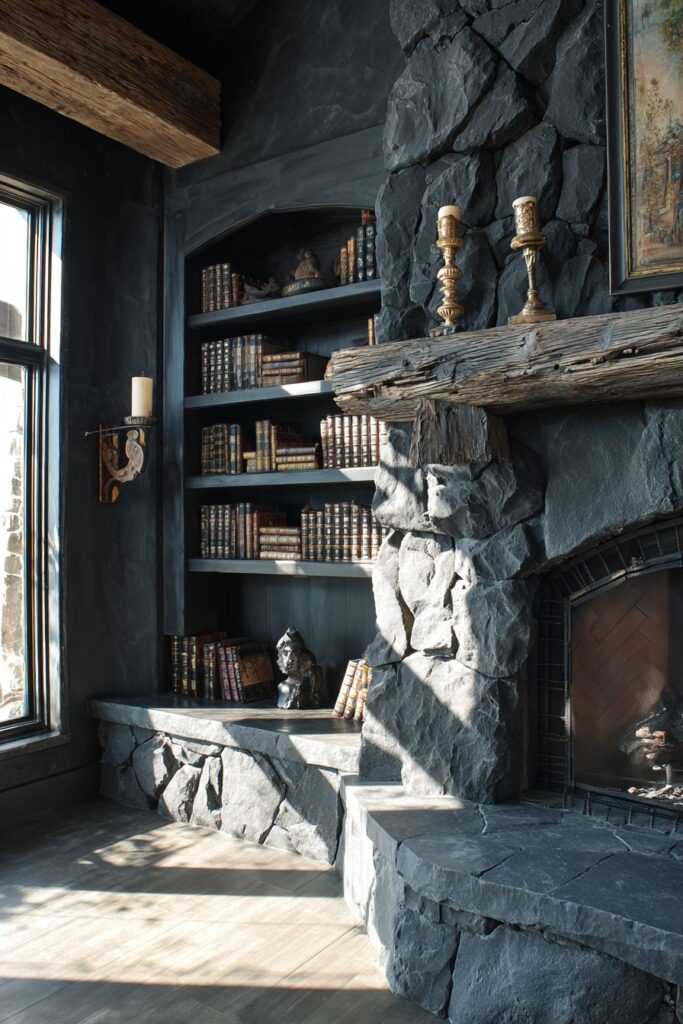
Flanking the fireplace are built-in shelves made from matching dark wood, displaying leather-bound books and antique brass candlesticks that enhance the room’s sophisticated rustic character. The leather-bound volumes add rich texture and color variation, their aged spines and gilt lettering contributing to the room’s narrative of timeless elegance. Antique brass candlesticks, their surfaces showing authentic patina and perhaps slight dents or irregularities, provide vertical elements that draw the eye while adding the warm metallic tones that complement the dark wood and grey stone. Firelight creates dancing shadows across the room, the flickering illumination adding movement and warmth that transforms the static architecture into a living, breathing space.
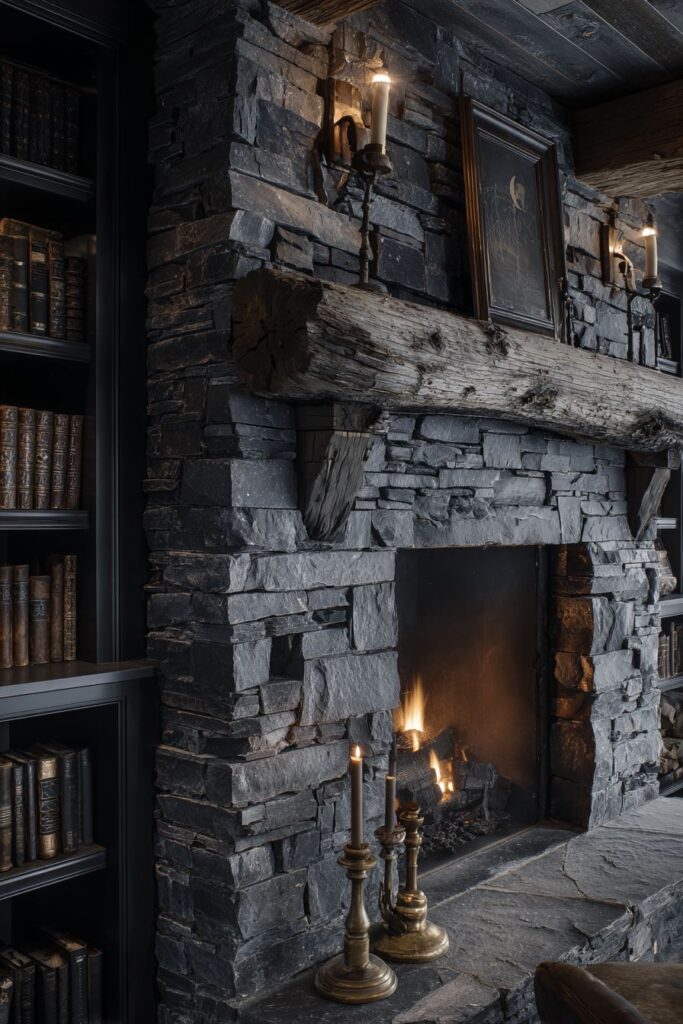
Key Design Tips:
- Select natural stone with color variation to create depth and prevent monotonous appearance
- Choose mantel beams with partial bark edges to maintain connection to natural wood forms
- Integrate built-in shelving flanking fireplaces for symmetry and additional display opportunities
- Display vintage books and metallic objects to add warmth and reflective surfaces
- Position seating to enjoy firelight while maintaining conversation-friendly arrangements
10. Integrated Workspace Design
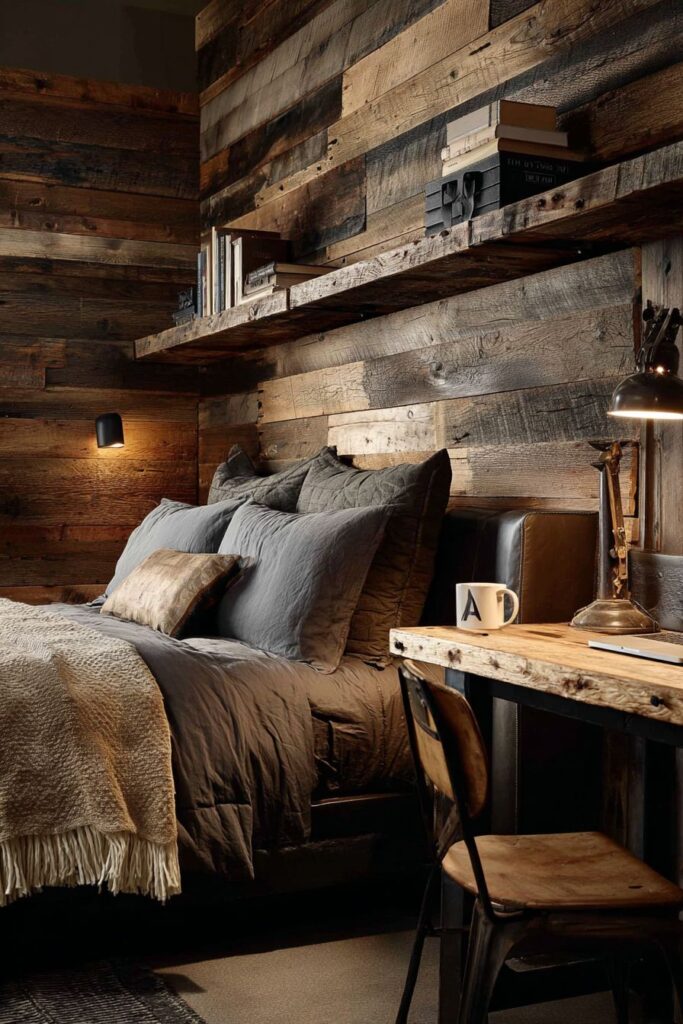
A desk made from a thick wood plank supported by industrial black iron pipe legs creates a workspace that integrates seamlessly with the bedroom while maintaining the dark rustic aesthetic. The thick plank showcases beautiful grain patterns and natural edge variations, its substantial thickness suggesting permanence and quality construction. The industrial pipe legs provide sturdy support while adding mechanical interest that contrasts with the organic wood surface. This combination of natural and industrial materials creates visual tension that energizes the workspace, preventing it from feeling staid or traditional.
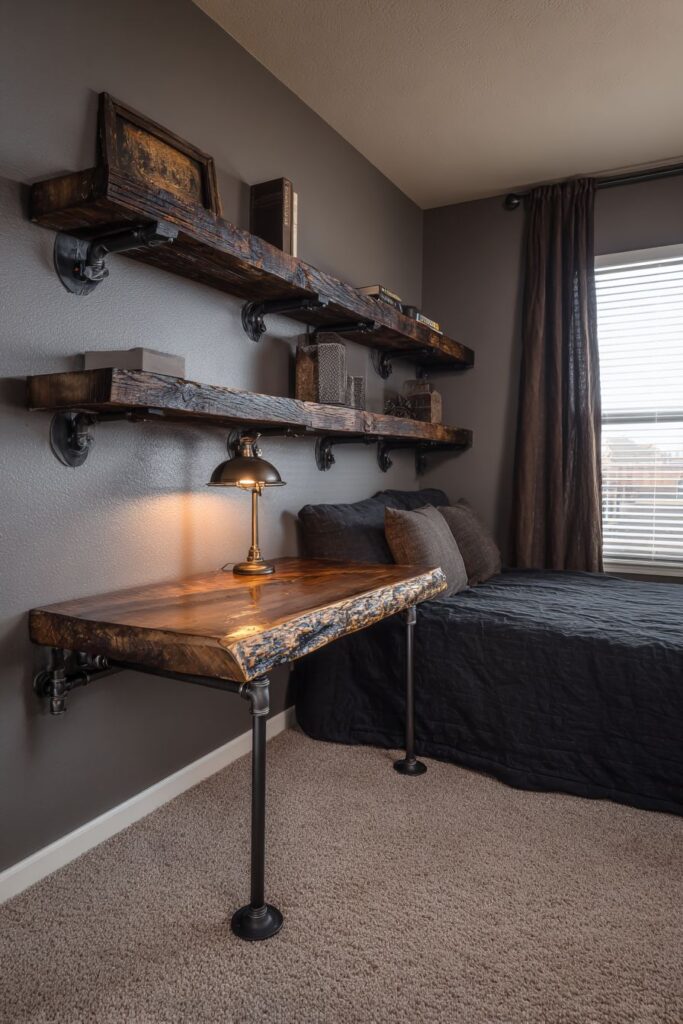
The wall above the desk displays floating shelves made from weathered barn wood in deep brown tones with authentic nail holes and age cracks that tell stories of previous lives. These shelves appear to hover against the wall, their mounting hardware cleverly concealed to maintain the illusion of weightlessness despite their substantial appearance. The weathered finish and visible imperfections—nail holes that once secured boards to barn walls, cracks that developed as the wood aged and dried—add character and authenticity. The deep brown tones create subtle contrast against the wall while maintaining harmony with the room’s overall color palette.
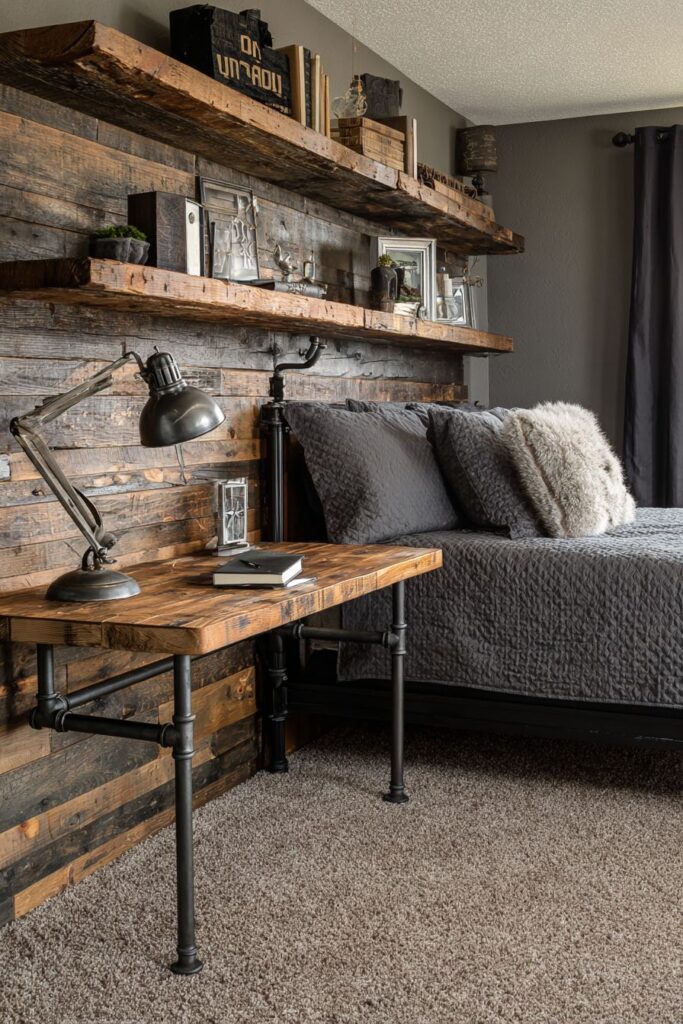
A vintage task lamp with a metal shade provides focused lighting for work tasks without disrupting the room’s atmospheric ambiance. The lamp’s articulated arm allows for positioning the light exactly where needed, while the metal shade directs illumination downward onto the work surface. The vintage styling ensures the lamp feels at home within the rustic aesthetic rather than appearing as an afterthought or purely functional addition. The workspace integrates seamlessly with the bedroom through consistent material choices and natural wear patterns that echo throughout the room, creating a cohesive environment where work and rest coexist harmoniously.
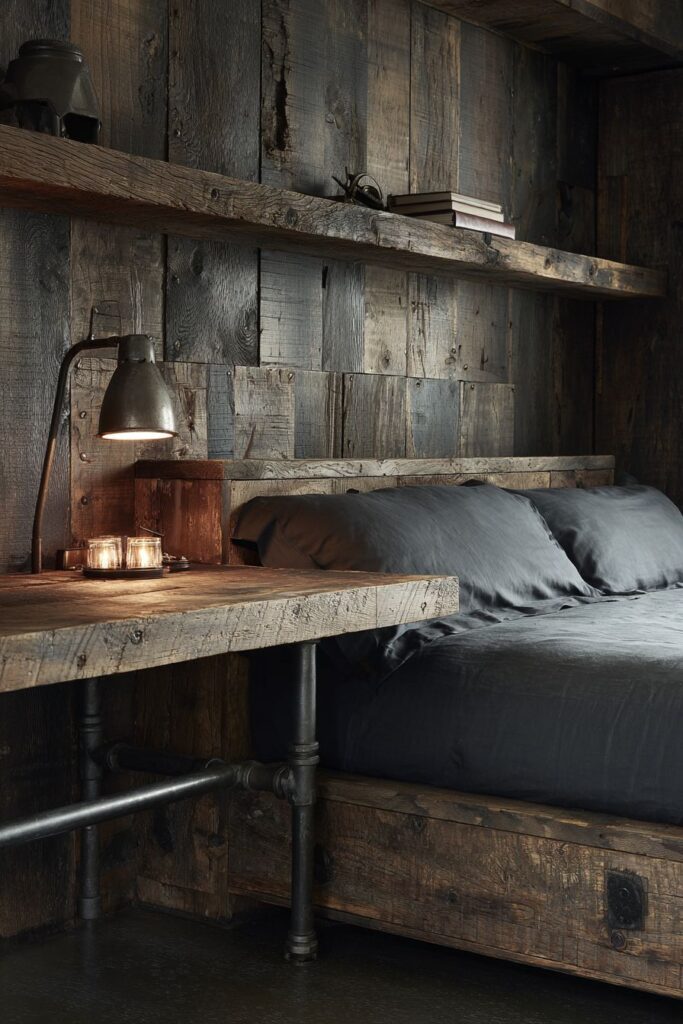
Key Design Tips:
- Create desks from single thick planks for visual impact and connection to natural materials
- Use industrial pipe legs to add mechanical interest while providing sturdy support
- Install floating shelves to maintain clean lines while providing essential storage
- Select vintage task lighting that provides function while reinforcing period authenticity
- Position workspaces near natural light sources while maintaining privacy from the sleeping area
11. Hand-Scraped Hardwood Foundation
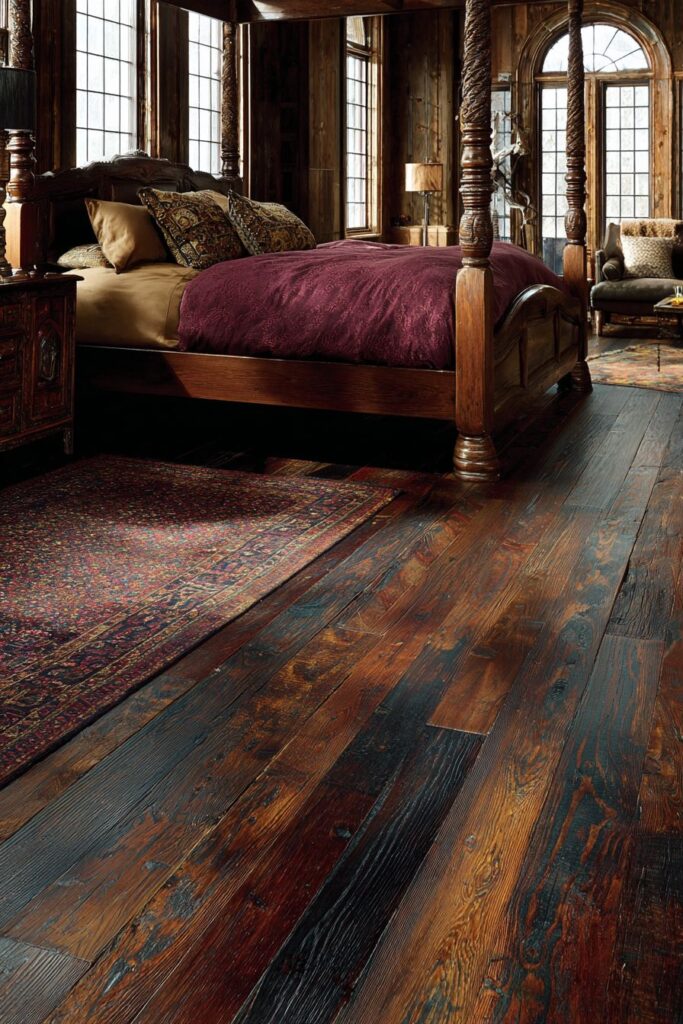
Hand-scraped hardwood planks in a rich dark walnut stain with varied grain patterns and subtle color variations across each board create a luxurious foundation that anchors the entire bedroom design. The hand-scraping technique adds dimensional texture to each plank, with subtle ridges and valleys that catch light differently throughout the day. Unlike perfectly smooth flooring, this textured surface invites touch and creates visual interest even in areas where no furniture stands. The dark walnut stain enriches the wood’s natural tones while allowing the grain pattern—the growth rings, medullary rays, and natural figure—to remain fully visible and celebrated.
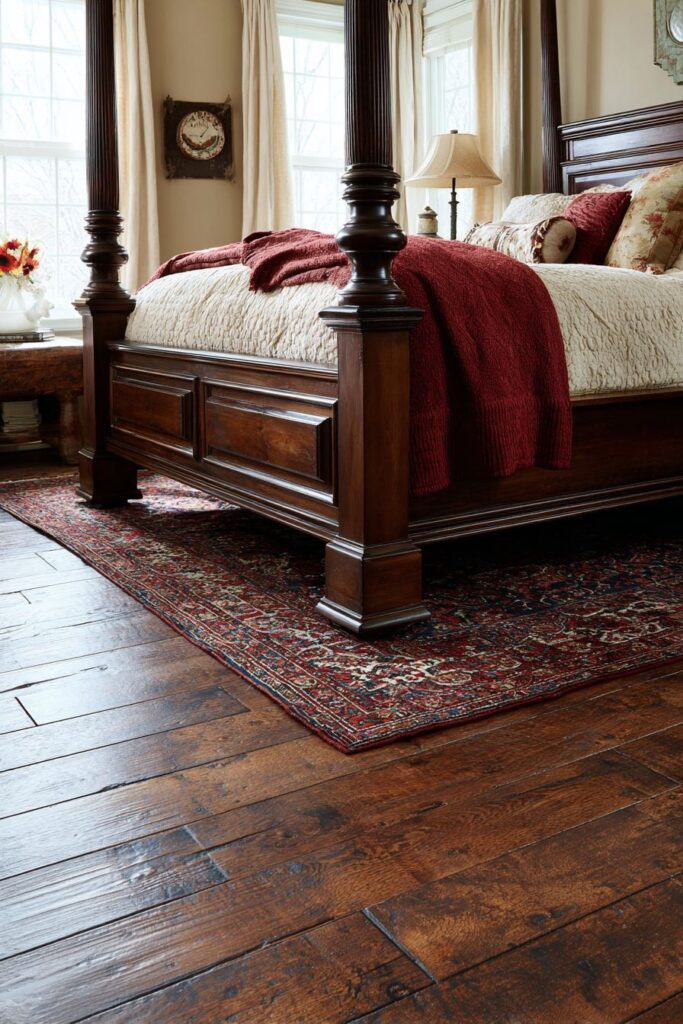
A vintage Persian rug in deep burgundy, navy, and cream anchors the sleeping area with authentic wear patterns that speak to decades of use and care. The intricate patterns traditional to Persian rug making create visual complexity that draws the eye, while the deep colors harmonize beautifully with the dark flooring and rustic aesthetic. Authentic wear patterns—areas where pile has compressed from foot traffic, slight color fading where sunlight has touched the rug over years—add to the room’s narrative of collected treasures and timeless beauty. The rug provides warmth underfoot while softening the acoustic properties of the space, creating a more intimate atmosphere.
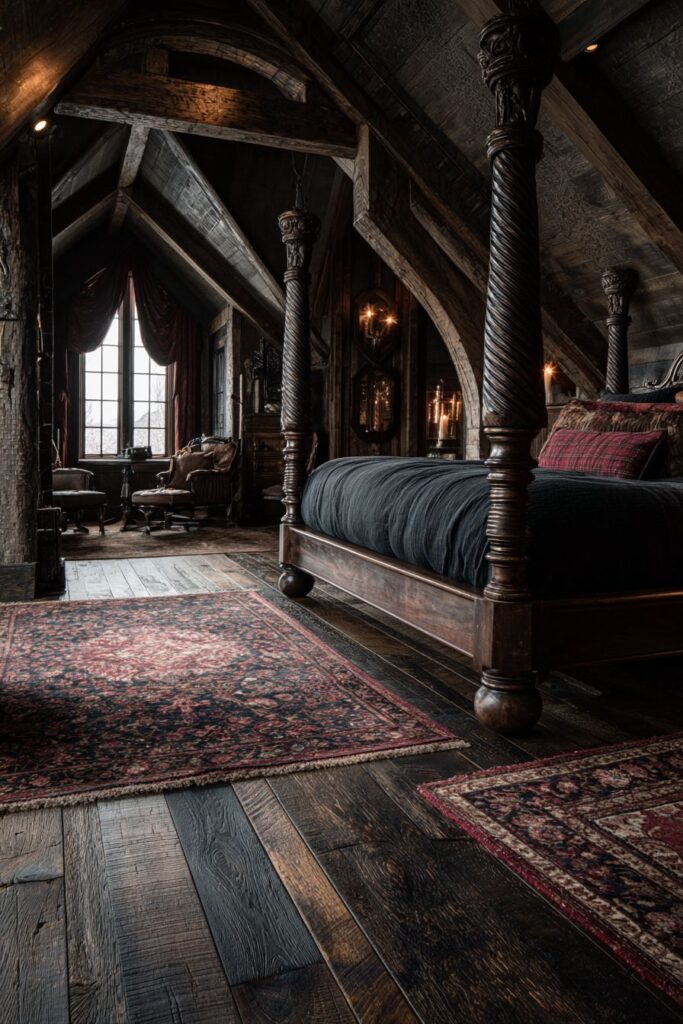
The bed frame features turned posts in matching dark wood with hand-carved details that showcase traditional woodworking techniques. The turned posts display the lathe worker’s skill, with smooth curves and precise proportions that could only be achieved through careful craftsmanship. Hand-carved details—perhaps floral motifs, geometric patterns, or decorative rings—add visual interest and demonstrate the attention to detail that characterizes quality furniture. Natural light from clerestory windows positioned high on the walls highlights the floor’s texture while maintaining privacy, the elevated light source creating interesting shadow patterns that emphasize the hand-scraped texture and varied grain of the hardwood planks.
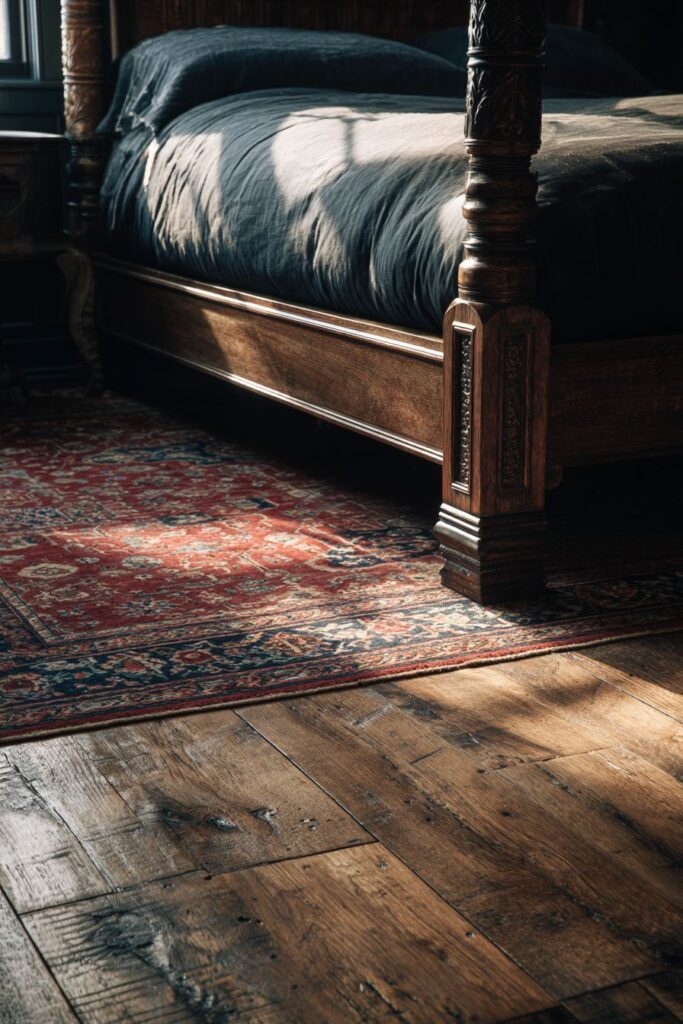
Key Design Tips:
- Invest in hand-scraped hardwood for texture and light-catching dimension underfoot
- Layer vintage rugs over dark floors to add pattern, warmth, and authentic age
- Select bed frames with hand-carved details to showcase traditional craftsmanship
- Install clerestory windows for natural light without sacrificing wall space or privacy
- Vary wood grain and color within consistent tones to prevent flat, monotonous appearance
12. Layered Lighting Sophistication
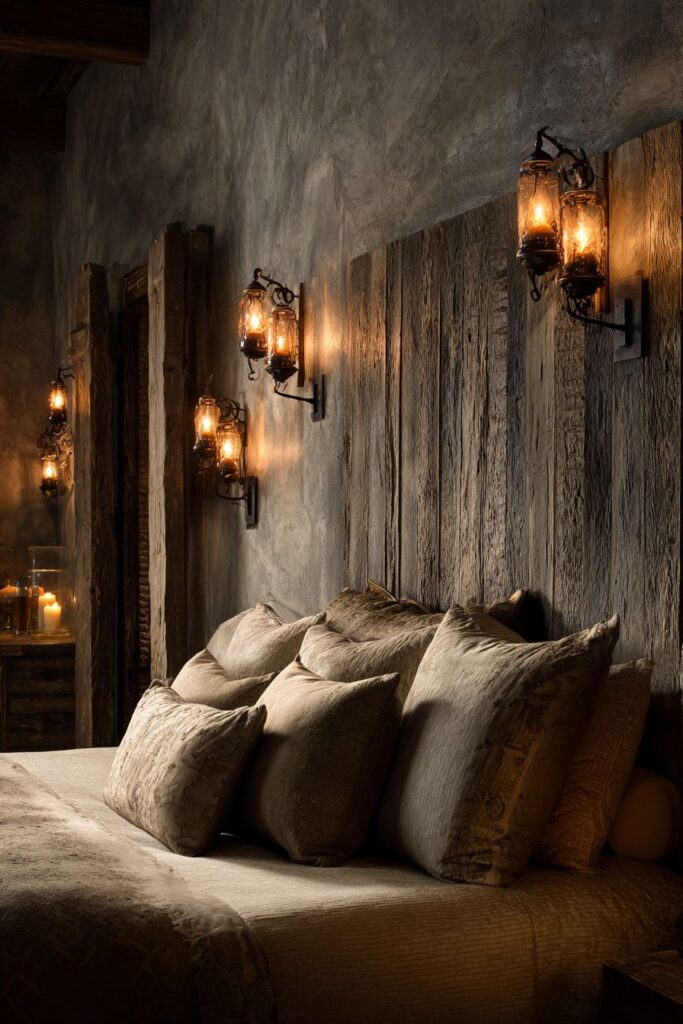
Multiple wrought iron sconces with aged black finish and amber glass shades mounted on walls finished in dark grey plaster with subtle trowel marks create a sophisticated lighting scheme that enhances the room’s moody atmosphere. Each sconce represents handcrafted metalwork, with subtle variations in the iron’s texture and finish that reveal the fabrication process. The aged black finish adds depth and authenticity, suggesting years of use while maintaining the contemporary appeal of a curated dark palette. The amber glass shades provide warm, filtered light that contrasts beautifully with the cooler tones of the grey plaster walls.
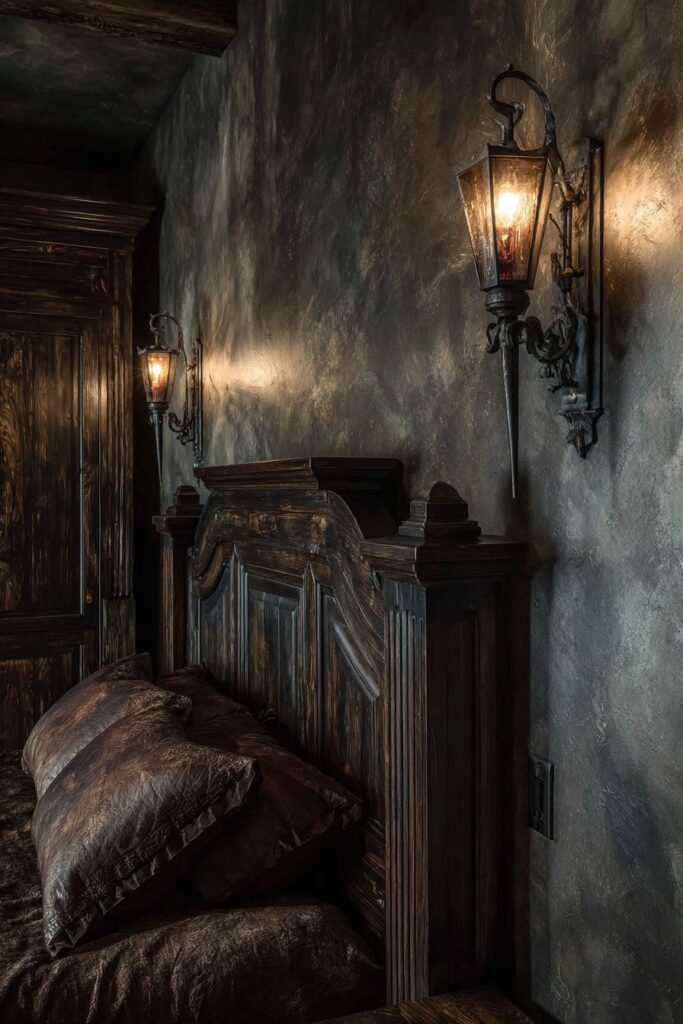
The dark grey plaster walls showcase artisanal finishing techniques, with subtle trowel marks visible in the surface texture. These marks aren’t flaws but deliberate choices that add handcrafted character and prevent the walls from appearing too perfect or sterile. The plaster finish provides subtle variation in light reflection, with slight undulations catching and diffusing light differently across the surface. This creates a living wall that changes appearance throughout the day as light conditions shift, adding depth and interest to what might otherwise be flat vertical surfaces.
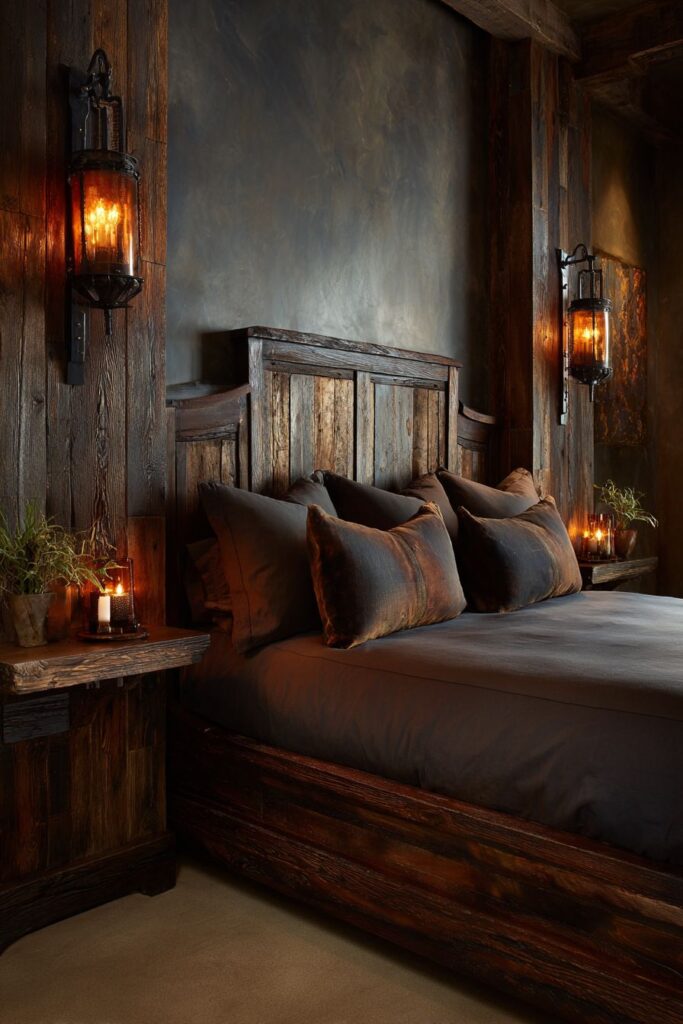
A substantial wooden bed with a tall headboard made from vertical planks in espresso stain serves as the room’s centerpiece, its dark presence grounded and commanding. The vertical orientation of the planks creates linear movement that draws the eye upward, emphasizing the room’s ceiling height while adding architectural interest. The espresso stain provides rich, luxurious color that harmonizes with the dark rustic aesthetic while showcasing the wood’s natural grain. The sconces create pools of warm light against the dark walls while maintaining atmospheric shadows that add drama and intimacy. This layered lighting approach—combining multiple light sources at various heights—creates ambiance while allowing for functional illumination when needed.
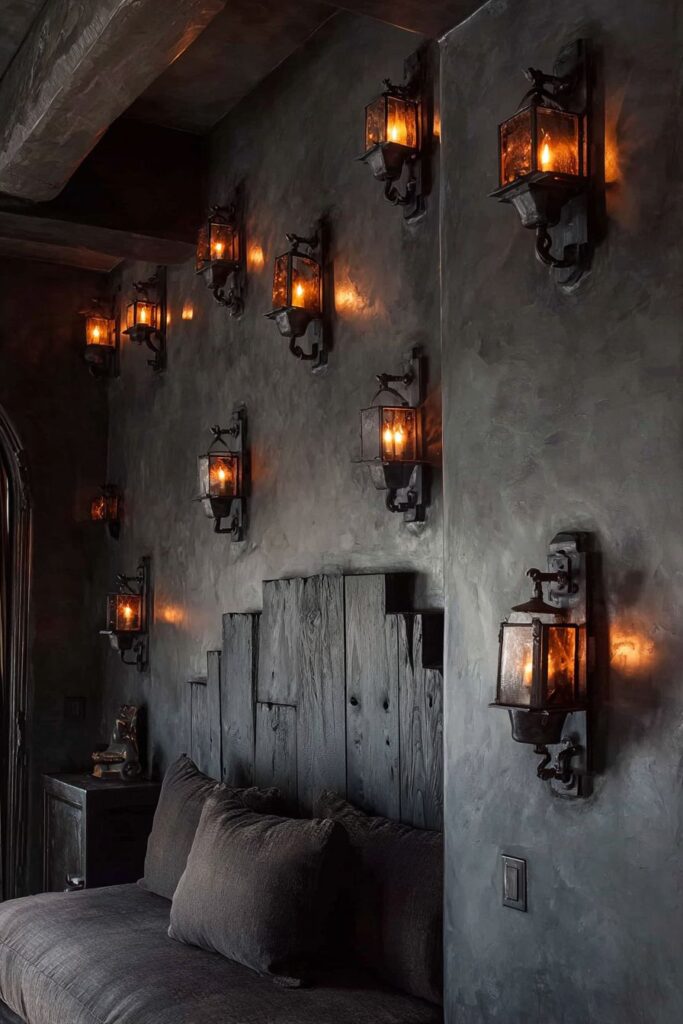
Key Design Tips:
- Install multiple light sources at varying heights for flexible, layered illumination
- Choose hand-forged sconces with visible craftsmanship marks for authentic character
- Apply plaster finishes with visible trowel marks to add artisanal texture to walls
- Select amber glass shades to warm light output and create inviting ambiance
- Position sconces to create pools of light while maintaining atmospheric shadow zones
13. Open Closet Organization Beauty
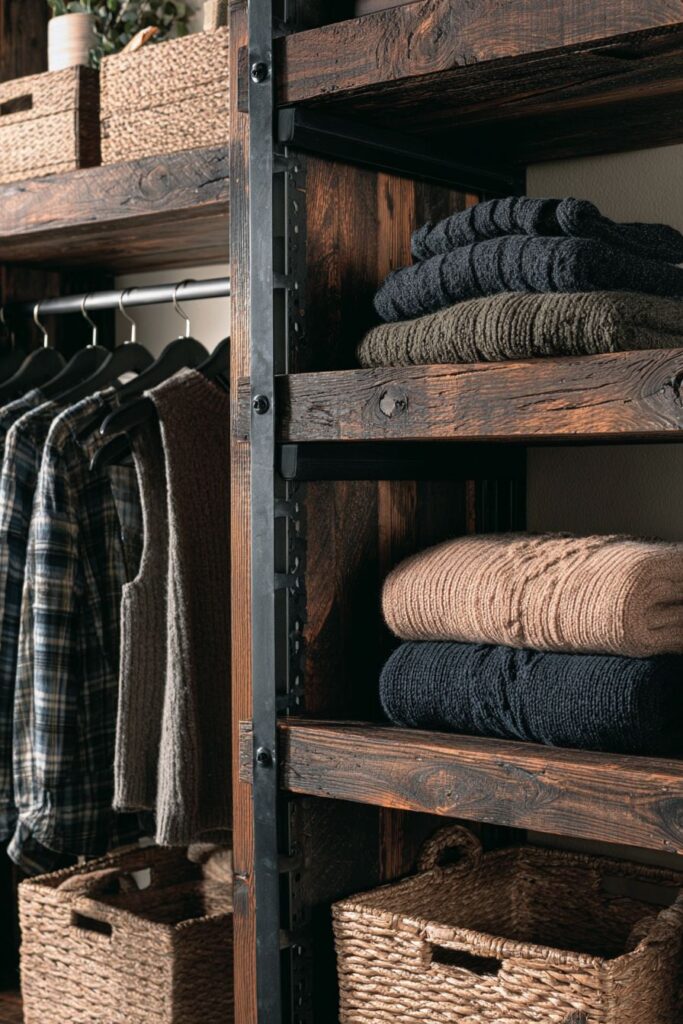
An open shelving system made from thick reclaimed wood planks with a dark oil finish showing natural edge details and knot patterns transforms closet organization from hidden necessity to visible design element. The thick planks provide substantial support for stored items while creating visual impact through their generous proportions and authentic material character. The dark oil finish enriches the wood’s natural color while protecting the surface, allowing grain patterns, knots, and natural edge details to remain fully visible and celebrated. This open approach to storage requires thoughtful curation of displayed items but rewards with a visually appealing system that integrates seamlessly with the room’s aesthetic.
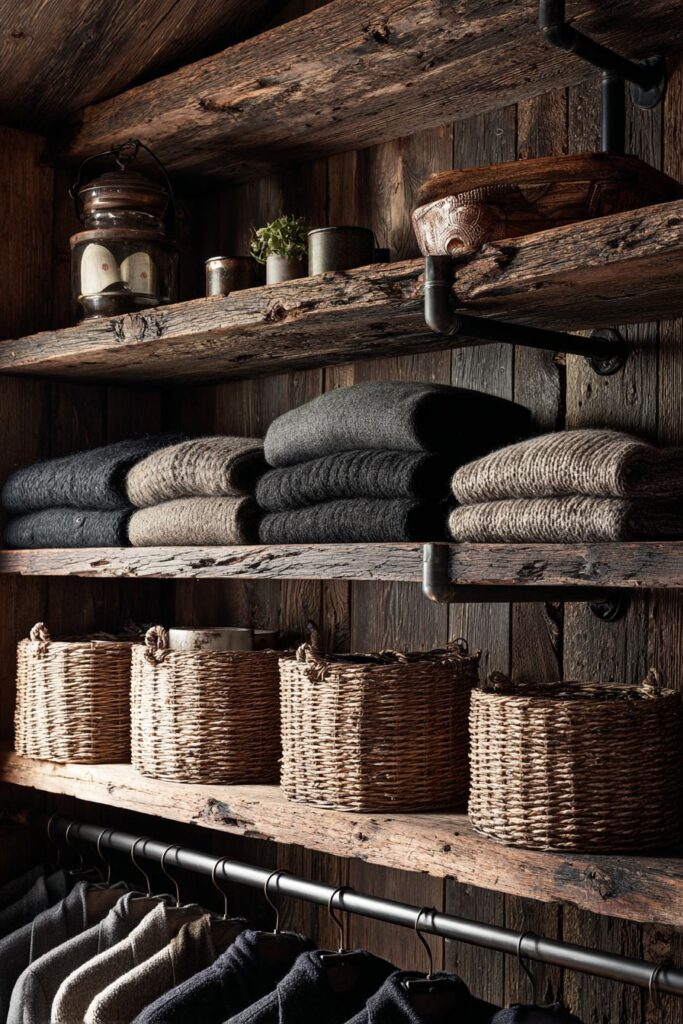
Custom rod holders crafted from wrought iron support a clothing rod displaying folded sweaters and hanging items, the functional hardware becoming decorative elements in their own right. The wrought iron holders showcase traditional blacksmithing techniques, with hand-forged details and subtle surface variations that distinguish them from mass-produced alternatives. The clothing rod itself, whether in dark metal or wood finish, provides necessary function while maintaining visual harmony with the surrounding materials. Carefully displayed folded sweaters and hanging garments become part of the room’s visual composition, their textures and colors contributing to the overall aesthetic rather than being hidden away.
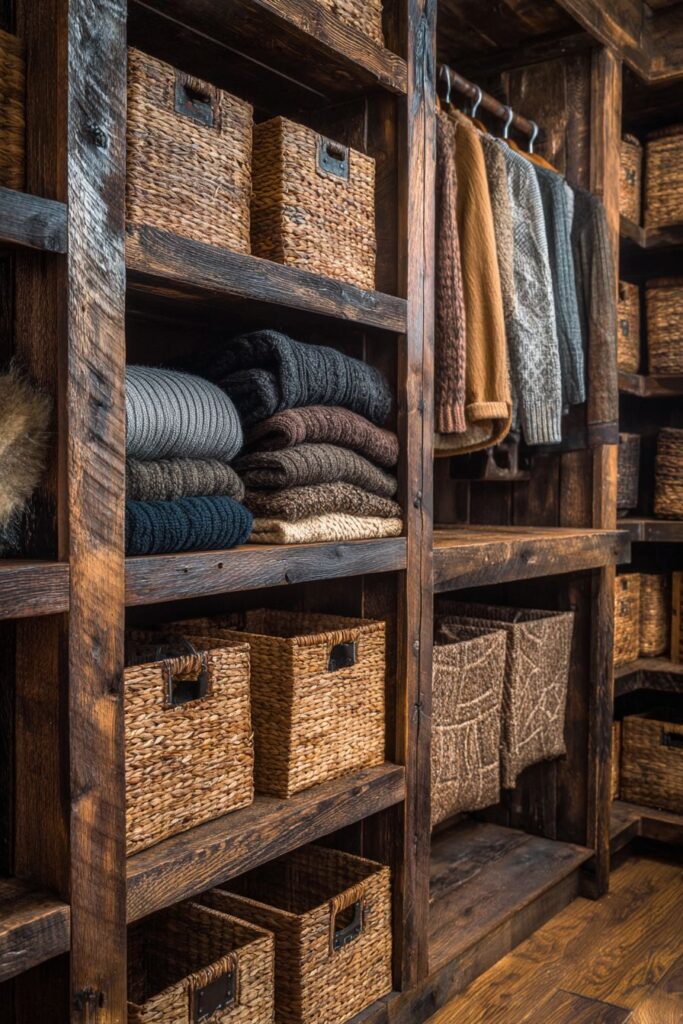
Woven baskets in natural materials provide textured storage on lower shelves, their organic forms and earthy tones adding warmth while concealing smaller items that benefit from containment. The basketweave texture creates visual interest and tactile appeal, while the natural materials—perhaps seagrass, rattan, or willow—maintain connection to the room’s organic material palette. Soft natural lighting showcases the practical functionality of the system while emphasizing the authentic rustic materials and lived-in quality of the thoughtfully organized space. The combination of open and concealed storage creates visual rhythm while maintaining the functionality essential to daily living.
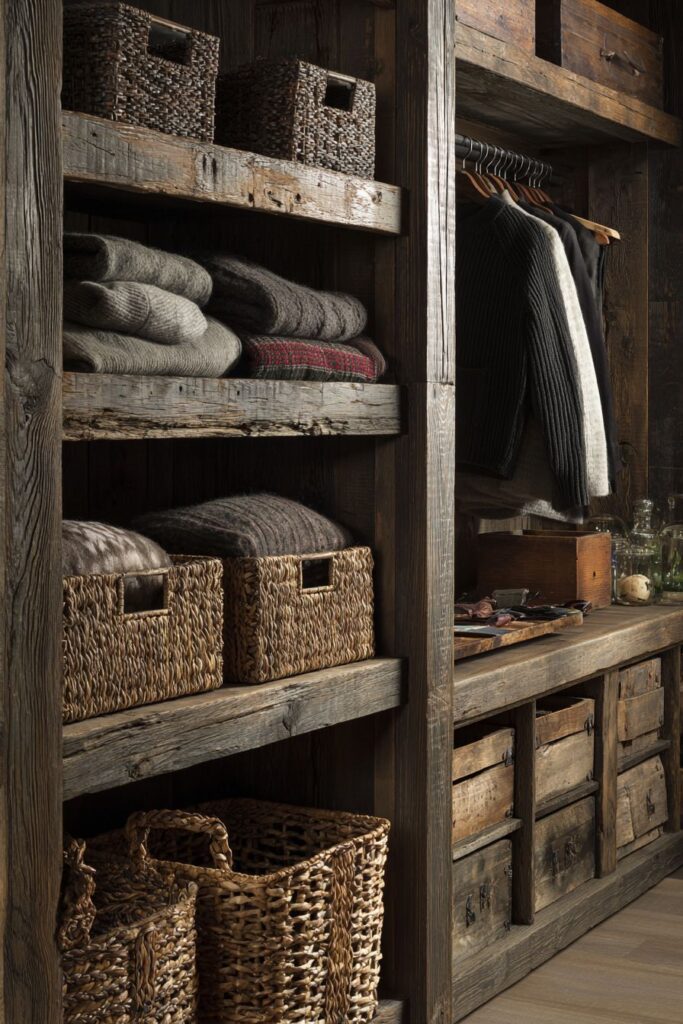
Key Design Tips:
- Design open shelving using thick planks for visual impact and sturdy support
- Craft custom rod holders from wrought iron to elevate functional hardware to decorative status
- Curate displayed items carefully to maintain visual appeal in open storage systems
- Use woven baskets for concealed storage that maintains organic material connection
- Position shelving to maximize natural light while avoiding direct sun that could fade textiles
14. Dramatic Canopy Bed Presence
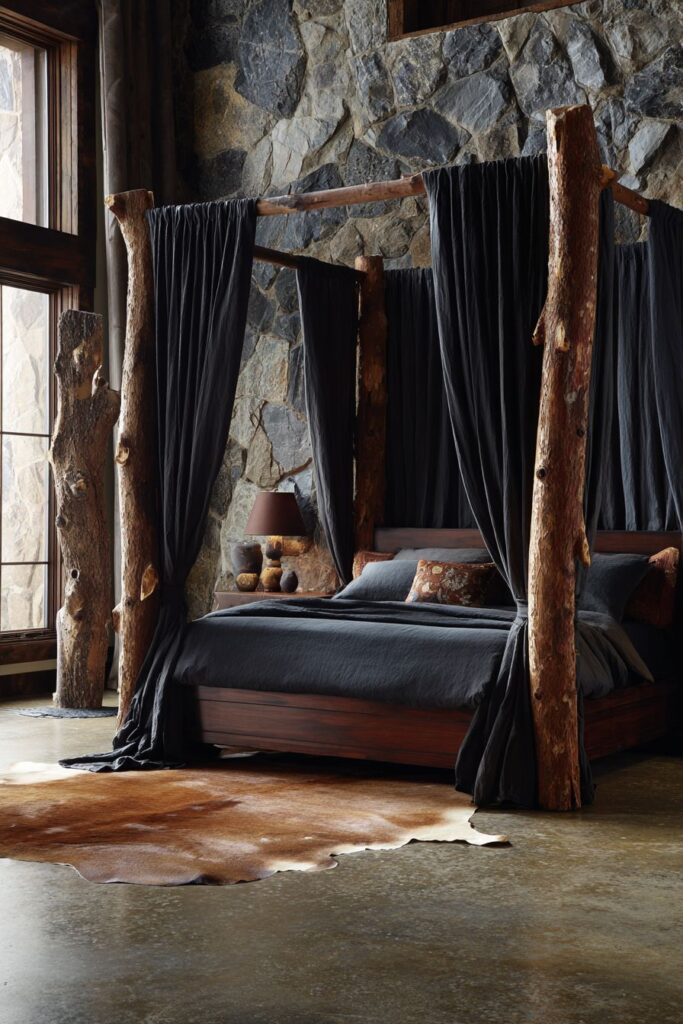
A dramatic canopy bed with posts made from whole logs with bark partially removed and stained in deep chocolate brown creates an organic focal point of remarkable presence. The whole log posts maintain connection to the tree’s original cylindrical form, their substantial girth suggesting strength and permanence. The partial removal of bark creates visual interest through the contrast between smooth wood surfaces and remaining textured bark, celebrating the transition from living tree to crafted furniture. The deep chocolate brown stain enriches the natural wood tones while adding depth and luxury to these already impressive structural elements.
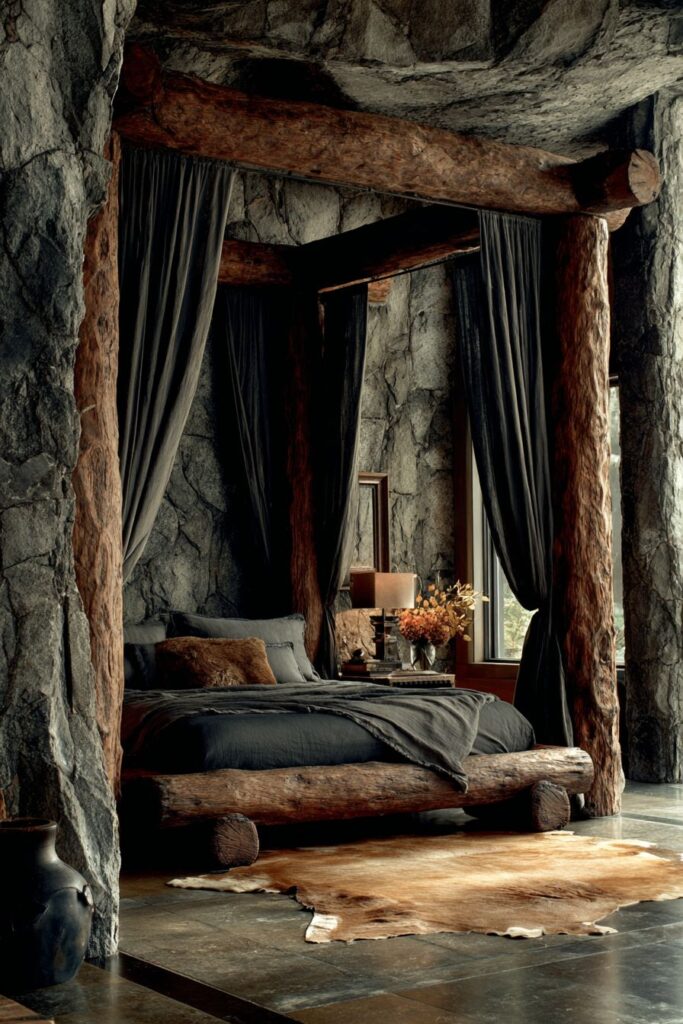
Draped fabric in heavyweight linen in charcoal grey creates an intimate sleeping space within the larger room, transforming the bed into a room within a room. The heavyweight linen falls in natural, relaxed folds that create texture and movement, its substantial weight ensuring the drapes hang beautifully while providing visual privacy for the sleeping area. The charcoal grey tone maintains the room’s dark rustic palette while creating soft visual boundaries that define the bed as a distinct zone. The canopy framework allows for various draping approaches—perhaps open at the foot for ease of access while enclosed at the sides for greater intimacy.
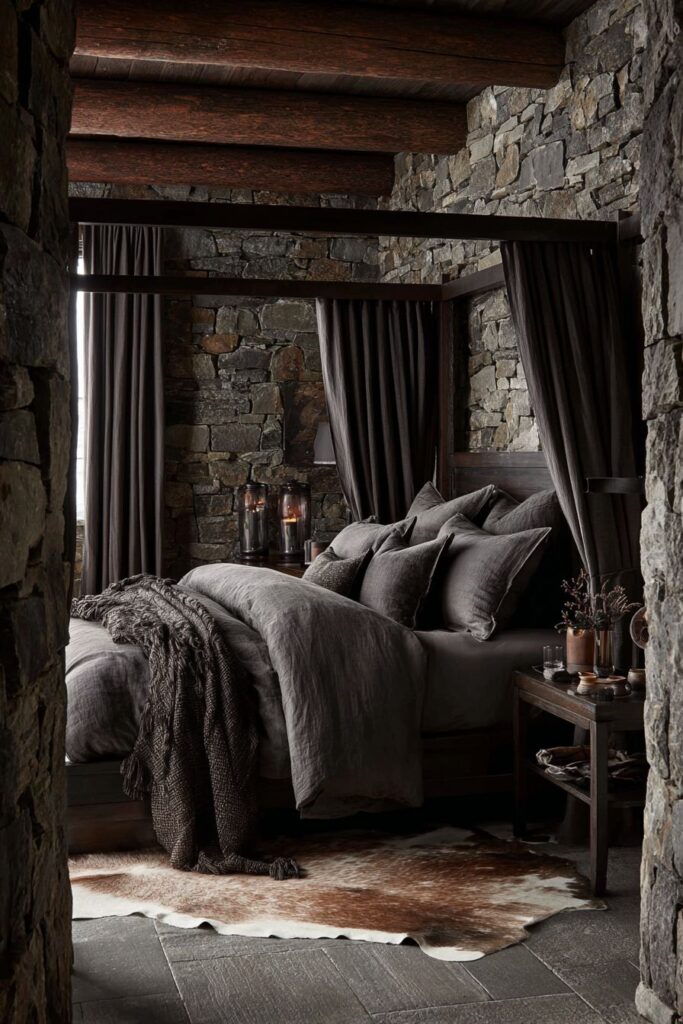
The surrounding stone walls show natural variation in dark grey and brown tones with rough-hewn texture that provides dramatic contrast to the organic forms of the log posts. Each stone displays unique characteristics—color, texture, size—that combine to create a wall surface rich with visual interest. The rough-hewn texture, with its irregular surface and visible tool marks, suggests hand-crafting and traditional building techniques that align with the bed’s organic aesthetic. A cowhide rug in natural tones provides warmth underfoot while adding another layer of organic pattern and texture. Soft window light creates atmospheric mood that highlights the organic forms of the raw wood posts, their cylindrical shapes creating interesting shadows that emphasize their three-dimensional presence.
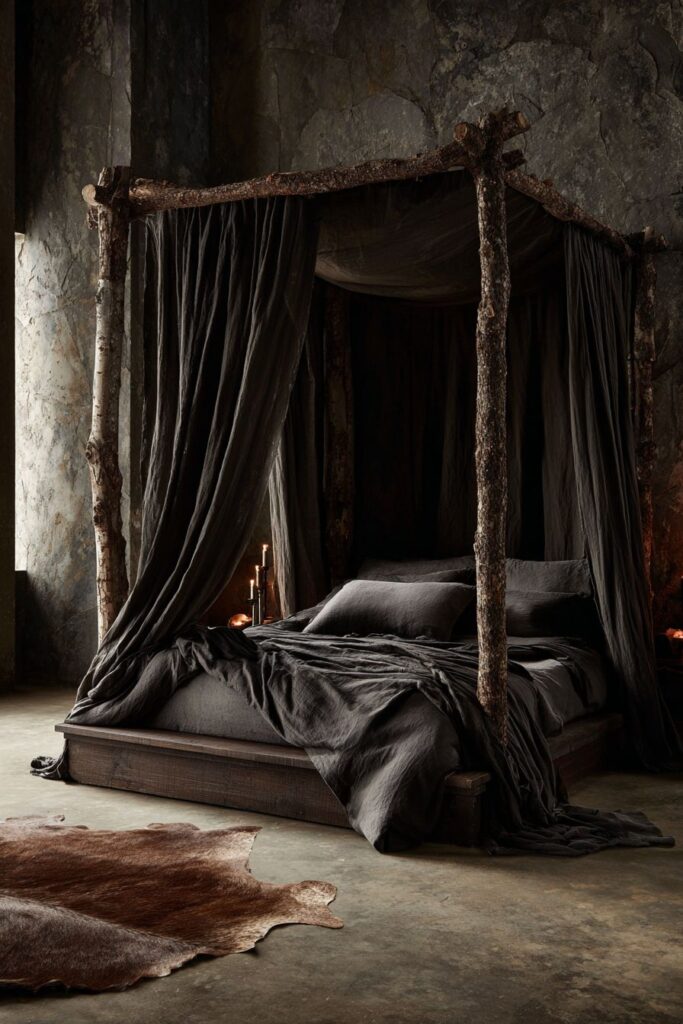
Key Design Tips:
- Select whole log posts for canopy beds to create organic, dramatic architectural presence
- Leave bark partially intact to celebrate the transition from tree to furniture
- Drape heavyweight linen to create intimate sleeping zones within larger spaces
- Pair organic wood forms with rough stone textures for complementary material contrast
- Position canopy beds to maximize morning light while maintaining evening intimacy
15. Textile Layering Masterclass
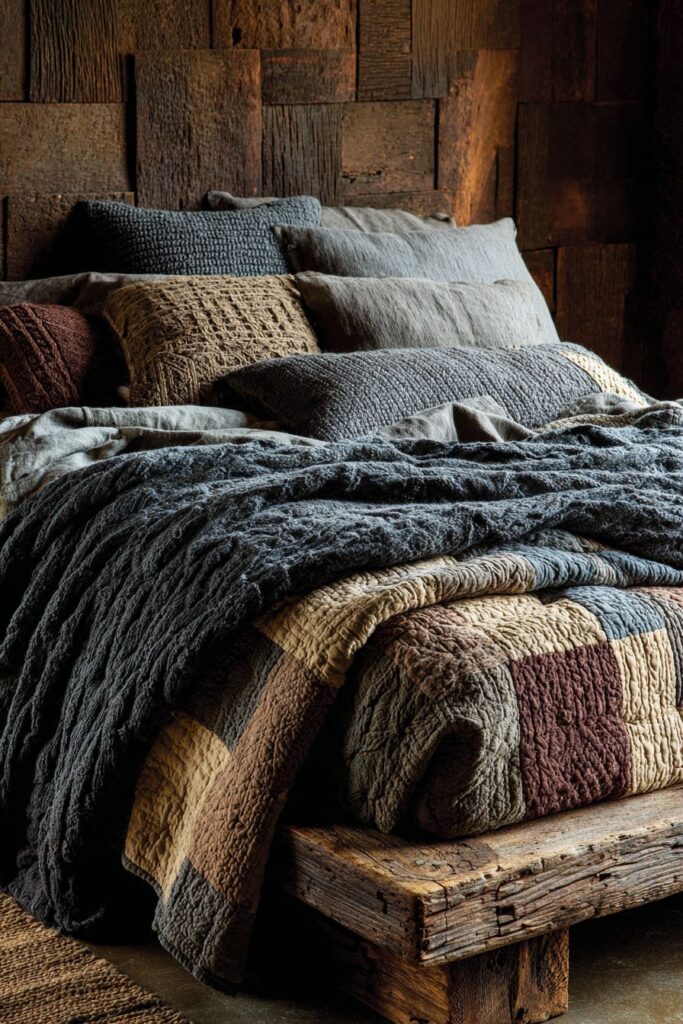
A bed dressed in multiple textures creates a masterclass in textile layering, beginning with a chunky cable-knit throw in charcoal that adds dimensional texture and visual weight. The cable knit pattern creates deep shadows and highlights that change with light conditions, its three-dimensional surface inviting touch while providing warmth. Beneath this substantial throw, wrinkled linen sheets in slate grey offer smooth, breathable comfort with the relaxed appearance that comes from natural fiber bedding. The deliberate wrinkles suggest lived-in comfort rather than hotel-crisp perfection, contributing to the room’s authentic, approachable aesthetic.
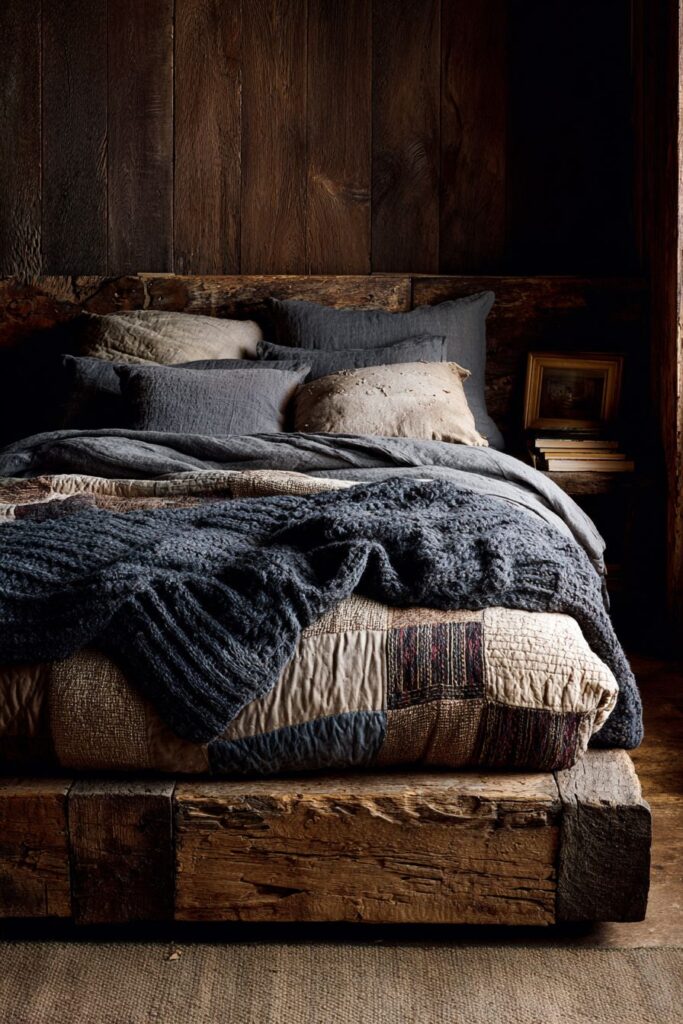
The layering continues with a vintage quilt in muted earth tones featuring visible hand-stitching that tells stories of craftsmanship and care. The hand-stitching—perhaps slightly irregular, showing the maker’s individual technique—adds human touch and historical depth to the bedding ensemble. The muted earth tones—perhaps sage green, rust orange, warm browns—introduce subtle color variation while maintaining harmony with the room’s overall palette. The quilt’s patterns, whether geometric or organic, add visual interest without overwhelming the composition.
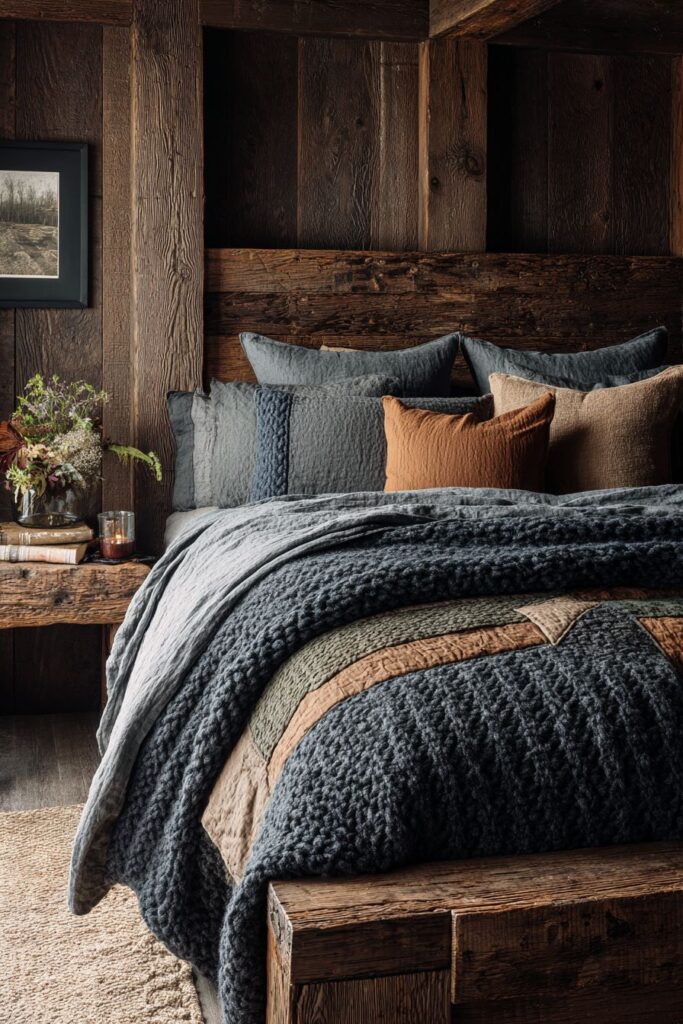
The bed frame constructed from weathered barn wood with a naturally dark patina provides the foundation for this textile display, its authentic aging complementing the layered fabrics above. Against walls finished in dark walnut wood paneling with visible grain, the layered textiles create visual interest through their varied textures and subtle color variations. The wood paneling’s visible grain pattern provides linear movement that contrasts with the organic draping of the textiles, creating dynamic tension that energizes the composition. Natural lighting emphasizes the tactile quality and authentic wear patterns of each textile layer, from the deep shadows in the cable knit to the soft sheen on the aged quilt.
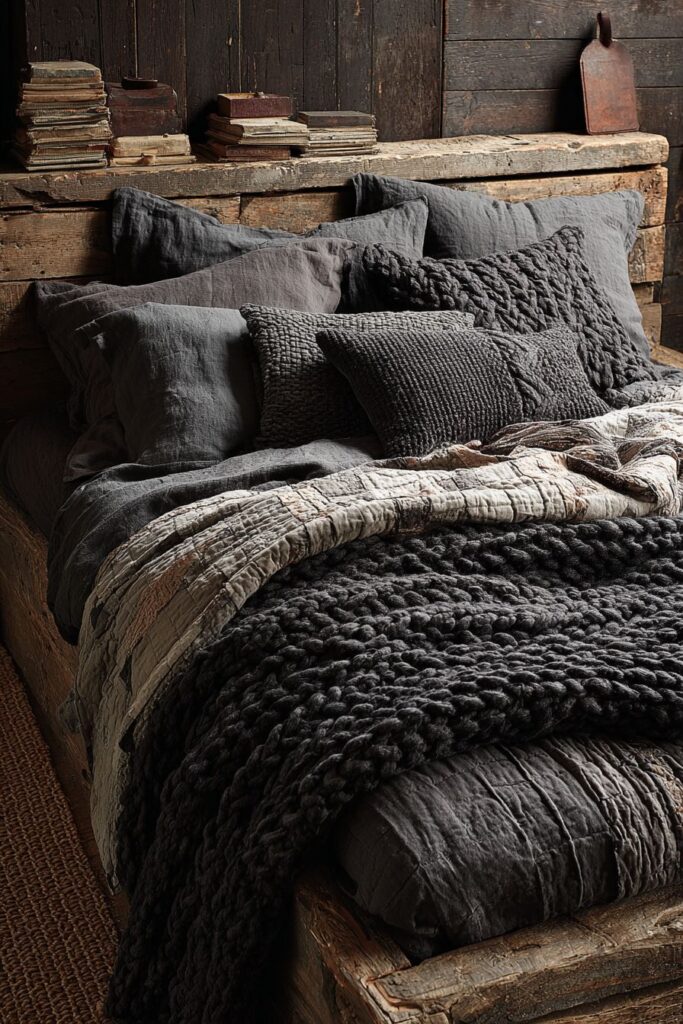
Key Design Tips:
- Layer textiles progressively from lightweight to heavyweight for visual depth
- Include handcrafted elements like cable knits and vintage quilts for authentic character
- Choose bedding with natural wrinkles to create lived-in, approachable atmosphere
- Position beds against wood-paneled walls for material continuity and warmth
- Use natural light to highlight textile textures and create shadow patterns
16. Leather Club Chair Lounge
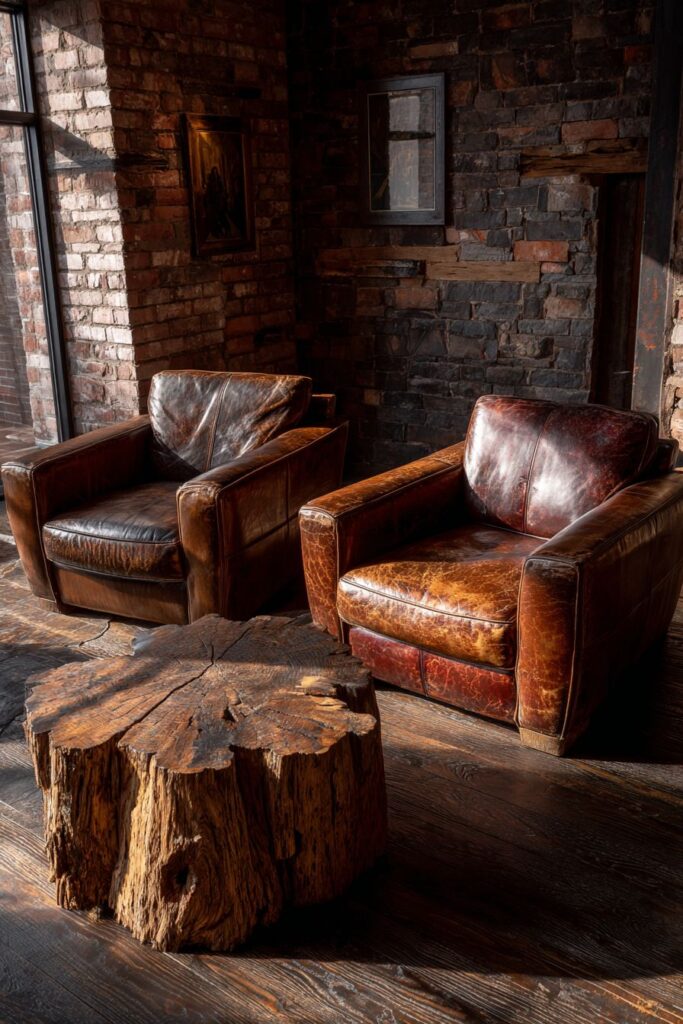
A pair of leather club chairs in deep tobacco brown with visible creasing and natural patina creates an inviting sitting area within the bedroom, their generous proportions suggesting comfort and relaxation. The deep tobacco brown leather adds warmth to the space while maintaining connection to the earth tones that characterize dark rustic design. Visible creasing speaks to quality leather that develops character through use, the natural fold patterns that emerge from sitting adding authenticity and lived-in appeal. The patina—slight color variations, areas of shine where hands have rested, subtle darkening where oils from skin have been absorbed—tells the story of years of use and care.
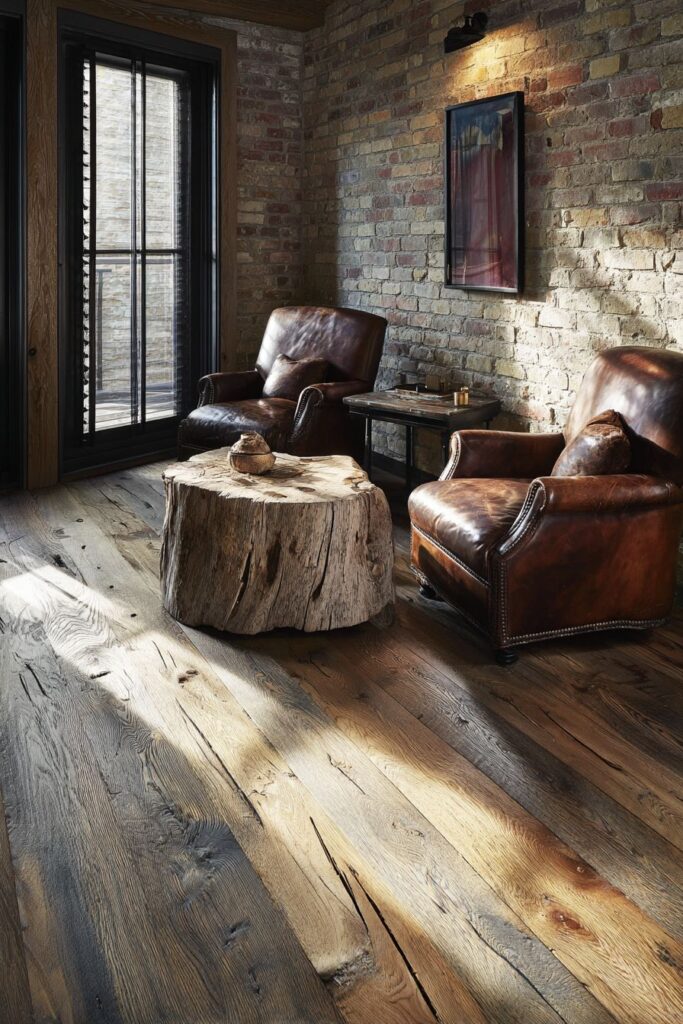
The chairs are positioned around a coffee table made from a massive tree stump cross-section with bark edge intact and dark stain finish, creating a conversation area that celebrates natural forms. The tree stump table brings the outdoors inside, its growth rings visible on the flat top surface telling the story of the tree’s life—years of growth, periods of drought, seasons of abundance all recorded in the concentric circles. The intact bark edge maintains connection to the tree’s original form while adding textural contrast to the smooth stained surface. The dark stain enriches the wood’s natural color while allowing the grain pattern and growth rings to remain visible.
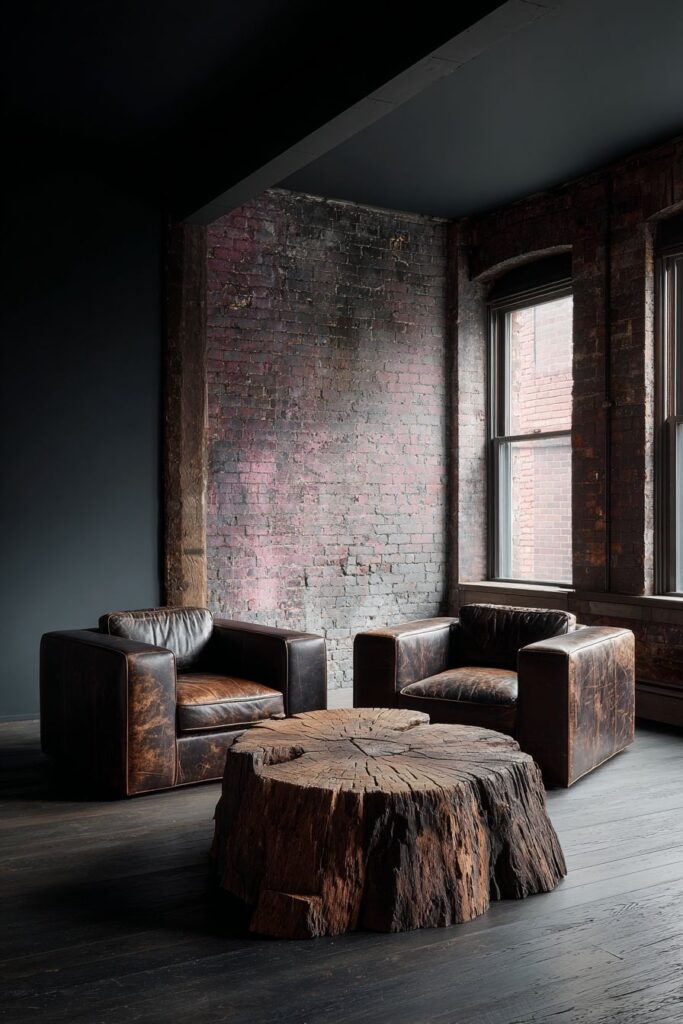
The floor beneath features wide-plank oak in espresso stain showing natural color variation, while exposed brick walls in charcoal and burgundy tones provide textural backdrop that adds urban sophistication to the rustic elements. The brick’s varied tones—from cool charcoal to warm burgundy—create depth and visual interest, while the mortar pattern adds geometric structure. Window light streaming in from the side creates dimensional shadows that highlight the genuine age and character of each piece, the raking light emphasizing the creases in the leather, the texture of the bark edge, and the irregular surface of the brick wall.
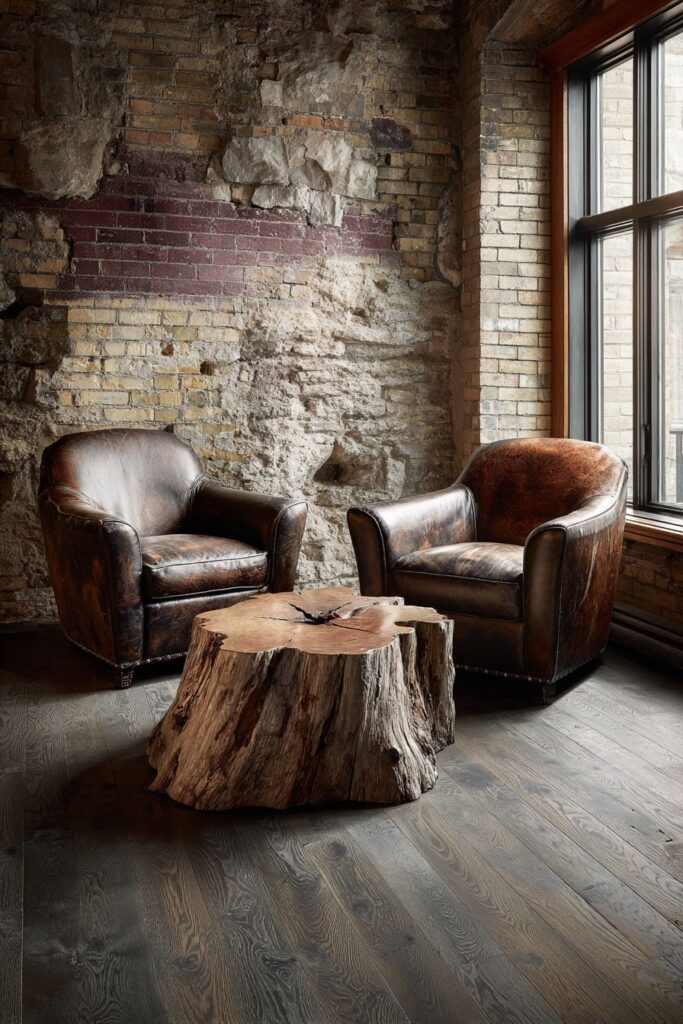
Key Design Tips:
- Select leather furniture with natural patina development rather than artificial aging
- Position seating groups to create conversation areas within larger bedroom spaces
- Use natural tree stumps as tables to bring organic forms and growth patterns into the design
- Maintain bark edges on natural wood pieces to celebrate original material forms
- Create side lighting conditions to emphasize texture and shadow patterns
17. Layered Wall Texture Gallery
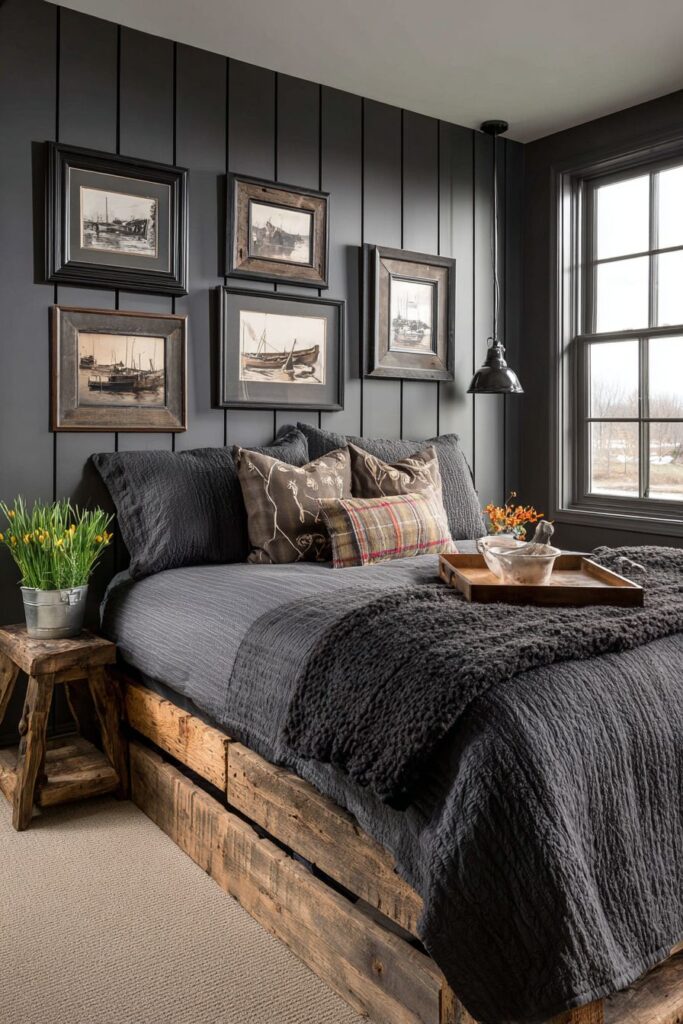
Vertical shiplap in a deep charcoal grey with subtle wood grain texture visible through the paint creates a dimensional wall surface that serves as backdrop for a carefully curated gallery wall. The vertical orientation of the shiplap creates linear movement that draws the eye upward, emphasizing ceiling height while adding architectural interest through the shadow lines between boards. The deep charcoal grey provides a sophisticated neutral that allows artwork to pop while maintaining the room’s dark rustic aesthetic. The subtle wood grain visible through the paint finish prevents the wall from appearing flat or lifeless, adding organic texture that connects to the room’s natural material palette.

Mounted on this dramatic backdrop is a gallery wall of vintage black and white photographs in mismatched dark wooden frames with authentic distressing. Each photograph tells its own story—perhaps family portraits from decades past, architectural studies, landscape scenes—while the collection as a whole creates visual narrative about memory, history, and curated living. The mismatched frames add to the collected-over-time appearance, their varied sizes, profiles, and distressing patterns suggesting pieces gathered from different sources and periods. The dark wooden frames harmonize with the charcoal wall while providing definition that allows each photograph to maintain its individual presence.
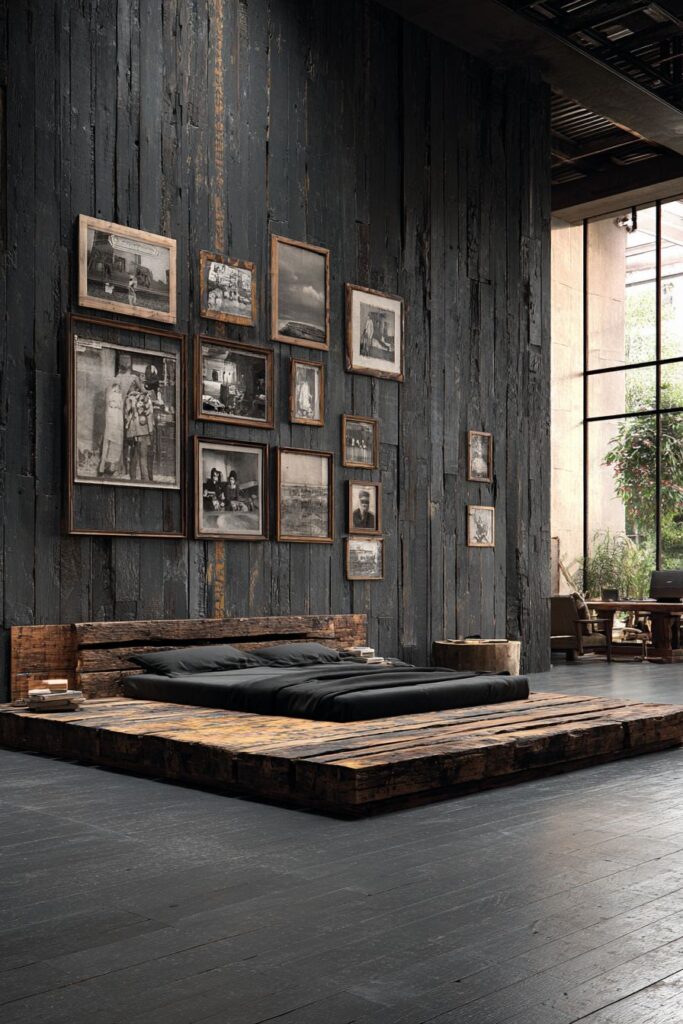
A low platform bed with a headboard made from horizontal reclaimed planks continues the wood theme while providing horizontal counterpoint to the vertical shiplap. The reclaimed planks showcase varied weathering, grain patterns, and perhaps traces of original finishes that add character and depth. The low profile maintains a sense of spaciousness in the room while allowing the gallery wall to command attention without competition from tall furniture. Natural light from a nearby window creates subtle highlights on the dimensional wall surface, the changing light conditions throughout the day revealing different aspects of the shiplap’s texture and the photographs’ tonal ranges.
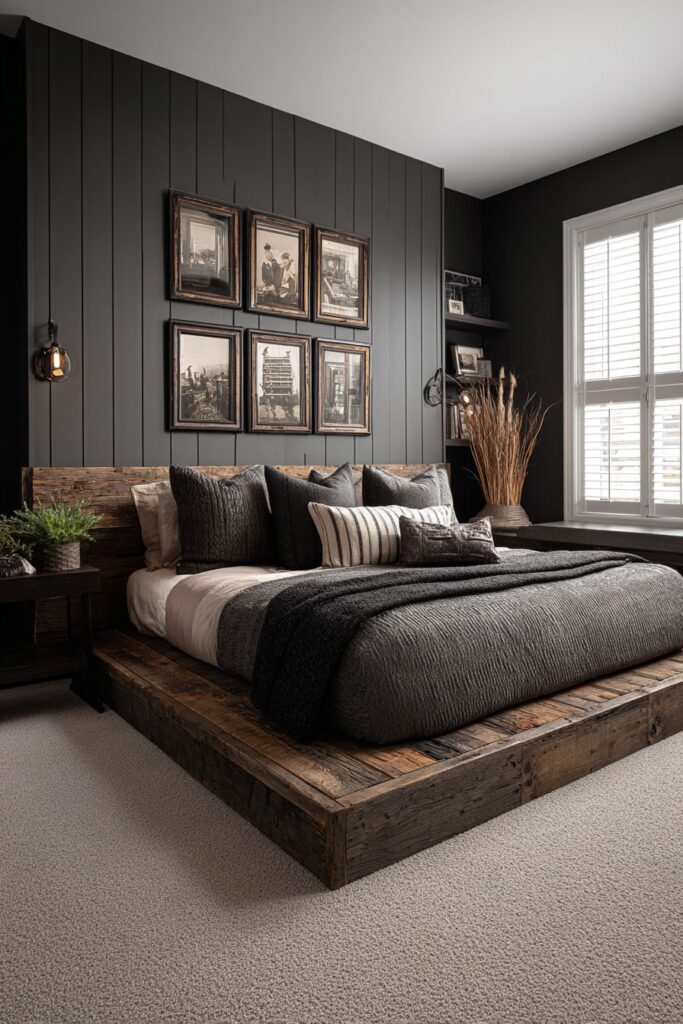
Key Design Tips:
- Install vertical shiplap to add linear movement and architectural interest to walls
- Create gallery walls using mismatched vintage frames for collected, authentic appearance
- Select artwork that harmonizes with wall colors while maintaining visual distinction
- Build headboards from horizontal planks to create directional contrast with vertical wall treatments
- Position beds near windows to benefit from natural light without creating glare on artwork
18. Industrial-Rustic Fusion
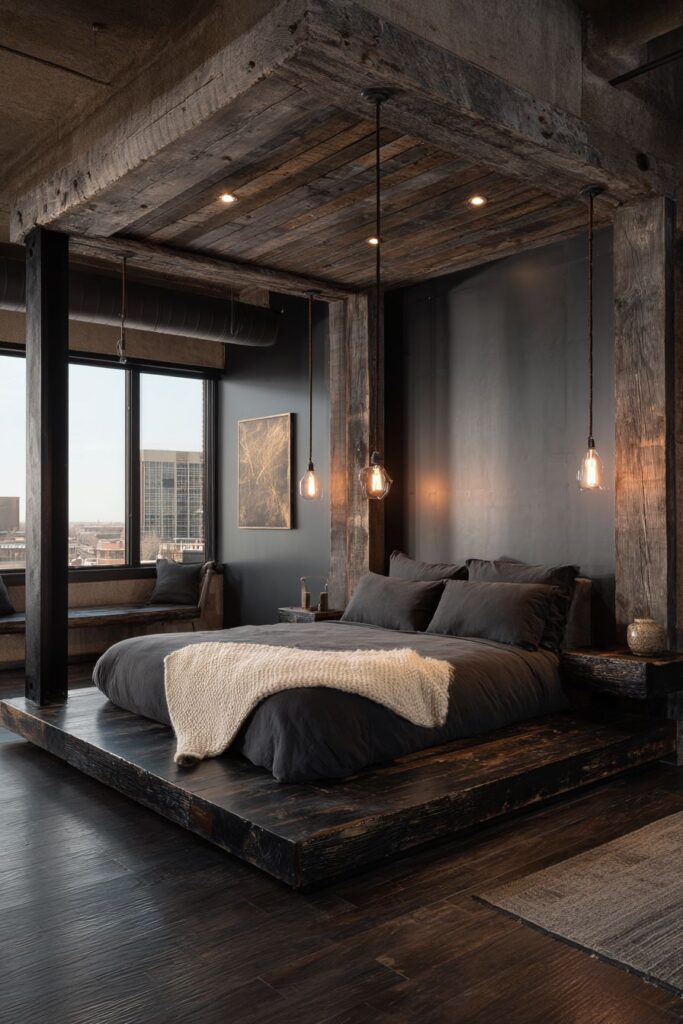
A bed frame welded from black iron pipes supporting a platform of thick reclaimed wood planks in dark stain creates a striking fusion of industrial and rustic design sensibilities. The black iron pipe framework displays the mechanical beauty of exposed joints, flanges, and straight runs, its industrial origins celebrated rather than hidden. The welded connections show skilled craftsmanship, creating strong, permanent joints that support the substantial wood platform above. The thick reclaimed wood planks provide sleeping surface support while adding natural warmth and texture that softens the harder-edged industrial elements.
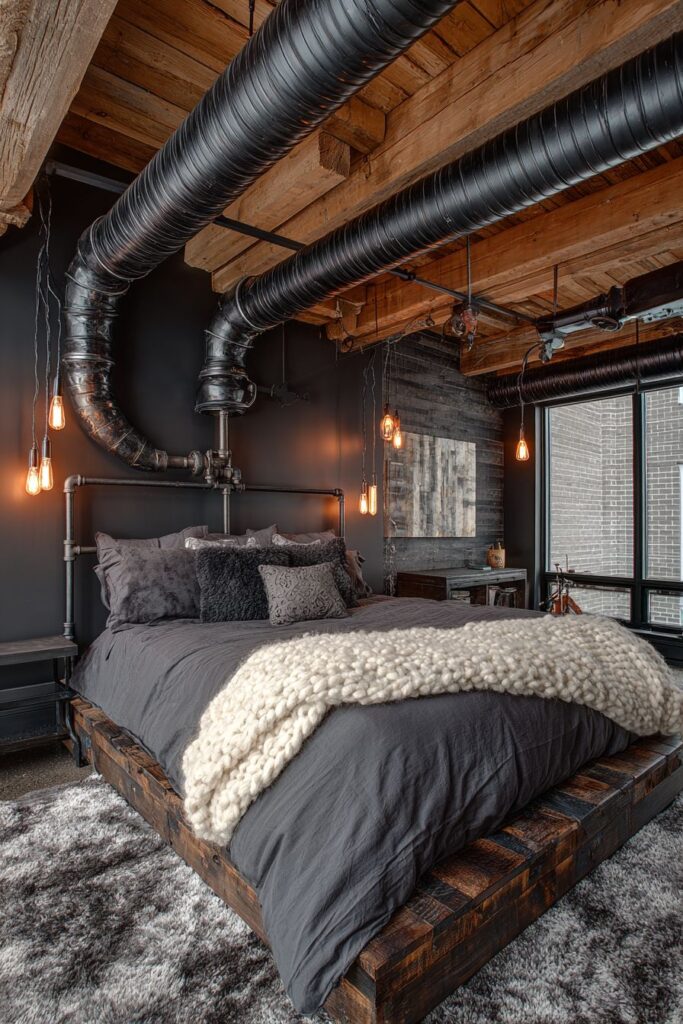
Bedding in charcoal linen provides sophisticated simplicity, its natural fiber and relaxed draping complementing both the industrial framework and rustic wood platform. The charcoal tone maintains color continuity while the linen’s subtle texture and natural wrinkles add softness essential to comfortable sleeping spaces. A chunky cream wool throw draped across the foot of the bed provides textural and color contrast, its thick weave and lighter tone creating visual interest while offering warmth on cooler nights.
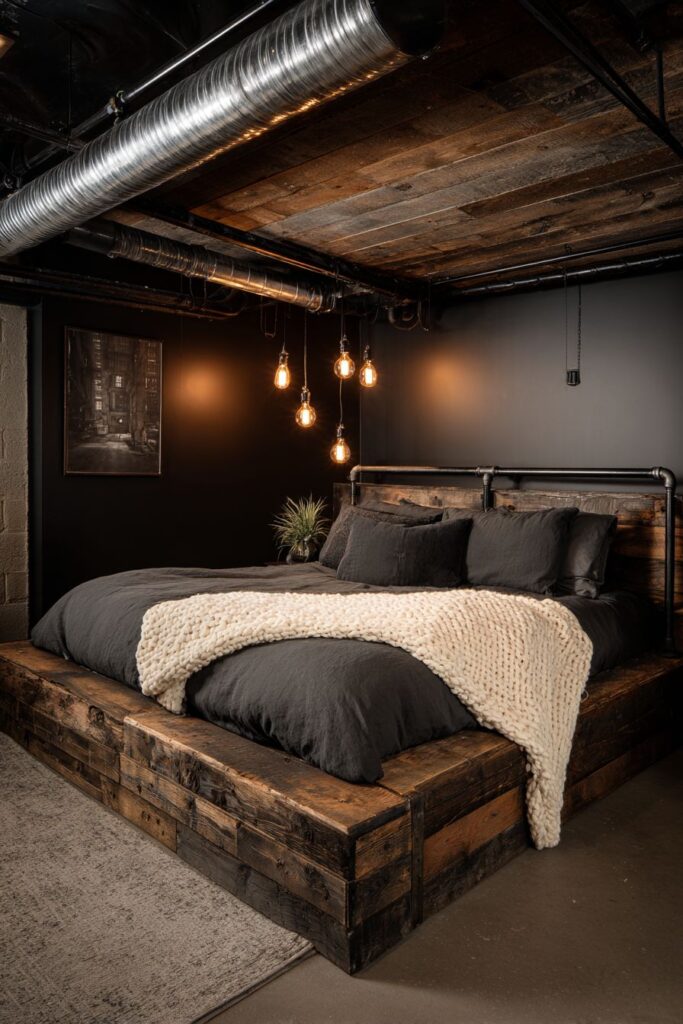
The ceiling features exposed ductwork painted matte black alongside rough-hewn timber beams in natural dark finish, creating overhead drama that reinforces the industrial-rustic fusion. The exposed ductwork, often hidden in conventional design, becomes an architectural feature when painted to harmonize with the overall aesthetic. The rough-hewn timber beams provide organic counterpoint to the mechanical ductwork, their irregular surfaces and natural imperfections contrasting with the geometric precision of metal ducts. Edison bulb pendant lights on black cord provide warm ambient lighting, their visible filaments creating focal points of warm light that humanize the space and add vintage industrial character.
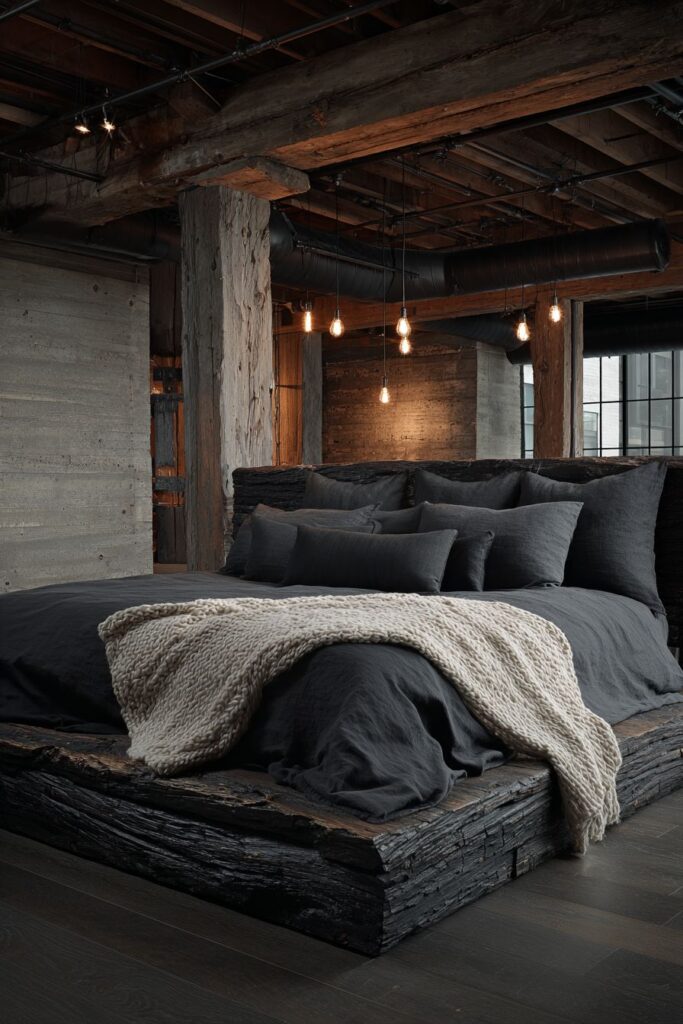
Key Design Tips:
- Weld iron pipe bed frames for industrial structure that supports rustic wood platforms
- Paint exposed mechanical systems to integrate them as intentional design elements
- Balance industrial materials with organic wood elements to prevent cold, sterile atmosphere
- Install Edison bulb lighting to add warmth and visible technology as decorative feature
- Layer soft textiles to add necessary warmth and comfort to harder industrial materials
19. Window Alcove Stone Detail
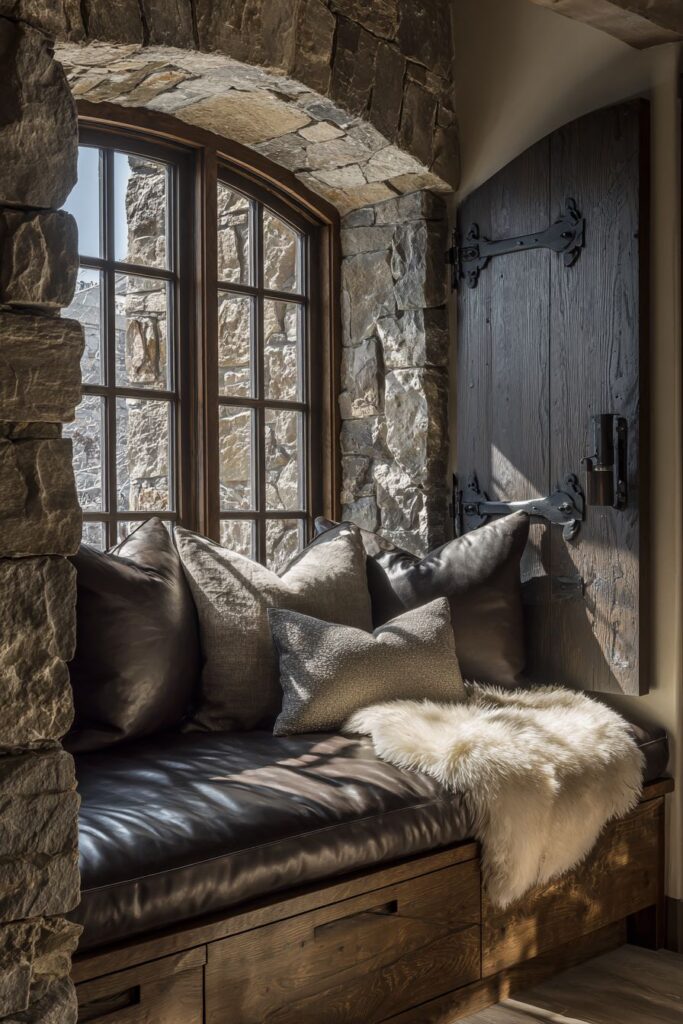
A window alcove with deep-set placement in thick stone walls showing natural grey and charcoal tones with visible mortar texture creates an architectural feature of remarkable depth and character. The thick stone walls—perhaps two feet or more in depth—create a dramatic reveal that emphasizes the solid, permanent nature of the construction. Each stone displays unique geological characteristics, from color variations to surface texture to natural fracture patterns, while the mortar between stones adds structural necessity that becomes aesthetic feature through its visible presence and textural contrast.
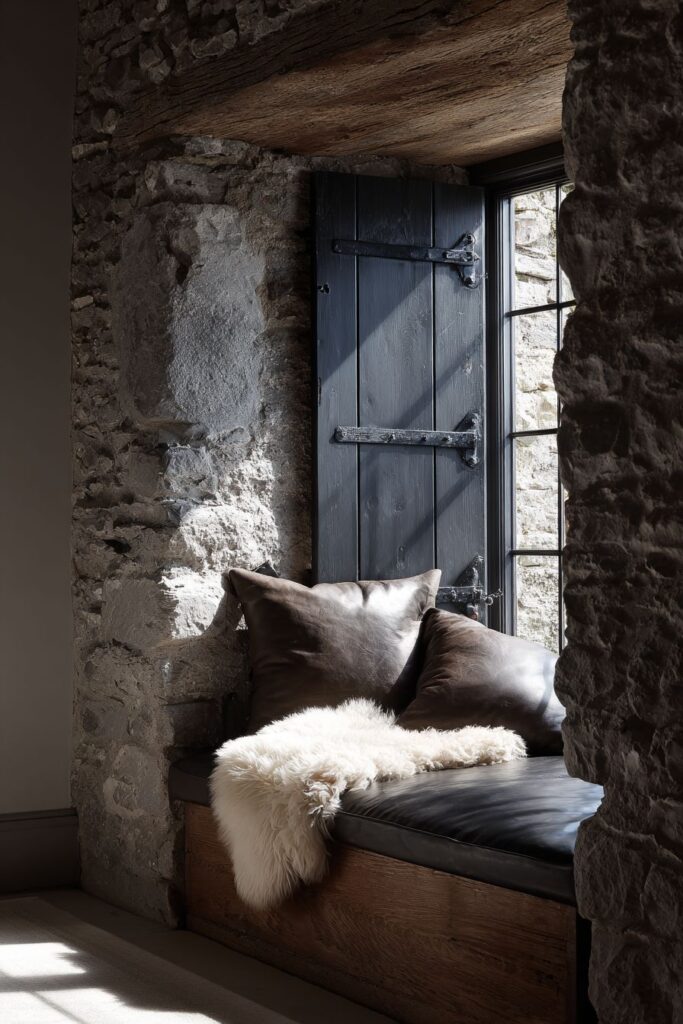
The window seat features a cushion in dark leather with visible grain and natural creasing that has developed through use, providing comfortable seating for reading, contemplation, or simply enjoying the view. The dark leather harmonizes with the stone tones while adding warmth and organic texture. The visible grain and natural creasing speak to quality leather that develops character rather than degrading with age, each mark telling stories of moments spent in repose. Heavy wooden shutters in espresso stain with hand-forged iron hinges frame the window, providing options for light control and privacy while adding additional layers of natural material and traditional craftsmanship.
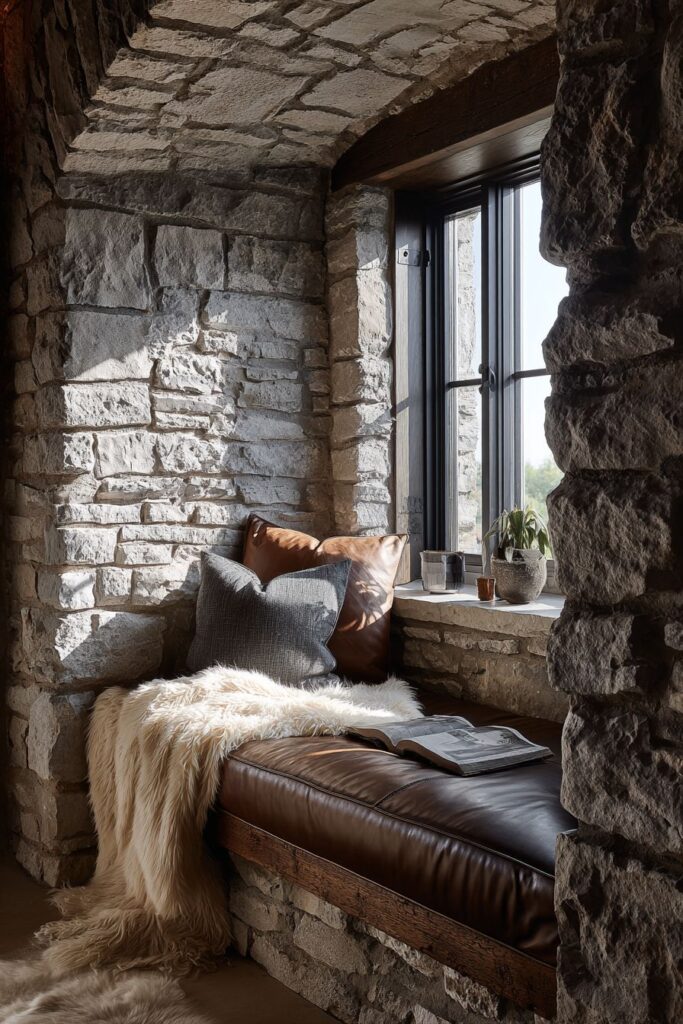
A sheepskin throw in natural cream provides textural contrast against the darker elements, its soft, luxurious pile inviting touch while adding visual lightness to the composition. The natural cream tone creates highlight within the generally dark palette, drawing attention to the window seat as an inviting destination within the room. Natural daylight streams through the window, creating dramatic light and shadow play that changes throughout the day—morning light creating sharp geometric patterns, afternoon sun warming the stone and leather, evening light casting long shadows that emphasize the alcove’s depth and the stones’ three-dimensional texture.
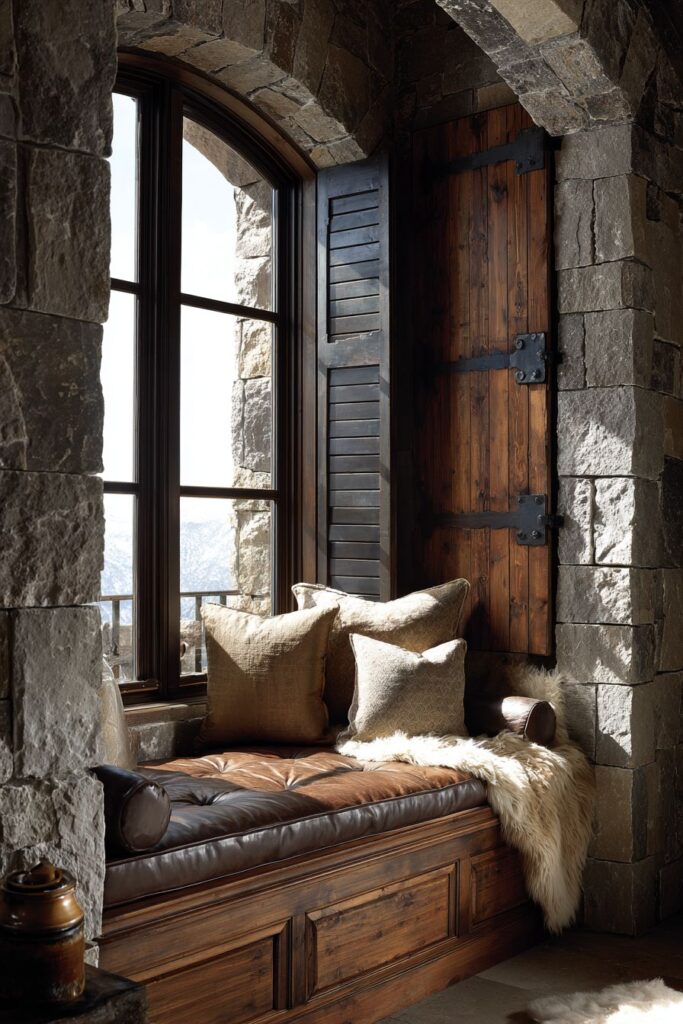
Key Design Tips:
- Create deep window reveals in stone walls to emphasize material thickness and permanence
- Install window seats in alcoves to create intimate spaces for reading and contemplation
- Use dark leather cushions for seating that develops character through natural aging
- Add cream or white textiles as highlights within predominantly dark color schemes
- Design shutters with hand-forged hardware to combine function with artisanal detail
20. Master Suite Statement Wall
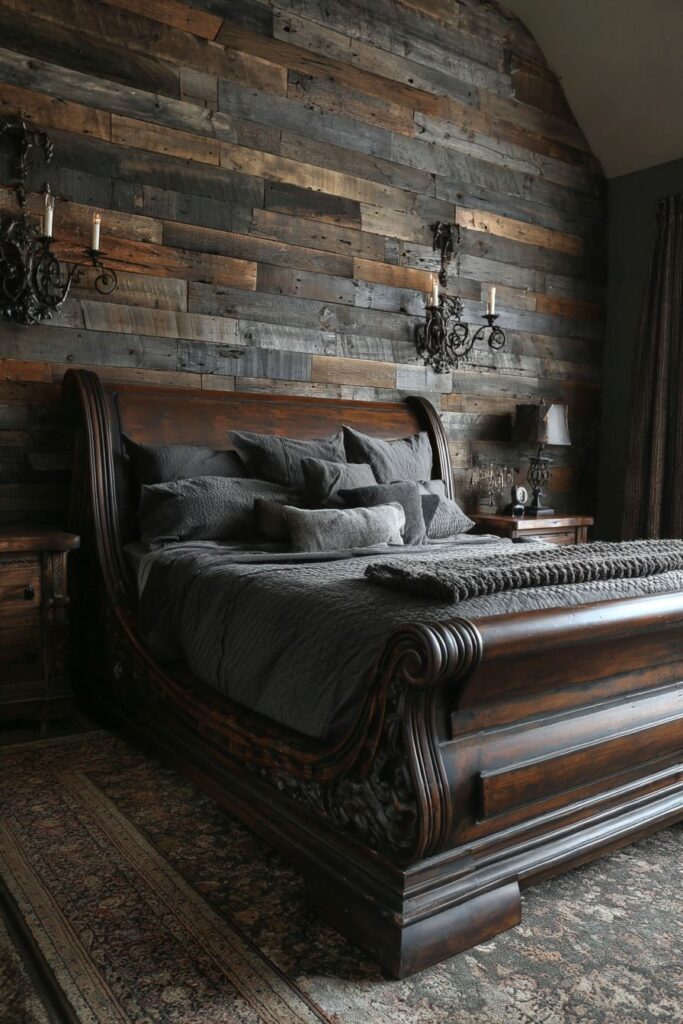
A statement wall clad in reclaimed barn siding with varied dark brown and grey weathered planks showing authentic nail holes, age cracks, and natural patina creates a powerful focal point in this master suite. Each plank tells its own story through weathering patterns—areas where sun exposure lightened the wood, rain created grey tones, and age brought deep brown oxidation. The authentic nail holes mark where boards were originally attached to barn structures, while age cracks follow the wood grain as the timber dried and settled over decades. This authentic patina cannot be replicated through artificial aging; it requires genuine history and time to develop such rich, complex surface character.
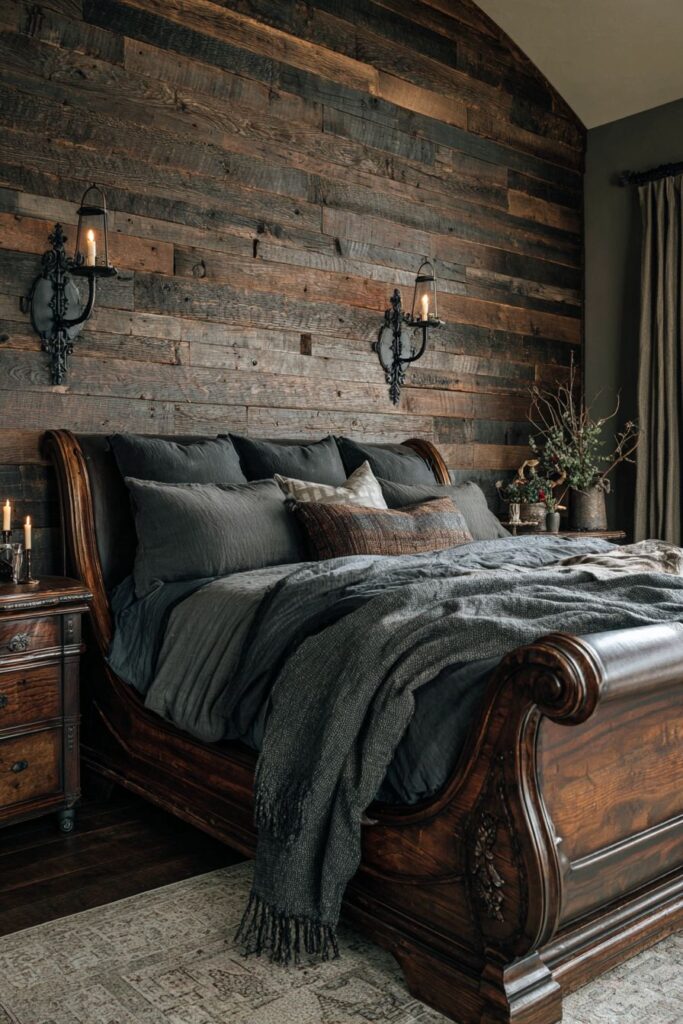
Against this dramatic backdrop sits a massive sleigh bed crafted from solid timber with hand-carved details and dark walnut finish. The sleigh design, with its characteristic curved headboard and footboard, adds graceful lines that contrast with the linear barn siding behind it. Hand-carved details—perhaps rope motifs, leaf patterns, or geometric designs—showcase traditional woodworking skills while adding visual interest that rewards closer inspection. The dark walnut finish provides rich, luxurious color that complements the varied tones in the barn siding while maintaining distinction as a separate design element.
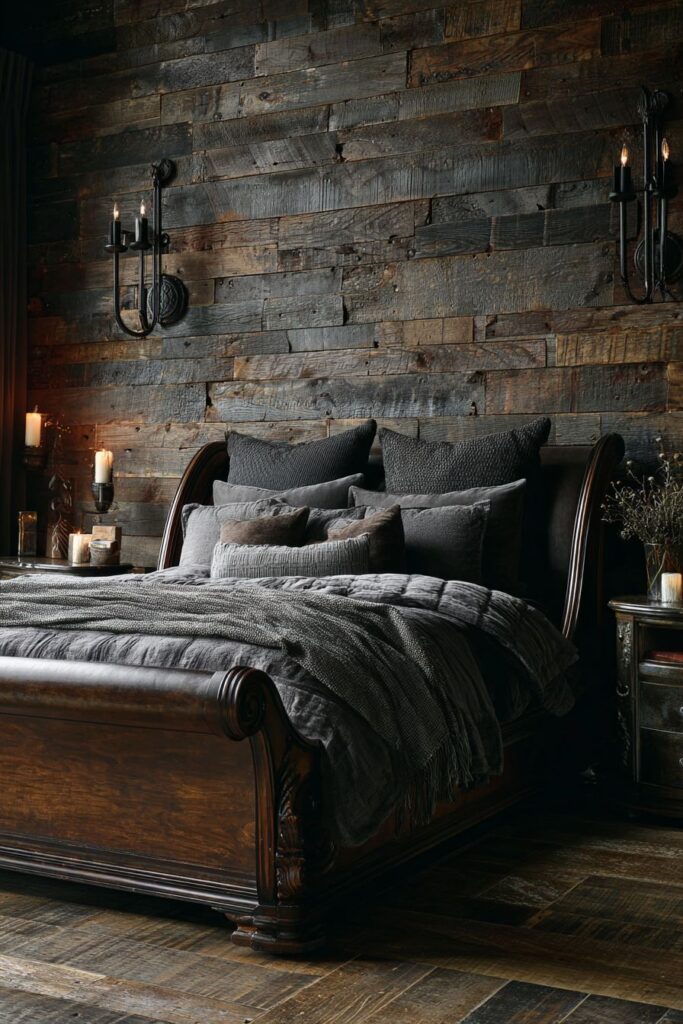
Antique wrought iron wall sconces with aged bronze finish flank the bed, their warm metallic tones adding another layer to the material palette. The aged bronze finish suggests decades of use, its warm, slightly muted tone providing softer alternative to bright new metal. The sconces provide functional bedside lighting while contributing to the room’s collected, layered aesthetic. Layered bedding includes vintage wool blankets and linen in deep charcoal tones, creating a sophisticated monochromatic scheme within the darker palette. Balanced natural and artificial lighting captures the room’s depth, emphasizing material authenticity and the sophisticated use of dark tones to create an intimate, restful atmosphere perfect for the sanctuary of sleep.
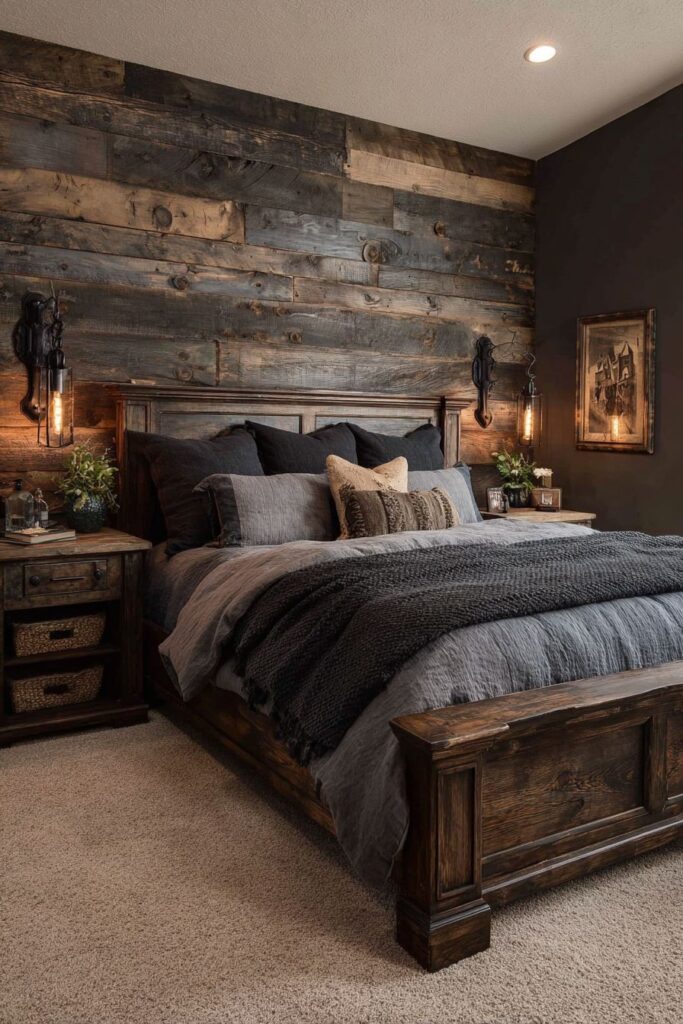
Key Design Tips:
- Install reclaimed barn siding as statement walls to showcase authentic weathering and history
- Select sleigh beds with hand-carved details for traditional elegance within rustic spaces
- Flank beds with wrought iron sconces in aged finishes for symmetrical, functional lighting
- Layer vintage textiles with contemporary linens for depth within monochromatic schemes
- Balance natural daylight with warm artificial lighting to maintain intimacy while preventing darkness
Why These Dark Rustic Bedroom Designs Represent the Best in Contemporary Interior Design
The twenty dark rustic bedroom designs presented throughout this comprehensive guide represent the pinnacle of thoughtful, authentic interior design that honors both traditional craftsmanship and contemporary living requirements. These spaces succeed because they embrace the inherent beauty of natural materials in their most honest forms—reclaimed barn wood with its authentic weathering, hand-forged iron with its subtle irregularities, and natural stone displaying millions of years of geological formation. Unlike trends that prioritize surface-level aesthetics, dark rustic bedrooms celebrate material authenticity and the stories that genuine age and use inscribe upon furnishings and finishes.
The dark color palettes employed across these designs create psychological benefits that extend far beyond visual appeal. Deep charcoal greys, rich walnut stains, and espresso wood finishes create cocooning atmospheres that promote relaxation and restorative sleep. Color psychology research consistently demonstrates that darker tones in sleeping spaces help regulate circadian rhythms and create the sense of security essential for deep rest. These moody bedrooms leverage this understanding, using dark rustic aesthetics not merely for style but for the profound impact on wellbeing and sleep quality. The sophisticated layering of dark tones—from charcoal walls to deep brown furniture to slate grey textiles—creates visual depth that prevents the monotony sometimes associated with lighter, more minimalist approaches.
Texture layering emerges as a crucial element across all featured designs, with each space showcasing how varied surface treatments create richness and sensory engagement. The combination of rough-hewn timber beams, smooth linen bedding, nubby cable-knit throws, and aged leather upholstery creates tactile experiences that invite interaction and contribute to the lived-in, welcoming quality these rooms embody. This attention to textural variety ensures spaces remain visually interesting from multiple viewing distances—dramatic from across the room through bold material contrasts, rewarding upon closer inspection through subtle surface details like wood grain patterns, metal patinas, and fabric weaves.
The integration of vintage and antique elements throughout these dark rustic bedrooms adds layers of narrative and historical depth impossible to achieve with purely contemporary furnishings. Reclaimed materials—whether barn wood bed frames, railroad tie side tables, or vintage steamer trunk nightstands—bring stories of previous lives and uses into the intimate space of the bedroom. This connection to history and craftsmanship creates spaces that feel grounded in something larger than fleeting trends, offering the permanence and authenticity that contemporary homeowners increasingly seek as antidotes to mass-produced, disposable consumer culture.
Lighting design proves crucial in successful dark rustic bedrooms, with each featured space demonstrating sophisticated approaches to balancing natural and artificial illumination. The layering of multiple light sources—wrought iron chandeliers, Edison bulb pendants, vintage task lamps, and flickering fireplaces—creates flexible lighting schemes that adapt to different activities and times of day. This nuanced approach prevents dark spaces from feeling oppressive while maintaining the atmospheric quality essential to the aesthetic. Natural light, whether streaming through gauze curtains or creating dramatic plays of light and shadow through multi-pane windows, adds dynamic quality that ensures spaces change character throughout the day.
The architectural elements incorporated across these designs—from exposed ceiling beams and stone fireplace surrounds to built-in shelving and window alcoves—demonstrate how dark rustic aesthetics benefit from structural features that add permanence and character. These architectural details transform bedrooms from mere furniture arrangements into cohesive environments where every element contributes to the overall narrative. The use of authentic construction techniques—visible mortar in stone walls, hand-forged metal hardware, traditional joinery in wood furniture—adds credibility and depth that cannot be achieved through surface treatments alone.
Spatial planning in these dark rustic bedrooms shows sophisticated understanding of how to create multiple functional zones within sleeping quarters. Reading nooks with weathered leather chairs, integrated workspaces with reclaimed wood desks, intimate sitting areas with club chairs around natural wood coffee tables—these designated areas transform bedrooms from single-purpose sleeping spaces into multi-functional personal retreats. This approach acknowledges contemporary living patterns where bedrooms serve as private sanctuaries for various activities beyond sleep, from work and reading to meditation and conversation.
The material authenticity emphasized throughout these designs reflects broader cultural shifts toward sustainability and conscious consumption. By featuring reclaimed barn wood, salvaged industrial materials, and vintage furnishings, these bedrooms demonstrate how beautiful, luxurious spaces can be created through responsible material choices. This approach reduces environmental impact while creating interiors with genuine character and soul—spaces that honor the craftsmanship and materials of the past while serving the needs of contemporary life.
Color theory application across these dark rustic bedrooms demonstrates masterful understanding of how to work with deeper tones without creating spaces that feel heavy or oppressive. The strategic use of varied dark tones—mixing warm browns with cool greys, deep charcoals with rich burgundies—creates visual interest and depth within the darker palette. Occasional lighter accents—cream wool throws, natural cowhide rugs, white-washed ceiling boards—provide necessary contrast and prevent visual fatigue while maintaining the overall dark rustic aesthetic. This sophisticated color approach creates rooms that feel rich and enveloping rather than dark and cramped.
The emphasis on handcrafted details—from hand-carved bed frames and hand-forged iron hardware to hand-scraped floors and visible tool marks—celebrates human craftsmanship in an increasingly automated world. These details add warmth and individuality, ensuring each space feels unique and personal rather than generic or formulaic. The slight irregularities and variations that come from handwork add authenticity and charm that machine-made perfection cannot replicate, creating spaces with genuine soul and character.
Textile choices across these designs demonstrate understanding of how fabric selection impacts both aesthetics and comfort. The preference for natural fibers—linen, wool, cotton, leather—ensures breathability and comfort while maintaining connection to organic materials that define rustic design. The layering of varied textiles—from chunky cable knits to wrinkled linen sheets to vintage quilts—creates visual richness while addressing practical needs for warmth and comfort across different seasons.
The integration of industrial elements in several designs demonstrates how dark rustic aesthetics can evolve beyond purely traditional approaches. The combination of weathered wood with black iron pipes, exposed ductwork with rough timber beams, creates hybrid spaces that feel both grounded in history and relevant to contemporary aesthetics. This fusion approach expands the possibilities of dark rustic design while maintaining the core principles of material authenticity and crafted detail.
These dark rustic bedroom designs ultimately succeed because they create emotionally resonant spaces that address fundamental human needs for security, comfort, and beauty. The cocooning quality of dark tones, the authenticity of aged materials, the warmth of natural wood and textiles—all combine to create bedrooms that feel like true sanctuaries from the demands and stresses of modern life. In an era of constant digital connection and rapid change, these thoughtfully designed dark rustic bedrooms offer the permanence, authenticity, and restorative quiet essential for genuine wellbeing and restful sleep.
Conclusion
The journey through these twenty dark rustic bedroom designs reveals the remarkable versatility and enduring appeal of this sophisticated aesthetic approach. From dramatic four-poster beds crafted from rough-hewn timber to intimate reading nooks bathed in atmospheric shadow, each space demonstrates how thoughtful material selection, authentic aging, and layered lighting can transform bedrooms into deeply personal sanctuaries. The dark rustic style succeeds not through following rigid formulas but through understanding core principles—celebrating material authenticity, embracing imperfection, creating textural depth, and designing for emotional resonance.
As you consider incorporating these ideas into your own bedroom, remember that successful dark rustic design emerges from genuine appreciation for craftsmanship, history, and natural materials rather than mere aesthetic preference. Start with a single element that resonates deeply—perhaps a reclaimed wood headboard, a vintage leather chair, or hand-forged lighting fixtures—and build your design organically around that anchor piece. Allow the space to evolve over time, adding layers of texture and meaning through carefully selected vintage finds and handcrafted elements that tell your personal story.
The beauty of dark rustic bedroom design lies in its accessibility to various budgets and skill levels. Whether investing in custom-built furniture or creatively repurposing architectural salvage finds, whether commissioning artisan metalwork or refinishing flea market treasures, opportunities abound for creating authentic, characterful spaces. Embrace the imperfections, celebrate the history embedded in aged materials, and trust that spaces designed with genuine materials and thoughtful intention will provide the restorative environment essential for restful sleep and personal rejuvenation. Your bedroom awaits transformation into a dark rustic retreat that honors both timeless craftsmanship and your unique vision of comfort and beauty.
